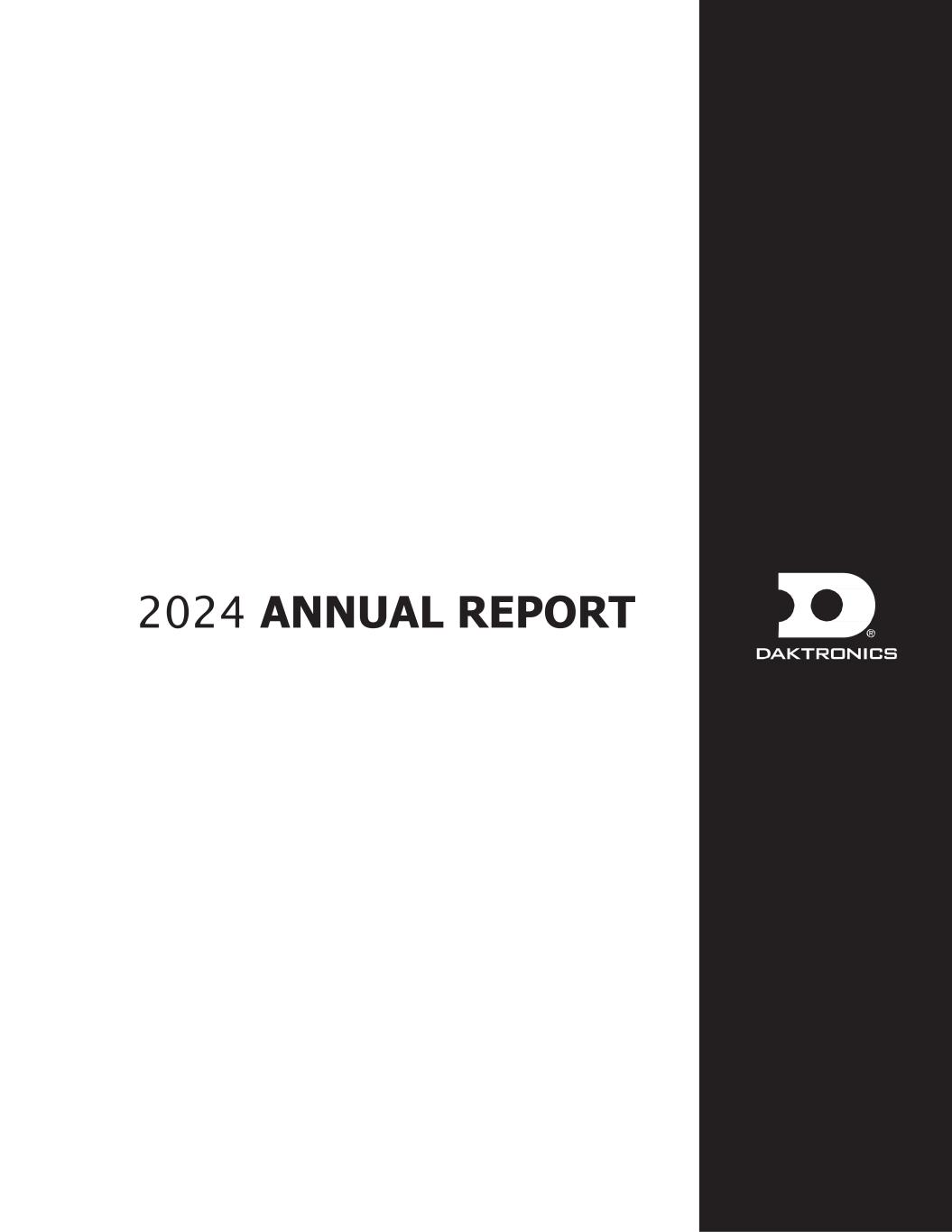
20 4 ANNUAL REPORT

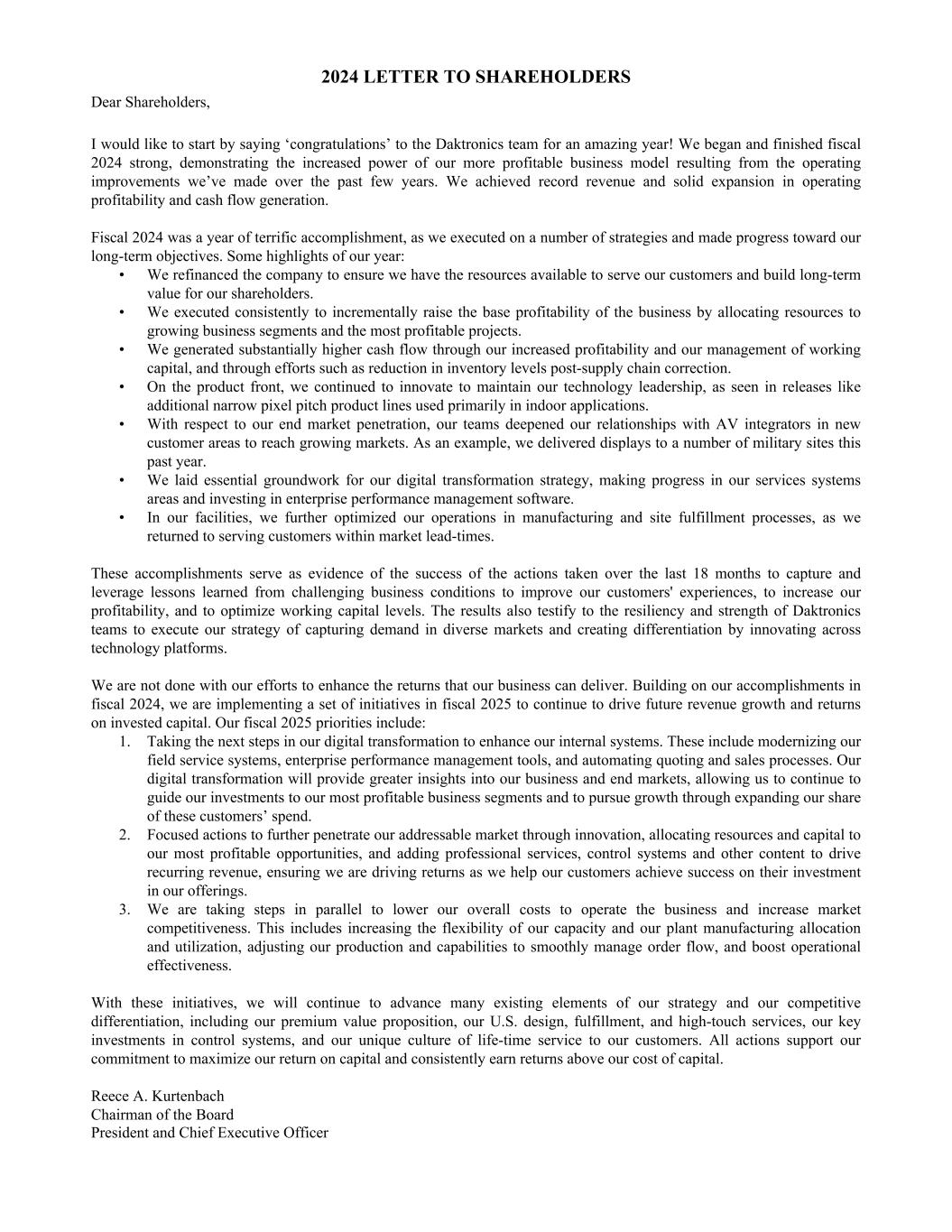
2024 LETTER TO SHAREHOLDERS Dear Shareholders, I would like to start by saying ‘congratulations’ to the Daktronics team for an amazing year! We began and finished fiscal 2024 strong, demonstrating the increased power of our more profitable business model resulting from the operating improvements we’ve made over the past few years. We achieved record revenue and solid expansion in operating profitability and cash flow generation. Fiscal 2024 was a year of terrific accomplishment, as we executed on a number of strategies and made progress toward our long-term objectives. Some highlights of our year: • We refinanced the company to ensure we have the resources available to serve our customers and build long-term value for our shareholders. • We executed consistently to incrementally raise the base profitability of the business by allocating resources to growing business segments and the most profitable projects. • We generated substantially higher cash flow through our increased profitability and our management of working capital, and through efforts such as reduction in inventory levels post-supply chain correction. • On the product front, we continued to innovate to maintain our technology leadership, as seen in releases like additional narrow pixel pitch product lines used primarily in indoor applications. • With respect to our end market penetration, our teams deepened our relationships with AV integrators in new customer areas to reach growing markets. As an example, we delivered displays to a number of military sites this past year. • We laid essential groundwork for our digital transformation strategy, making progress in our services systems areas and investing in enterprise performance management software. • In our facilities, we further optimized our operations in manufacturing and site fulfillment processes, as we returned to serving customers within market lead-times. These accomplishments serve as evidence of the success of the actions taken over the last 18 months to capture and leverage lessons learned from challenging business conditions to improve our customers' experiences, to increase our profitability, and to optimize working capital levels. The results also testify to the resiliency and strength of Daktronics teams to execute our strategy of capturing demand in diverse markets and creating differentiation by innovating across technology platforms. We are not done with our efforts to enhance the returns that our business can deliver. Building on our accomplishments in fiscal 2024, we are implementing a set of initiatives in fiscal 2025 to continue to drive future revenue growth and returns on invested capital. Our fiscal 2025 priorities include: 1. Taking the next steps in our digital transformation to enhance our internal systems. These include modernizing our field service systems, enterprise performance management tools, and automating quoting and sales processes. Our digital transformation will provide greater insights into our business and end markets, allowing us to continue to guide our investments to our most profitable business segments and to pursue growth through expanding our share of these customers’ spend. 2. Focused actions to further penetrate our addressable market through innovation, allocating resources and capital to our most profitable opportunities, and adding professional services, control systems and other content to drive recurring revenue, ensuring we are driving returns as we help our customers achieve success on their investment in our offerings. 3. We are taking steps in parallel to lower our overall costs to operate the business and increase market competitiveness. This includes increasing the flexibility of our capacity and our plant manufacturing allocation and utilization, adjusting our production and capabilities to smoothly manage order flow, and boost operational effectiveness. With these initiatives, we will continue to advance many existing elements of our strategy and our competitive differentiation, including our premium value proposition, our U.S. design, fulfillment, and high-touch services, our key investments in control systems, and our unique culture of life-time service to our customers. All actions support our commitment to maximize our return on capital and consistently earn returns above our cost of capital. Reece A. Kurtenbach Chairman of the Board President and Chief Executive Officer

(This page has been left blank intentionally.)

FINANCIAL HIGHLIGHTS Daktronics, Inc. and its subsidiaries are an industry leader in designing and manufacturing electronic scoreboards, programmable display systems and large screen video displays for sporting, commercial and transportation applications. We serve our customers by providing the highest quality standard display products as well as custom-designed and integrated systems. We offer a complete line of products, from small scoreboards and electronic displays to large multimillion-dollar video display systems as well as related control, timing, and sound systems. We are recognized as a technical leader with the capabilities to design, market, manufacture, install and service complete integrated systems displaying real-time data, graphics, animation and video. We engage in a full range of activities: marketing and sales, engineering and product design and development, manufacturing, technical contracting, professional services and customer service and support. Our business is organized into five business units: Commercial, Live Events, High School Park and Recreation, Transportation, and International. Our customers value our products for their customer and fan experience, and the ability to generate revenues and inform their audiences. Our products have been installed in venues from grade school gyms to premier sports facilities, destination sites and in over 100 countries throughout the world. We serve our customers through a network of offices in the United States, Canada, Europe, and the Asia-Pacific Region. We employ 2,734 full-time and part-time employees. Our engineering capabilities are second to none in the industry and we are committed to on-going product development to find new applications for our products and expand the markets we serve. Daktronics stock is traded on The Nasdaq Global Select Market under the symbol DAKT. (Dollars in thousands, except per share and share price data.) FY2020 FY2021 FY2022 FY2023 FY2024 Net sales $ 608,932 $ 482,033 $ 610,970 $ 754,196 $ 818,083 Gross profit 138,700 120,583 116,697 151,355 222,443 Operating expenses 138,867 103,475 112,651 129,967 135,328 Operating income (loss) (167) 17,108 4,046 21,388 87,115 Net income (loss) 491 10,926 592 6,802 34,621 Gross profit percentage 22.8 % 25.0 % 19.1 % 20.1 % 27.2 % Operating margin percentage — % 3.5 % 0.7 % 2.8 % 10.6 % Weighted average diluted shares outstanding 45,316 45,202 45,326 45,521 46,543 Diluted earnings (loss) per share 0.01 0.24 0.01 0.15 0.74 Cash dividend per share 0.20 — — — — Working capital $ 106,037 $ 118,383 $ 103,876 $ 132,494 $ 209,653 Total assets 372,651 375,164 $ 440,876 468,104 527,884 Shareholders' equity 176,980 193,554 $ 191,564 200,878 238,792 Product Backlog 212,000 251,000 472,000 400,737 316,905 Product design and development expense $ 37,772 $ 26,846 $ 29,013 $ 29,989 $ 35,742 Capital expenditures 18,091 7,891 20,376 25,385 16,980 Depreciation and amortization expense 17,718 17,077 15,394 16,993 19,291 Cash flow from operations 10,808 66,212 (27,035) 15,024 63,241 Regular dividend per share 0.20 — — — — Employees as of year-end: Full-time 2,395 1,981 2,246 2,441 2,520 Part-time and students 276 136 231 293 311 Stock price during fiscal year: High $ 7.91 $ 7.22 $ 7.20 $ 5.80 $ 12.17 Low 4.16 3.79 3.35 1.75 4.77 Stock price at fiscal year-end 4.45 6.17 3.35 4.81 9.29

(This page has been left blank intentionally.)
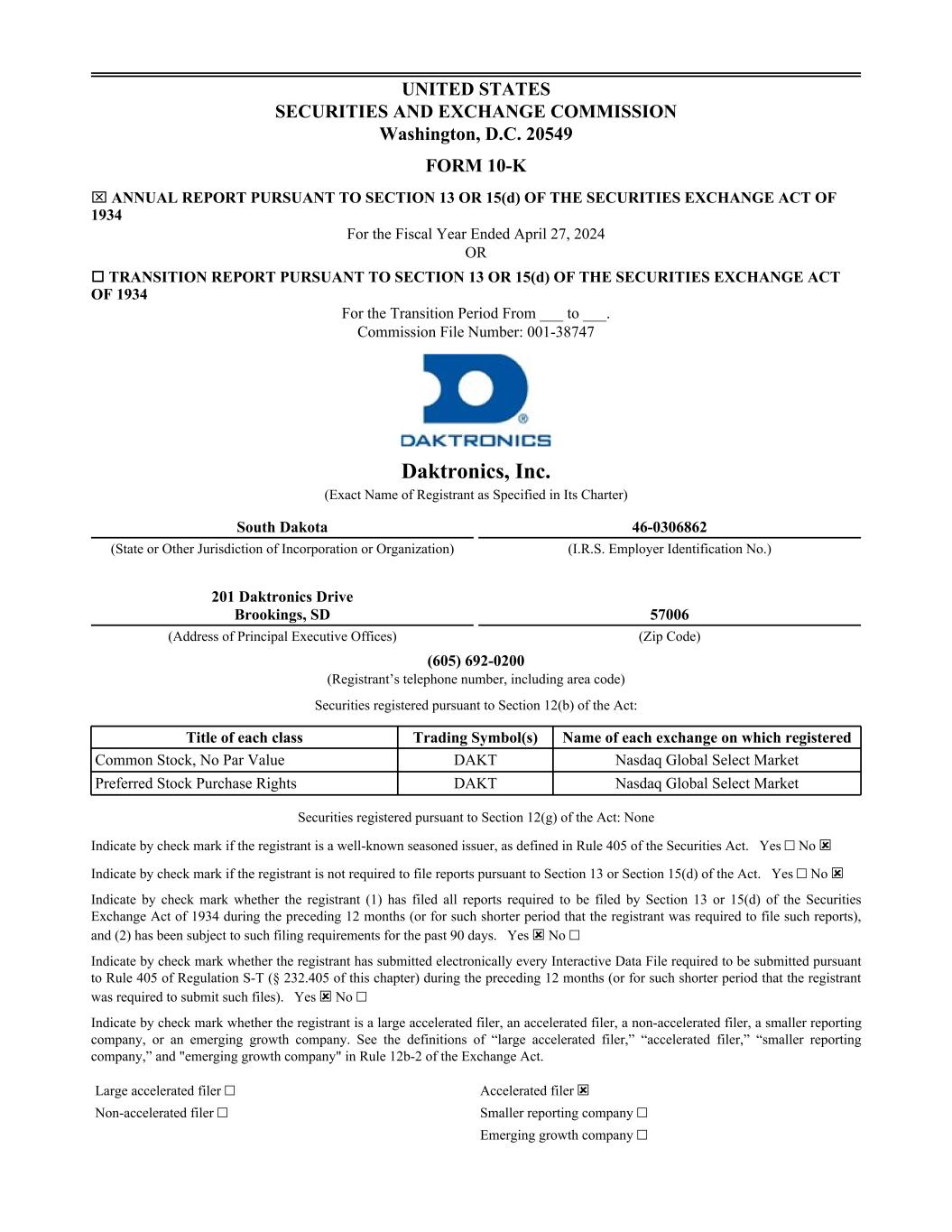
UNITED STATES SECURITIES AND EXCHANGE COMMISSION Washington, D.C. 20549 FORM 10-K x ANNUAL REPORT PURSUANT TO SECTION 13 OR 15(d) OF THE SECURITIES EXCHANGE ACT OF 1934 For the Fiscal Year Ended April 27, 2024 OR o TRANSITION REPORT PURSUANT TO SECTION 13 OR 15(d) OF THE SECURITIES EXCHANGE ACT OF 1934 For the Transition Period From ___ to ___. Commission File Number: 001-38747 Daktronics, Inc. (Exact Name of Registrant as Specified in Its Charter) South Dakota 46-0306862 (State or Other Jurisdiction of Incorporation or Organization) (I.R.S. Employer Identification No.) 201 Daktronics Drive Brookings, SD 57006 (Address of Principal Executive Offices) (Zip Code) (605) 692-0200 (Registrant’s telephone number, including area code) Securities registered pursuant to Section 12(b) of the Act: Title of each class Trading Symbol(s) Name of each exchange on which registered Common Stock, No Par Value DAKT Nasdaq Global Select Market Preferred Stock Purchase Rights DAKT Nasdaq Global Select Market Securities registered pursuant to Section 12(g) of the Act: None Indicate by check mark if the registrant is a well-known seasoned issuer, as defined in Rule 405 of the Securities Act. Yes ☐ No ☒ Indicate by check mark if the registrant is not required to file reports pursuant to Section 13 or Section 15(d) of the Act. Yes ☐ No ☒ Indicate by check mark whether the registrant (1) has filed all reports required to be filed by Section 13 or 15(d) of the Securities Exchange Act of 1934 during the preceding 12 months (or for such shorter period that the registrant was required to file such reports), and (2) has been subject to such filing requirements for the past 90 days. Yes ☒ No ☐ Indicate by check mark whether the registrant has submitted electronically every Interactive Data File required to be submitted pursuant to Rule 405 of Regulation S-T (§ 232.405 of this chapter) during the preceding 12 months (or for such shorter period that the registrant was required to submit such files). Yes ☒ No ☐ Indicate by check mark whether the registrant is a large accelerated filer, an accelerated filer, a non-accelerated filer, a smaller reporting company, or an emerging growth company. See the definitions of “large accelerated filer,” “accelerated filer,” “smaller reporting company,” and "emerging growth company" in Rule 12b-2 of the Exchange Act. Large accelerated filer ☐ Accelerated filer ☒ Non-accelerated filer ☐ Smaller reporting company ☐ Emerging growth company ☐
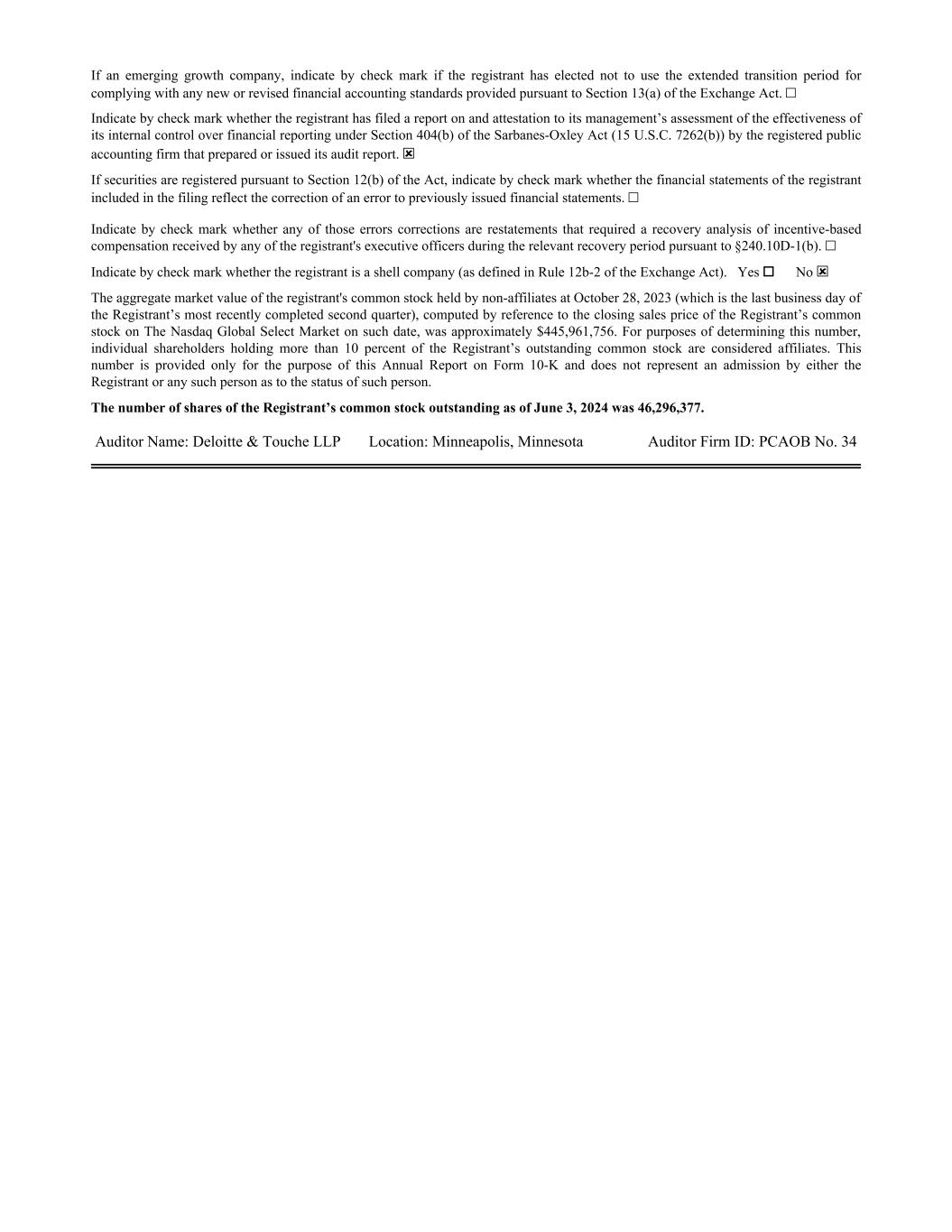
If an emerging growth company, indicate by check mark if the registrant has elected not to use the extended transition period for complying with any new or revised financial accounting standards provided pursuant to Section 13(a) of the Exchange Act. ☐ Indicate by check mark whether the registrant has filed a report on and attestation to its management’s assessment of the effectiveness of its internal control over financial reporting under Section 404(b) of the Sarbanes-Oxley Act (15 U.S.C. 7262(b)) by the registered public accounting firm that prepared or issued its audit report. ☒ If securities are registered pursuant to Section 12(b) of the Act, indicate by check mark whether the financial statements of the registrant included in the filing reflect the correction of an error to previously issued financial statements. ☐ Indicate by check mark whether any of those errors corrections are restatements that required a recovery analysis of incentive-based compensation received by any of the registrant's executive officers during the relevant recovery period pursuant to §240.10D-1(b). ☐ Indicate by check mark whether the registrant is a shell company (as defined in Rule 12b-2 of the Exchange Act). Yes o No ☒ The aggregate market value of the registrant's common stock held by non-affiliates at October 28, 2023 (which is the last business day of the Registrant’s most recently completed second quarter), computed by reference to the closing sales price of the Registrant’s common stock on The Nasdaq Global Select Market on such date, was approximately $445,961,756. For purposes of determining this number, individual shareholders holding more than 10 percent of the Registrant’s outstanding common stock are considered affiliates. This number is provided only for the purpose of this Annual Report on Form 10-K and does not represent an admission by either the Registrant or any such person as to the status of such person. The number of shares of the Registrant’s common stock outstanding as of June 3, 2024 was 46,296,377. Auditor Name: Deloitte & Touche LLP Location: Minneapolis, Minnesota Auditor Firm ID: PCAOB No. 34
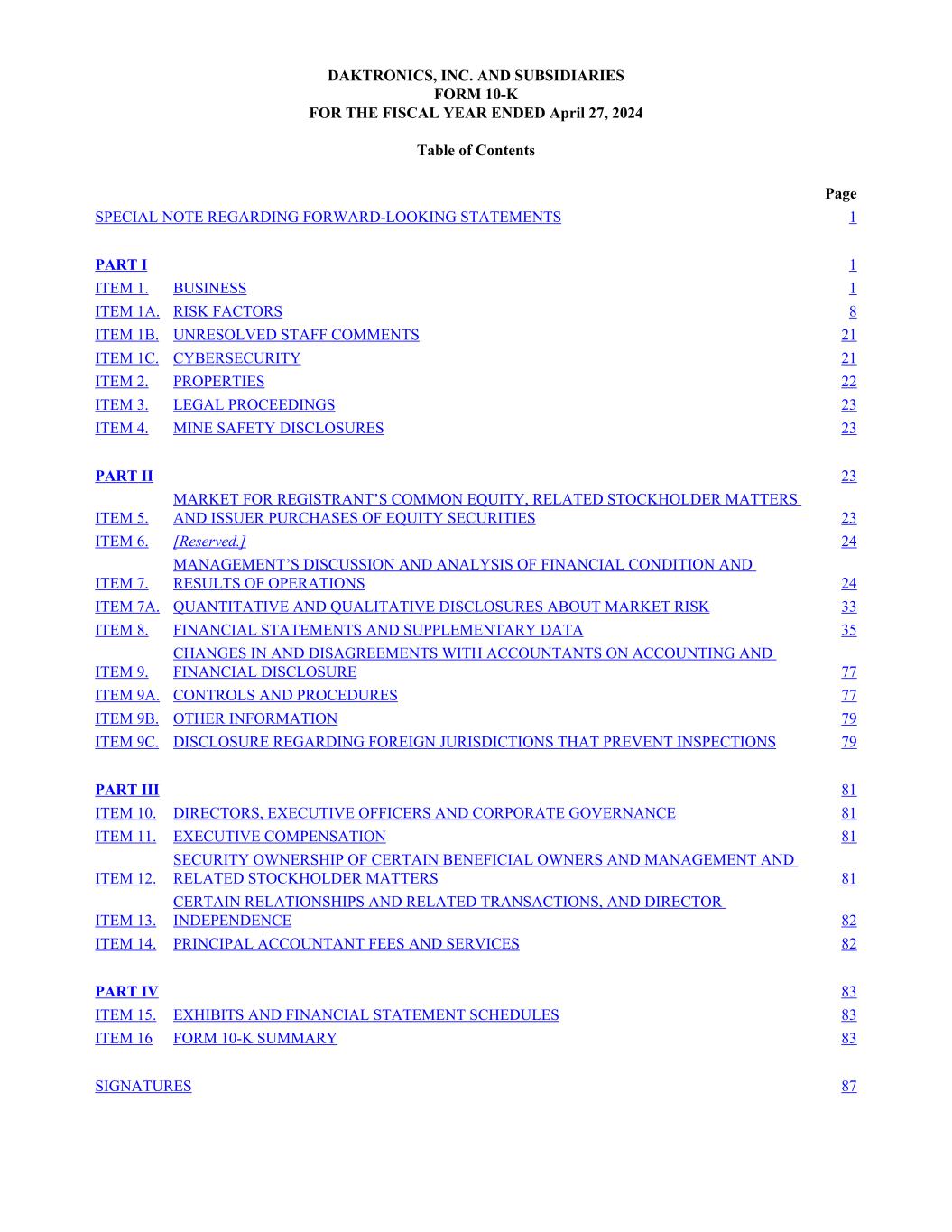
DAKTRONICS, INC. AND SUBSIDIARIES FORM 10-K FOR THE FISCAL YEAR ENDED April 27, 2024 Table of Contents Page SPECIAL NOTE REGARDING FORWARD-LOOKING STATEMENTS 1 PART I 1 ITEM 1. BUSINESS 1 ITEM 1A. RISK FACTORS 8 ITEM 1B. UNRESOLVED STAFF COMMENTS 21 ITEM 1C. CYBERSECURITY 21 ITEM 2. PROPERTIES 22 ITEM 3. LEGAL PROCEEDINGS 23 ITEM 4. MINE SAFETY DISCLOSURES 23 PART II 23 ITEM 5. MARKET FOR REGISTRANT’S COMMON EQUITY, RELATED STOCKHOLDER MATTERS AND ISSUER PURCHASES OF EQUITY SECURITIES 23 ITEM 6. [Reserved.] 24 ITEM 7. MANAGEMENT’S DISCUSSION AND ANALYSIS OF FINANCIAL CONDITION AND RESULTS OF OPERATIONS 24 ITEM 7A. QUANTITATIVE AND QUALITATIVE DISCLOSURES ABOUT MARKET RISK 33 ITEM 8. FINANCIAL STATEMENTS AND SUPPLEMENTARY DATA 35 ITEM 9. CHANGES IN AND DISAGREEMENTS WITH ACCOUNTANTS ON ACCOUNTING AND FINANCIAL DISCLOSURE 77 ITEM 9A. CONTROLS AND PROCEDURES 77 ITEM 9B. OTHER INFORMATION 79 ITEM 9C. DISCLOSURE REGARDING FOREIGN JURISDICTIONS THAT PREVENT INSPECTIONS 79 PART III 81 ITEM 10. DIRECTORS, EXECUTIVE OFFICERS AND CORPORATE GOVERNANCE 81 ITEM 11. EXECUTIVE COMPENSATION 81 ITEM 12. SECURITY OWNERSHIP OF CERTAIN BENEFICIAL OWNERS AND MANAGEMENT AND RELATED STOCKHOLDER MATTERS 81 ITEM 13. CERTAIN RELATIONSHIPS AND RELATED TRANSACTIONS, AND DIRECTOR INDEPENDENCE 82 ITEM 14. PRINCIPAL ACCOUNTANT FEES AND SERVICES 82 PART IV 83 ITEM 15. EXHIBITS AND FINANCIAL STATEMENT SCHEDULES 83 ITEM 16 FORM 10-K SUMMARY 83 SIGNATURES 87

(This page has been left blank intentionally.)

SPECIAL NOTE REGARDING FORWARD–LOOKING STATEMENTS This Annual Report on Form 10-K (including exhibits and any information incorporated by reference herein) (the "Form 10-K" or the "Report") contains both historical and forward-looking statements that involve risks, uncertainties and assumptions. The statements contained in this Report that are not purely historical are forward-looking statements within the meaning of Section 27A of the Securities Act of 1933, as amended, and Section 21B of the Securities Exchange Act of 1934, as amended, including statements regarding our expectations, beliefs, intentions and strategies for the future. These statements appear in a number of places in this Report and include all statements that are not historical statements of fact regarding the intent, belief or current expectations with respect to, among other things: (i.) our competition; (ii.) our financing plans and ability to maintain adequate liquidity; (iii.) trends affecting our financial condition or results of operations; (iv.) our growth and operating strategies; (v.) the declaration and payment of dividends; (vi.) the timing and magnitude of future contracts; (vii.) raw material shortages and lead times and supply chain disruptions; (viii.) fluctuations in margins; (ix.) the seasonality of our business; (x.) the introduction of new products and technology; (xi.) the amount and frequency of warranty claims; (xii.) our ability to manage the impact that new or adjusted tariffs may have on the cost of raw materials and components and our ability to sell product internationally; (xiii.) the resolution of litigation contingencies; (xiv.) the timing and magnitude of any acquisitions or dispositions; (xv.) the impact of governmental laws, regulations, and orders, including as a result of the COVID-19 pandemic caused by the coronavirus; (xvi) disruptions to our business caused by geopolitical events, military actions, work stoppages, natural disasters, or international health emergencies, such as the COVID-19 pandemic; (xvii) uncertainties related to market conditions and entry into financing transactions; (xviii) the Company’s potential need to seek additional strategic alternatives, including seeking additional debt or equity capital or other strategic transactions and/or measures; (xix) our financing plans and ability to maintain adequate liquidity; (xx) the Company’s ability to increase cash flow to support the Company’s operating activities and fund its obligations and working capital needs; (xxi) our ability to obtain additional financing on terms favorable to us, or at all; (xxii) any future goodwill impairment charges; and (xxiii) the valuation of investment in and advances to affiliates. The words “may,” “would,” “could,” “should,” “will,” “expect,” “estimate,” “anticipate,” “believe,” “intend,” “plan” and similar expressions and variations thereof are intended to identify forward-looking statements. Investors are cautioned that any such forward-looking statements are not guarantees of future performance and involve risks and uncertainties, many of which are beyond our ability to control, and that actual results may differ materially from those projected in the forward-looking statements as a result of various factors discussed herein, including those discussed in the section of this Form 10-K entitled “Part I, Item 1A. Risk Factors” and “Part II, Item 7. Management’s Discussion and Analysis of Financial Condition and Results of Operations,” and those factors discussed in detail in our other filings with the Securities and Exchange Commission. PART I. Item 1. BUSINESS Business Overview Daktronics, Inc. and its subsidiaries (the “Company”, “Daktronics”, “we”, “our”, or “us”) are industry leaders in designing and manufacturing electronic scoreboards, programmable display systems and large screen video displays for sporting, commercial and transportation applications. We serve our customers by providing high quality standard display products as well as custom-designed and integrated systems. We offer a complete line of products, from small scoreboards and electronic displays to large multimillion-dollar video display systems as well as related control, timing, and sound systems. We are recognized as a technical leader with the capabilities to design, market, manufacture, install and service complete integrated systems displaying real-time data, graphics, animation and video. We engage in a full range of activities: marketing and sales, engineering and product design and development, manufacturing, technical contracting, professional services, and customer service and support. We were founded in 1968 by Drs. Aelred Kurtenbach and Duane Sander, professors of electrical engineering at South Dakota State University in Brookings, South Dakota. The Company began with the design and manufacture of electronic voting systems for state legislatures. In 1971, Daktronics developed the patented Matside® wrestling scoreboard, the first product in the Company's growing and evolving line. In 1994, Daktronics became a publicly-traded company and invested in display technologies and new markets. We have continued these investments and have supported our long-term customer relationships to grow from a small company operating out of a garage to a world leader in the display industry. We currently employ 2,831 people globally. We are headquartered at 201 Daktronics Dr., Brookings, SD 57006, telephone 605-692-4200. Our Internet address is https://www.daktronics.com. 1

Available Information Our annual, quarterly and current reports and any amendments to those reports are freely available in the "Investor Relations" section of our website. We post each of these documents on our website as soon as reasonably practicable after it is electronically filed with the Securities and Exchange Commission (the "SEC"). These reports and other reports, proxy statements, and electronic filings are also found on the SEC’s website at www.sec.gov. Information contained on our website is not deemed to be incorporated by reference into this Report or filed with the SEC. Reportable Segments We focus our sales and marketing efforts on markets, geographical regions and products. Our five business segments consist of four domestic business units and the International business unit. The four domestic business units consist of Commercial, Live Events, High School Park and Recreation, and Transportation, all of which include the geographic territories of the United States and Canada. Financial information concerning these segments is set forth in this Form 10-K in "Part II, Item 7. Management’s Discussion and Analysis of Financial Condition and Results of Operations" and "Note 3. Segment Reporting" of the Notes to our Consolidated Financial Statements included in this Form 10-K. Industry Background Over the years, our products have evolved significantly from scoreboards and matrix displays with related software applications to complex, integrated visual display systems which include full color video with text and graphics displays located on a local or remote network that are tied together through sophisticated control systems. In the mid-1990's, as light emitting diodes (“LEDs”) became available in red, blue and green colors with outdoor brightness, we pioneered the development of full color LED video displays capable of replicating trillions of colors, thereby producing large format video systems with excellent color, brightness, energy efficiency and lifetime. Due to our foundation of developing scoring and graphics display systems, we were able to add video capabilities so we could meet all our customers' large format display needs in a complete, integrated system. This has proven to be a key factor in Daktronics becoming a leader in large electronic displays. LED technologies continue to evolve and advance, creating new high-resolution and micro-LED display options of all shapes and sizes. Today, the industry continues development in both the construct of the micro-LED and production methods of micro-LED display panels using mass-transfer technology. Integrated visual display systems are increasingly used across a variety of vertical markets including: media/advertising, stadiums/venues, hospitality/leisure, transportation, military and government, broadcast, control room, corporate and education, and retail. Generally, these vertical markets use systems to collaboratively communicate, inform, entertain, and advertise to various sized audiences. Advances in technologies and the decrease in costs of systems have opened up and increased the market's size. Description of Business We are engaged in a full range of activities: marketing and sales, engineering and product design and development, manufacturing, technical contracting, professional services, and customer service and support. Each of those activities is described below: Marketing and Sales. Our sales force is comprised of direct sales staff and resellers, including AV integrators, located throughout the world supporting all customer types in both sales and service. We primarily use a direct sales force for large integrated display system sales in professional sports, colleges and universities, and commercial spectacular projects. We also use our direct sales force to sell to out-of-home advertising companies, to transportation system operators, and to certain high school park and recreation customers. The majority of our products sold by resellers are standard catalog products such as video boards and dynamic message systems and increasingly include indoor micro-LED configurable display systems. We also utilize resellers outside North America for large integrated system sales where we do not have a direct sales presence. We support our resellers through direct mail/email advertising, social media campaigns, trade journal advertising, product and installation training, trade show exhibitions, and accessibility to our regional sales or service teams and demonstration equipment. Engineering and Product Design and Development. The large format electronic display industry is characterized by ongoing product innovations and developments in technology and complementary services. To remain competitive, we have a tradition of applying engineering resources throughout our business to anticipate and respond rapidly to the system needs in the marketplace. We employ and contract with engineers and technicians in the areas of mechanical and electrical 2

design; applications engineering; software design; quality design; and customer and product support. Product managers assigned to each product family assist our sales staff in training and implementing product improvements which ensures each product is designed for maximum reliability and serviceability. We employ and contract with process engineers to assist in quality and reliability processing in our product design testing and manufacturing areas. We also make selected investments in and contract with affiliated companies to support and advance technologies and capabilities for our product lines and solutions. Manufacturing. The majority of our products are manufactured in the United States, specifically in South Dakota and Minnesota. We also have manufacturing facilities in China and Ireland. We perform component manufacturing, system manufacturing (metal fabrication, electronic assembly, sub-assembly and final assembly) and testing in-house for most of our products to control quality, improve response time and maximize cost-effectiveness. Given the cyclical nature of some parts of our business and dispersed sales geography, we balance and maintain our ability to manufacture the same products across our plants so we can efficiently utilize our capacity and reduce costs. A key strategy of ours is to increase standardization and commonality of parts and manufacturing processes across product lines through the use of product platforms to increase efficiencies. Other strategies include supplier management programs and lean manufacturing techniques. For more details on our facilities, see "Part II, Item 2. Properties". Technical Contracting. We serve as a technical contractor for larger display system installations requiring custom designs and innovative product solutions. The purchase of display systems typically involves competitive proposals. As part of our response to a proposal request, we may suggest additional products or features to assist the prospective customer in analyzing the optimal type of display system. We usually include site preparation and installation services related to the display system in our proposal. In these cases, we serve as a contractor and may retain subcontractors for electrical, steel and installation labor. We have developed relationships with many subcontractors throughout the United States and the world, which is an advantage for us in bidding and delivering on these projects. We are licensed as a general contractor in many jurisdictions. Professional Services. To assist our clients' ability to engage, inform and entertain their audiences, we provide professional services including event support, event production curriculum, content creation, product maintenance, marketing assistance, training on hardware and software, control room design, and continuing technical support training for operators. Customer Service and Support. We offer limited warranties on our products, ranging from one to 10 years, against failure due to defective parts or workmanship. In addition, we offer service agreements of various scopes. To serve our customers, we provide help-desk access, parts repair and replacement, display monitoring and on-site support. Our technical help desk has experienced technicians who are on-call 24 hours a day to support events and sites. Our field service personnel and third-party service partners are trained to provide on-site support. We use third-party service partners to allow us to respond to the changes in volume of service requests during our seasonal peaks. Products and Technologies The two principal components of our systems are the display and the control system, which manages the operation of the display. We produce displays varying in complexity, size and resolution. The physical dimensions of a display depend on the size of the viewing area, the distance from the viewer to the display, and the amount and type of information to be displayed. The control system is comprised of various combinations of computer hardware, video processing hardware and software products designed to compile information provided by the operator and other integrated sources to display information, graphics, video or animation on the displays. We customize our products according to the design specifications of the customer and the conditions of the environment in which our products function. Our products are comprised of the following product families: • Video displays/video walls • Scoreboards and timing systems • LED Message displays and signs • ITS (intelligent transportation systems) dynamic message signs • Mass Transit displays • Sound systems • Digital billboards • Digital street furniture • Digit and price displays 3

• Indoor dynamic messaging systems and indoor liquid crystal display ("LCD") signs • Software and controllers including Venus® Control Suite, Show Control Studio and Show Control Live Each of these product families is described below: Video Displays/Video Walls. These displays are comprised of a large number of full-color pixels capable of showing various levels of video feeds, pre-rendered graphics and animated content with Real Time Data capabilities. These displays include red, green and blue LEDs arranged in various combinations to form pixels. The electronic circuitry, which controls the pixels, allows for variances in the relative brightness of each LED to provide a full color spectrum, thereby displaying video images in striking, vibrant colors. Variables in video displays include the spacing of the pixels (pixel pitch), the resolution of the displays (number of pixels), the brightness of the displays (nits), the number of discrete colors the display is able to produce (color depth), the viewing angles, and the LED technology. We offer a broad range of indoor and outdoor LED video displays with these varying features. Examples of offerings include centerhung displays, landmark displays, video walls, ribbon board displays, hanging banners, roadside displays, digital billboards, corporate office entrance displays, conference room displays, control room displays, and video displays designed for arenas, stadiums, retail stores, restaurants, malls, transportation hubs and other similar indoor facilities. Video displays provide content to serve as a revenue generation source through advertising or as an information and communication medium (such as scoring, statistics, wayfinding, advertising, and control center information), or to provide interior design elements to create luxurious space to feature digital art. The control components for video displays in live event applications include our Show Control Software Suite, proprietary digital media players and video processors. These control components provide advanced capabilities for the display of live video and real-time content on our displays. The Show Control Software Suite can operate an entire network of displays within a venue from a single, intuitive control interface. Its features allow users to instantly deliver media clips, camera feeds, and streaming information to any display in a venue. Scoreboards and Timing Systems. Our line of scoreboards and timing products include indoor and outdoor scoreboards for many different sports, digit displays, scoring and timing controllers, statistics software and other related products. Indoor and outdoor systems range in complexity from small scoreboards to larger systems incorporating scoring, timing, video, message centers, advertising panels and control software. We offer a variety of controllers complementing our scoreboards and displays. These controllers vary in complexity from the All Sport® 100, a handheld controller for portable scoreboards, to the All Sport® Pro, designed for more sophisticated scoring systems and allowing for more user-defined options. As a key component of an integrated system, we market sports statistics and results software under the DakStats® trademark. The software allows the entry and display of sports statistics and other information. It is one of the leading applications of its type in collegiate and high school sports. LED Message Displays and Signs. The Galaxy® product line is a family of full-matrix displays, available in both indoor and outdoor models and controlled with the Venus® Control Suite. Galaxy® displays are full color or monochrome with varying pixel spacing depending on color, size and viewing distance. Galaxy® displays can display text, graphics and animation, as well as prerecorded video clips. They are used primarily to convey information and on-premises advertising to consumers. The Venus® Control Suite software is used to control the creation of messages and graphic sequences for uploading to the Galaxy® displays. This software is designed to be user friendly and applicable to all general advertising or message applications. It can be used to control a single message display or can scale up to provide a secure, cloud-based control center for large networks of message displays. ITS Dynamic Message Signs ("DMS"). DMS products include a wide range of LED displays for road management applications. The Vanguard® family of dynamic message displays is typically used to direct traffic and inform motorists. These displays are used over freeways, on arterial roads, near bridges, at toll booths and in other locations. We have also developed a Vanguard® control system for these displays to help transportation agencies manage large networks of displays. 4
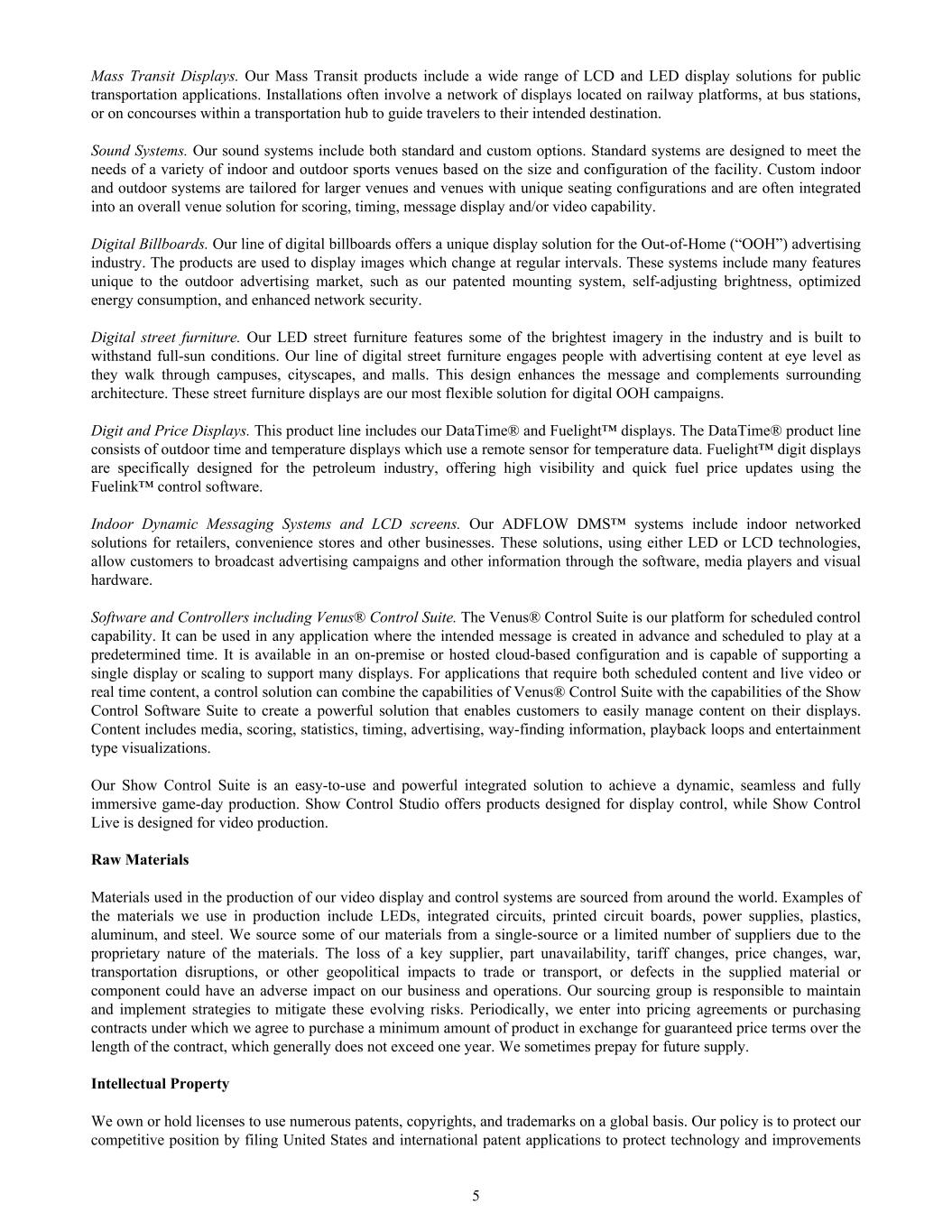
Mass Transit Displays. Our Mass Transit products include a wide range of LCD and LED display solutions for public transportation applications. Installations often involve a network of displays located on railway platforms, at bus stations, or on concourses within a transportation hub to guide travelers to their intended destination. Sound Systems. Our sound systems include both standard and custom options. Standard systems are designed to meet the needs of a variety of indoor and outdoor sports venues based on the size and configuration of the facility. Custom indoor and outdoor systems are tailored for larger venues and venues with unique seating configurations and are often integrated into an overall venue solution for scoring, timing, message display and/or video capability. Digital Billboards. Our line of digital billboards offers a unique display solution for the Out-of-Home (“OOH”) advertising industry. The products are used to display images which change at regular intervals. These systems include many features unique to the outdoor advertising market, such as our patented mounting system, self-adjusting brightness, optimized energy consumption, and enhanced network security. Digital street furniture. Our LED street furniture features some of the brightest imagery in the industry and is built to withstand full-sun conditions. Our line of digital street furniture engages people with advertising content at eye level as they walk through campuses, cityscapes, and malls. This design enhances the message and complements surrounding architecture. These street furniture displays are our most flexible solution for digital OOH campaigns. Digit and Price Displays. This product line includes our DataTime® and Fuelight™ displays. The DataTime® product line consists of outdoor time and temperature displays which use a remote sensor for temperature data. Fuelight™ digit displays are specifically designed for the petroleum industry, offering high visibility and quick fuel price updates using the Fuelink™ control software. Indoor Dynamic Messaging Systems and LCD screens. Our ADFLOW DMS™ systems include indoor networked solutions for retailers, convenience stores and other businesses. These solutions, using either LED or LCD technologies, allow customers to broadcast advertising campaigns and other information through the software, media players and visual hardware. Software and Controllers including Venus® Control Suite. The Venus® Control Suite is our platform for scheduled control capability. It can be used in any application where the intended message is created in advance and scheduled to play at a predetermined time. It is available in an on-premise or hosted cloud-based configuration and is capable of supporting a single display or scaling to support many displays. For applications that require both scheduled content and live video or real time content, a control solution can combine the capabilities of Venus® Control Suite with the capabilities of the Show Control Software Suite to create a powerful solution that enables customers to easily manage content on their displays. Content includes media, scoring, statistics, timing, advertising, way-finding information, playback loops and entertainment type visualizations. Our Show Control Suite is an easy-to-use and powerful integrated solution to achieve a dynamic, seamless and fully immersive game-day production. Show Control Studio offers products designed for display control, while Show Control Live is designed for video production. Raw Materials Materials used in the production of our video display and control systems are sourced from around the world. Examples of the materials we use in production include LEDs, integrated circuits, printed circuit boards, power supplies, plastics, aluminum, and steel. We source some of our materials from a single-source or a limited number of suppliers due to the proprietary nature of the materials. The loss of a key supplier, part unavailability, tariff changes, price changes, war, transportation disruptions, or other geopolitical impacts to trade or transport, or defects in the supplied material or component could have an adverse impact on our business and operations. Our sourcing group is responsible to maintain and implement strategies to mitigate these evolving risks. Periodically, we enter into pricing agreements or purchasing contracts under which we agree to purchase a minimum amount of product in exchange for guaranteed price terms over the length of the contract, which generally does not exceed one year. We sometimes prepay for future supply. Intellectual Property We own or hold licenses to use numerous patents, copyrights, and trademarks on a global basis. Our policy is to protect our competitive position by filing United States and international patent applications to protect technology and improvements 5

that we consider important to the development of our business. This will allow us to pursue infringement claims against competitors for protection due to patent violations. Although we own a number of patents and possess rights under others to which we attach importance, we do not believe that our business as a whole is materially dependent upon any such patents or rights. We also own a number of trademarks that we believe are important in connection with the identification of our products and associated goodwill with customers, but no part of our business materially depends on such trademarks. We also rely on nondisclosure agreements with our employees and agents to protect our intellectual property. Despite these intellectual property protections, there can be no assurance a competitor will not copy the functions or features of our products. Seasonality Our net sales and profitability historically have fluctuated due to the impact of uniquely configured orders, such as display systems for professional sports facilities, colleges and universities, and spectacular projects in the commercial area, as well as the seasonality of the sports market. Uniquely configured orders can include several displays, controllers, and subcontracted structure builds, each of which can occur on varied schedules per the customer's needs. Our third fiscal quarter sales and profit levels are lighter than other quarters due to the seasonality of our sports business, construction cycles, and the reduced number of production days due to holidays in the quarter. Our gross margins tend to fluctuate more on uniquely configured orders than on limited configured orders. Uniquely configured orders involving competitive bidding and substantial subcontracting work for product installation generally have lower gross margins. Although we follow the over-time method of recognizing revenues for uniquely configured orders, we nevertheless have experienced fluctuations in operating results and expect our future results of operations will be subject to similar fluctuations. Working Capital For information regarding working capital items, see “Part II, Item 7. Management’s Discussion and Analysis of Financial Condition and Results of Operations-Liquidity and Capital Resources” in this Form 10-K. Customers We have a large and diverse worldwide customer base, ranging from local main street business owners, out-of-home companies, governmental agencies, and schools, colleges, and universities, to the owners and operators of premier professional sports arenas. Our customers are important to us, and we strive to serve them over the long-term to earn their future business. The loss of one or more customers could have an adverse effect on us. See "Note 3. Segment Reporting" of the Notes to our Consolidated Financial Statements included in this Form 10-K for our primary markets and customers of each business unit. Product Order Backlog Backlog represents the dollar value of orders for integrated electronic display systems and related products and services which are expected to be recognized in net sales in the future. Orders are contractually binding purchase commitments from customers. Orders are included in backlog when we are in receipt of an executed contract and any required deposits or security and have not yet been recognized into net sales. Certain orders for which we have received binding letters of intent or contracts will not be included in backlog until all required contractual documents and deposits are received. Orders and backlog are not metrics defined by accounting principles generally accepted in the United States of America ("GAAP"), and our methodology for determining orders and backlog may vary from the methodology used by other companies in determining their orders and backlog amounts. Order and backlog levels provide management and investors additional details surrounding the results of our business activities in the marketplace and highlight fluctuations caused by seasonality and multi-million dollar projects. Management uses orders to evaluate market share and performance in the competitive environment. Management uses backlog information for capacity and resource planning. Order fulfillment timing is dependent on customer schedules, supply chain conditions, and our capacity availability. We believe order information is useful to investors because it provides an indication of our market share and future revenues. Our product order backlog as of April 27, 2024 was $316.9 million as compared to $400.7 million as of April 29, 2023. The decrease in backlog, to more historical levels, is a result of fulfilling orders at a greater pace in fiscal 2024 as supply 6
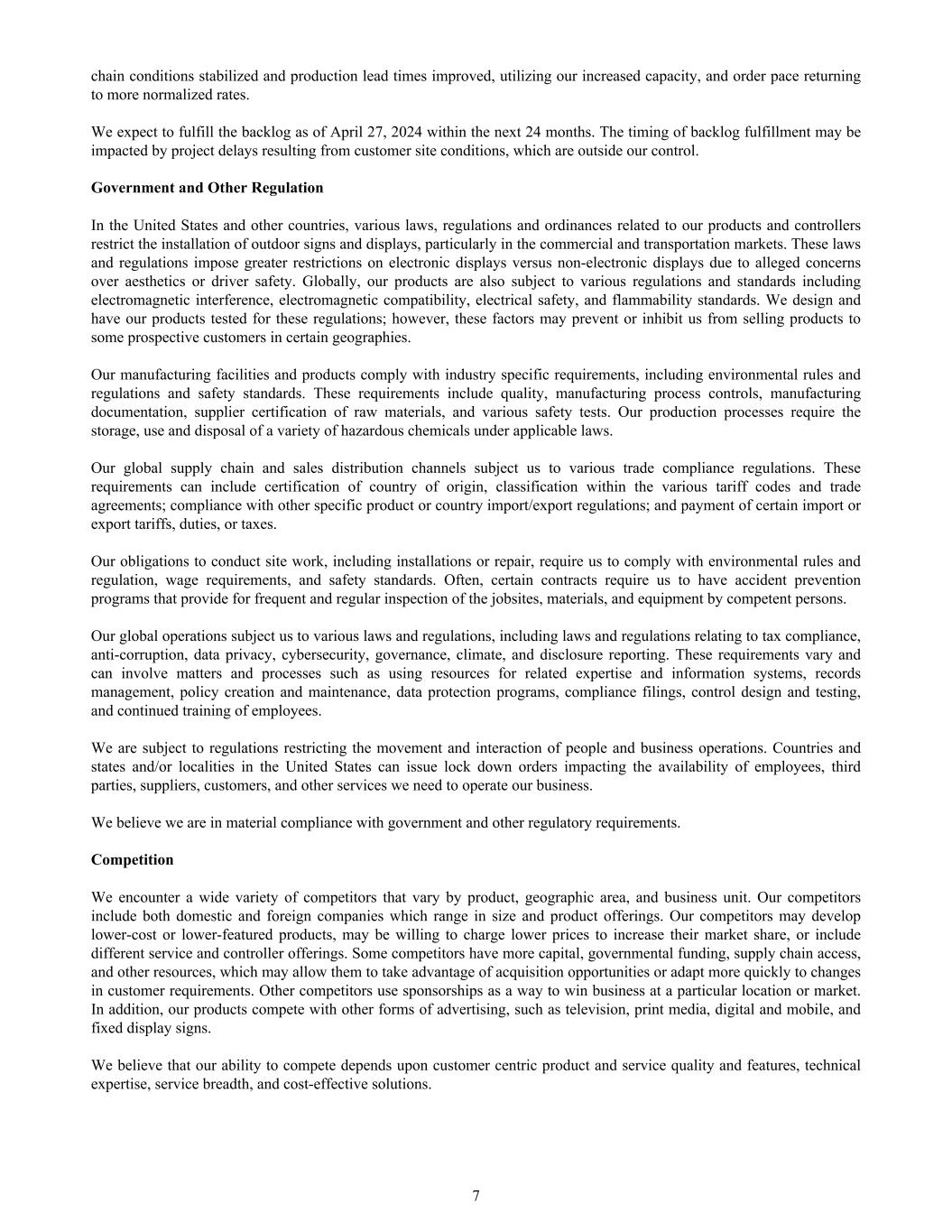
chain conditions stabilized and production lead times improved, utilizing our increased capacity, and order pace returning to more normalized rates. We expect to fulfill the backlog as of April 27, 2024 within the next 24 months. The timing of backlog fulfillment may be impacted by project delays resulting from customer site conditions, which are outside our control. Government and Other Regulation In the United States and other countries, various laws, regulations and ordinances related to our products and controllers restrict the installation of outdoor signs and displays, particularly in the commercial and transportation markets. These laws and regulations impose greater restrictions on electronic displays versus non-electronic displays due to alleged concerns over aesthetics or driver safety. Globally, our products are also subject to various regulations and standards including electromagnetic interference, electromagnetic compatibility, electrical safety, and flammability standards. We design and have our products tested for these regulations; however, these factors may prevent or inhibit us from selling products to some prospective customers in certain geographies. Our manufacturing facilities and products comply with industry specific requirements, including environmental rules and regulations and safety standards. These requirements include quality, manufacturing process controls, manufacturing documentation, supplier certification of raw materials, and various safety tests. Our production processes require the storage, use and disposal of a variety of hazardous chemicals under applicable laws. Our global supply chain and sales distribution channels subject us to various trade compliance regulations. These requirements can include certification of country of origin, classification within the various tariff codes and trade agreements; compliance with other specific product or country import/export regulations; and payment of certain import or export tariffs, duties, or taxes. Our obligations to conduct site work, including installations or repair, require us to comply with environmental rules and regulation, wage requirements, and safety standards. Often, certain contracts require us to have accident prevention programs that provide for frequent and regular inspection of the jobsites, materials, and equipment by competent persons. Our global operations subject us to various laws and regulations, including laws and regulations relating to tax compliance, anti-corruption, data privacy, cybersecurity, governance, climate, and disclosure reporting. These requirements vary and can involve matters and processes such as using resources for related expertise and information systems, records management, policy creation and maintenance, data protection programs, compliance filings, control design and testing, and continued training of employees. We are subject to regulations restricting the movement and interaction of people and business operations. Countries and states and/or localities in the United States can issue lock down orders impacting the availability of employees, third parties, suppliers, customers, and other services we need to operate our business. We believe we are in material compliance with government and other regulatory requirements. Competition We encounter a wide variety of competitors that vary by product, geographic area, and business unit. Our competitors include both domestic and foreign companies which range in size and product offerings. Our competitors may develop lower-cost or lower-featured products, may be willing to charge lower prices to increase their market share, or include different service and controller offerings. Some competitors have more capital, governmental funding, supply chain access, and other resources, which may allow them to take advantage of acquisition opportunities or adapt more quickly to changes in customer requirements. Other competitors use sponsorships as a way to win business at a particular location or market. In addition, our products compete with other forms of advertising, such as television, print media, digital and mobile, and fixed display signs. We believe that our ability to compete depends upon customer centric product and service quality and features, technical expertise, service breadth, and cost-effective solutions. 7
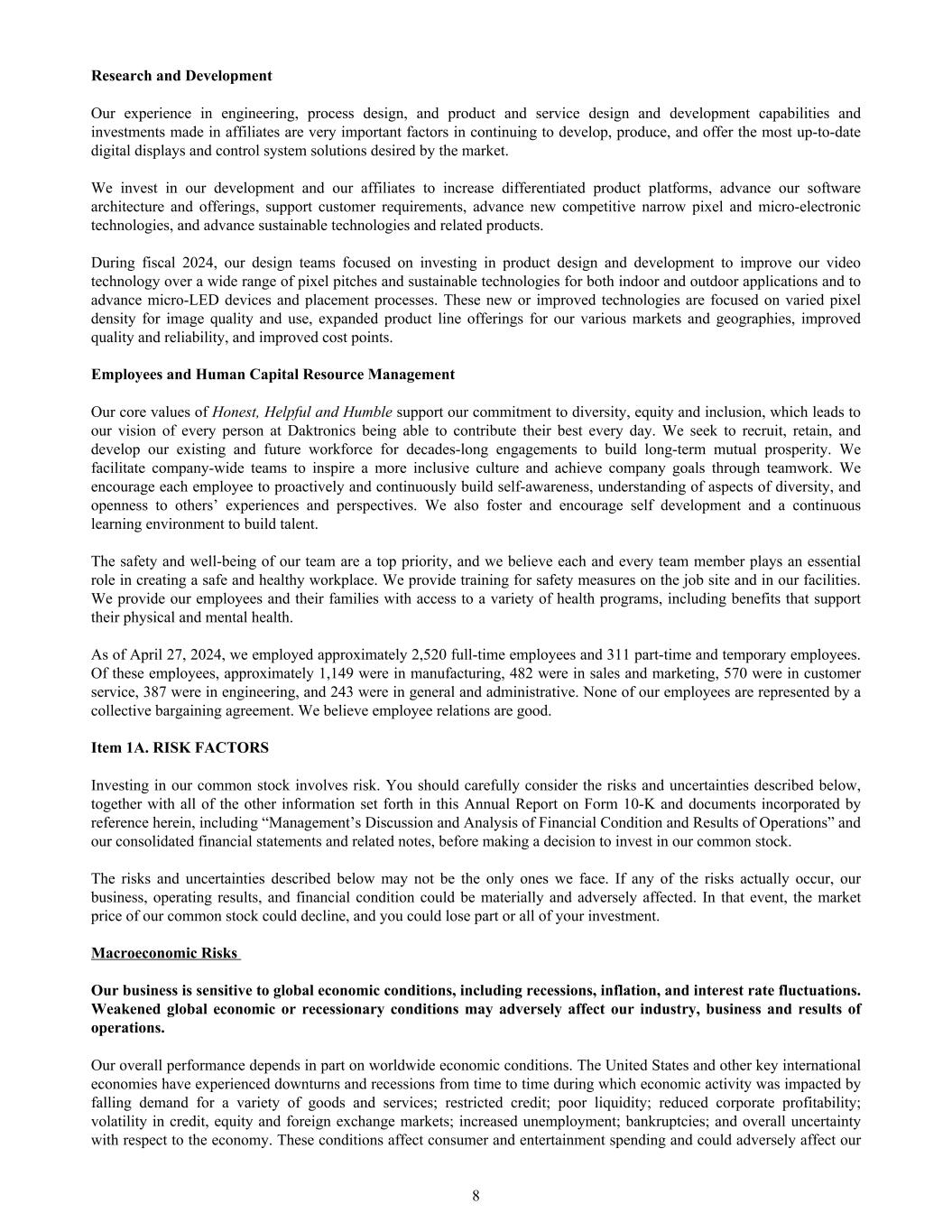
Research and Development Our experience in engineering, process design, and product and service design and development capabilities and investments made in affiliates are very important factors in continuing to develop, produce, and offer the most up-to-date digital displays and control system solutions desired by the market. We invest in our development and our affiliates to increase differentiated product platforms, advance our software architecture and offerings, support customer requirements, advance new competitive narrow pixel and micro-electronic technologies, and advance sustainable technologies and related products. During fiscal 2024, our design teams focused on investing in product design and development to improve our video technology over a wide range of pixel pitches and sustainable technologies for both indoor and outdoor applications and to advance micro-LED devices and placement processes. These new or improved technologies are focused on varied pixel density for image quality and use, expanded product line offerings for our various markets and geographies, improved quality and reliability, and improved cost points. Employees and Human Capital Resource Management Our core values of Honest, Helpful and Humble support our commitment to diversity, equity and inclusion, which leads to our vision of every person at Daktronics being able to contribute their best every day. We seek to recruit, retain, and develop our existing and future workforce for decades-long engagements to build long-term mutual prosperity. We facilitate company-wide teams to inspire a more inclusive culture and achieve company goals through teamwork. We encourage each employee to proactively and continuously build self-awareness, understanding of aspects of diversity, and openness to others’ experiences and perspectives. We also foster and encourage self development and a continuous learning environment to build talent. The safety and well-being of our team are a top priority, and we believe each and every team member plays an essential role in creating a safe and healthy workplace. We provide training for safety measures on the job site and in our facilities. We provide our employees and their families with access to a variety of health programs, including benefits that support their physical and mental health. As of April 27, 2024, we employed approximately 2,520 full-time employees and 311 part-time and temporary employees. Of these employees, approximately 1,149 were in manufacturing, 482 were in sales and marketing, 570 were in customer service, 387 were in engineering, and 243 were in general and administrative. None of our employees are represented by a collective bargaining agreement. We believe employee relations are good. Item 1A. RISK FACTORS Investing in our common stock involves risk. You should carefully consider the risks and uncertainties described below, together with all of the other information set forth in this Annual Report on Form 10-K and documents incorporated by reference herein, including “Management’s Discussion and Analysis of Financial Condition and Results of Operations” and our consolidated financial statements and related notes, before making a decision to invest in our common stock. The risks and uncertainties described below may not be the only ones we face. If any of the risks actually occur, our business, operating results, and financial condition could be materially and adversely affected. In that event, the market price of our common stock could decline, and you could lose part or all of your investment. Macroeconomic Risks Our business is sensitive to global economic conditions, including recessions, inflation, and interest rate fluctuations. Weakened global economic or recessionary conditions may adversely affect our industry, business and results of operations. Our overall performance depends in part on worldwide economic conditions. The United States and other key international economies have experienced downturns and recessions from time to time during which economic activity was impacted by falling demand for a variety of goods and services; restricted credit; poor liquidity; reduced corporate profitability; volatility in credit, equity and foreign exchange markets; increased unemployment; bankruptcies; and overall uncertainty with respect to the economy. These conditions affect consumer and entertainment spending and could adversely affect our 8

customers’ ability or willingness to purchase our products, delay prospective customers’ purchasing decisions, reduce the value of their contracts, or affect attrition rates, all of which could adversely affect our operating results. These demand fluctuations and various factors may reduce our ability to effectively utilize our capacity and impact our results of operations. We rely on global supply chains, and inflationary pressures can increase our input costs faster than our ability to raise prices. These could eliminate our ability to sell our products or receive parts and components through our global supply chains. The rate of interest we pay on our asset-based lending facility with JPMorgan Chase Bank, N.A. is correlated to the Standard Overnight Fund Rate (SOFR), which is determined by governmental policy decisions. Increases in SOFR will increase the rate of any extended borrowing on this facility. Geopolitical issues, conflicts, governmental actions and other global events could adversely affect our results of operations and financial condition. Our business is subject to global political issues and conflicts and governmental actions. Such factors can create trade restrictions, increase tariff costs, increase prices for raw materials and components used in our products, increase the cost of sales, decrease demand for our products, or have other implications on our business operations. These impacts could reduce profitability and could have a material adverse effect on our results of operations and financial condition if they escalate into geographies in which we do business, manufacture our products, or obtain raw materials and components for production. For example, during calendar 2024, national elections are occurring in countries accounting for 49 percent of the people of the world, including the United States, which could cause changing governmental actions and policies; the Israeli- Palestinian conflict; the continuing conflict arising from the invasion of Ukraine by Russia; or tensions among Taiwan, China, the United States or other countries, could adversely impact macroeconomic conditions, give rise to regional instability, and result in heightened economic tariffs, sanctions and import-export restrictions from the United States and the international community in a manner that adversely affects our Company, including to the extent that any such actions cause material business interruptions or restrict our ability in these regions to conduct business with certain suppliers or vendors. Additionally, such conflict or sanctions may significantly devalue various global currencies and have a negative impact on economies in geographies in which we do business. We face risks related to actual or threatened health epidemics and other outbreaks, which have had and could have a material adverse effect on our operations, liquidity, financial conditions, and financial results. A serious global pandemic can adversely impact, shock and weaken the global economy. These impacts can amplify other risk factors and could have a material impact on our operations, liquidity, financial conditions, and financial results. Our business, operations, and financial results were impacted by the COVID-19 pandemic. Impacts on our business include, but are not limited to: • Inability to meet our customers' demand due to disruptions in our manufacturing caused by delays and disruptions in obtaining certain raw material and other manufacturing components and because of restrictions affecting our ability to conduct work at sites during shutdowns; • Rapid increases in raw material, components, and personnel related costs and expenses; and • Rapid declines and increases in demand for our products. Unexpected events, including natural disasters, weather events, war, terrorist acts, and pandemics, may increase our cost of doing business or disrupt our operations. We operate manufacturing operations in three locations in the United States - Brookings, South Dakota, Sioux Falls, South Dakota, and Redwood Falls, Minnesota, and we have production facilities in Ireland and China. Unexpected events could result in damage to, and a complete or partial closure of, one or more of our manufacturing facilities, which could make it difficult to supply our customers with product and provide our employees with work, thereby adversely affecting our business, operating results or financial condition. 9
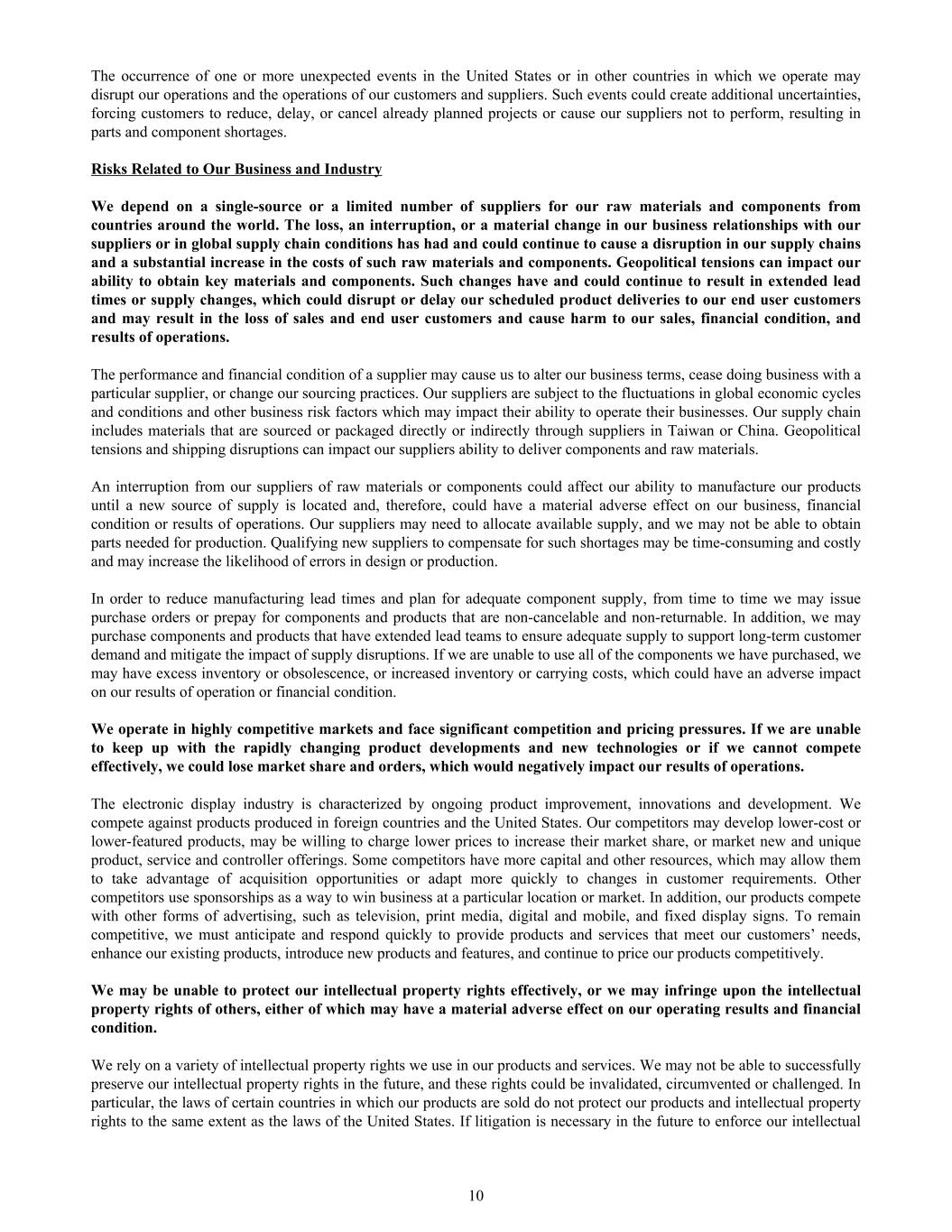
The occurrence of one or more unexpected events in the United States or in other countries in which we operate may disrupt our operations and the operations of our customers and suppliers. Such events could create additional uncertainties, forcing customers to reduce, delay, or cancel already planned projects or cause our suppliers not to perform, resulting in parts and component shortages. Risks Related to Our Business and Industry We depend on a single-source or a limited number of suppliers for our raw materials and components from countries around the world. The loss, an interruption, or a material change in our business relationships with our suppliers or in global supply chain conditions has had and could continue to cause a disruption in our supply chains and a substantial increase in the costs of such raw materials and components. Geopolitical tensions can impact our ability to obtain key materials and components. Such changes have and could continue to result in extended lead times or supply changes, which could disrupt or delay our scheduled product deliveries to our end user customers and may result in the loss of sales and end user customers and cause harm to our sales, financial condition, and results of operations. The performance and financial condition of a supplier may cause us to alter our business terms, cease doing business with a particular supplier, or change our sourcing practices. Our suppliers are subject to the fluctuations in global economic cycles and conditions and other business risk factors which may impact their ability to operate their businesses. Our supply chain includes materials that are sourced or packaged directly or indirectly through suppliers in Taiwan or China. Geopolitical tensions and shipping disruptions can impact our suppliers ability to deliver components and raw materials. An interruption from our suppliers of raw materials or components could affect our ability to manufacture our products until a new source of supply is located and, therefore, could have a material adverse effect on our business, financial condition or results of operations. Our suppliers may need to allocate available supply, and we may not be able to obtain parts needed for production. Qualifying new suppliers to compensate for such shortages may be time-consuming and costly and may increase the likelihood of errors in design or production. In order to reduce manufacturing lead times and plan for adequate component supply, from time to time we may issue purchase orders or prepay for components and products that are non-cancelable and non-returnable. In addition, we may purchase components and products that have extended lead teams to ensure adequate supply to support long-term customer demand and mitigate the impact of supply disruptions. If we are unable to use all of the components we have purchased, we may have excess inventory or obsolescence, or increased inventory or carrying costs, which could have an adverse impact on our results of operation or financial condition. We operate in highly competitive markets and face significant competition and pricing pressures. If we are unable to keep up with the rapidly changing product developments and new technologies or if we cannot compete effectively, we could lose market share and orders, which would negatively impact our results of operations. The electronic display industry is characterized by ongoing product improvement, innovations and development. We compete against products produced in foreign countries and the United States. Our competitors may develop lower-cost or lower-featured products, may be willing to charge lower prices to increase their market share, or market new and unique product, service and controller offerings. Some competitors have more capital and other resources, which may allow them to take advantage of acquisition opportunities or adapt more quickly to changes in customer requirements. Other competitors use sponsorships as a way to win business at a particular location or market. In addition, our products compete with other forms of advertising, such as television, print media, digital and mobile, and fixed display signs. To remain competitive, we must anticipate and respond quickly to provide products and services that meet our customers’ needs, enhance our existing products, introduce new products and features, and continue to price our products competitively. We may be unable to protect our intellectual property rights effectively, or we may infringe upon the intellectual property rights of others, either of which may have a material adverse effect on our operating results and financial condition. We rely on a variety of intellectual property rights we use in our products and services. We may not be able to successfully preserve our intellectual property rights in the future, and these rights could be invalidated, circumvented or challenged. In particular, the laws of certain countries in which our products are sold do not protect our products and intellectual property rights to the same extent as the laws of the United States. If litigation is necessary in the future to enforce our intellectual 10
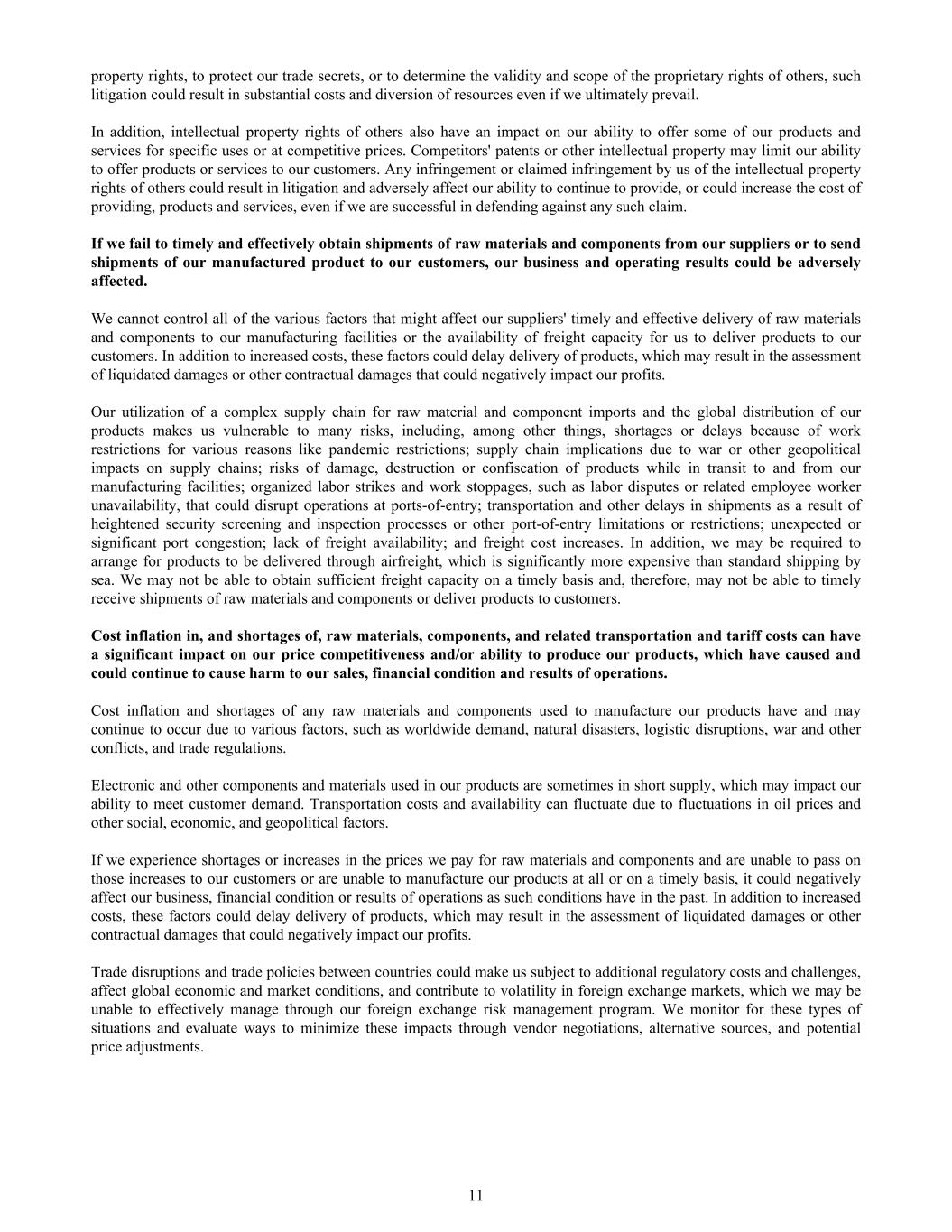
property rights, to protect our trade secrets, or to determine the validity and scope of the proprietary rights of others, such litigation could result in substantial costs and diversion of resources even if we ultimately prevail. In addition, intellectual property rights of others also have an impact on our ability to offer some of our products and services for specific uses or at competitive prices. Competitors' patents or other intellectual property may limit our ability to offer products or services to our customers. Any infringement or claimed infringement by us of the intellectual property rights of others could result in litigation and adversely affect our ability to continue to provide, or could increase the cost of providing, products and services, even if we are successful in defending against any such claim. If we fail to timely and effectively obtain shipments of raw materials and components from our suppliers or to send shipments of our manufactured product to our customers, our business and operating results could be adversely affected. We cannot control all of the various factors that might affect our suppliers' timely and effective delivery of raw materials and components to our manufacturing facilities or the availability of freight capacity for us to deliver products to our customers. In addition to increased costs, these factors could delay delivery of products, which may result in the assessment of liquidated damages or other contractual damages that could negatively impact our profits. Our utilization of a complex supply chain for raw material and component imports and the global distribution of our products makes us vulnerable to many risks, including, among other things, shortages or delays because of work restrictions for various reasons like pandemic restrictions; supply chain implications due to war or other geopolitical impacts on supply chains; risks of damage, destruction or confiscation of products while in transit to and from our manufacturing facilities; organized labor strikes and work stoppages, such as labor disputes or related employee worker unavailability, that could disrupt operations at ports-of-entry; transportation and other delays in shipments as a result of heightened security screening and inspection processes or other port-of-entry limitations or restrictions; unexpected or significant port congestion; lack of freight availability; and freight cost increases. In addition, we may be required to arrange for products to be delivered through airfreight, which is significantly more expensive than standard shipping by sea. We may not be able to obtain sufficient freight capacity on a timely basis and, therefore, may not be able to timely receive shipments of raw materials and components or deliver products to customers. Cost inflation in, and shortages of, raw materials, components, and related transportation and tariff costs can have a significant impact on our price competitiveness and/or ability to produce our products, which have caused and could continue to cause harm to our sales, financial condition and results of operations. Cost inflation and shortages of any raw materials and components used to manufacture our products have and may continue to occur due to various factors, such as worldwide demand, natural disasters, logistic disruptions, war and other conflicts, and trade regulations. Electronic and other components and materials used in our products are sometimes in short supply, which may impact our ability to meet customer demand. Transportation costs and availability can fluctuate due to fluctuations in oil prices and other social, economic, and geopolitical factors. If we experience shortages or increases in the prices we pay for raw materials and components and are unable to pass on those increases to our customers or are unable to manufacture our products at all or on a timely basis, it could negatively affect our business, financial condition or results of operations as such conditions have in the past. In addition to increased costs, these factors could delay delivery of products, which may result in the assessment of liquidated damages or other contractual damages that could negatively impact our profits. Trade disruptions and trade policies between countries could make us subject to additional regulatory costs and challenges, affect global economic and market conditions, and contribute to volatility in foreign exchange markets, which we may be unable to effectively manage through our foreign exchange risk management program. We monitor for these types of situations and evaluate ways to minimize these impacts through vendor negotiations, alternative sources, and potential price adjustments. 11
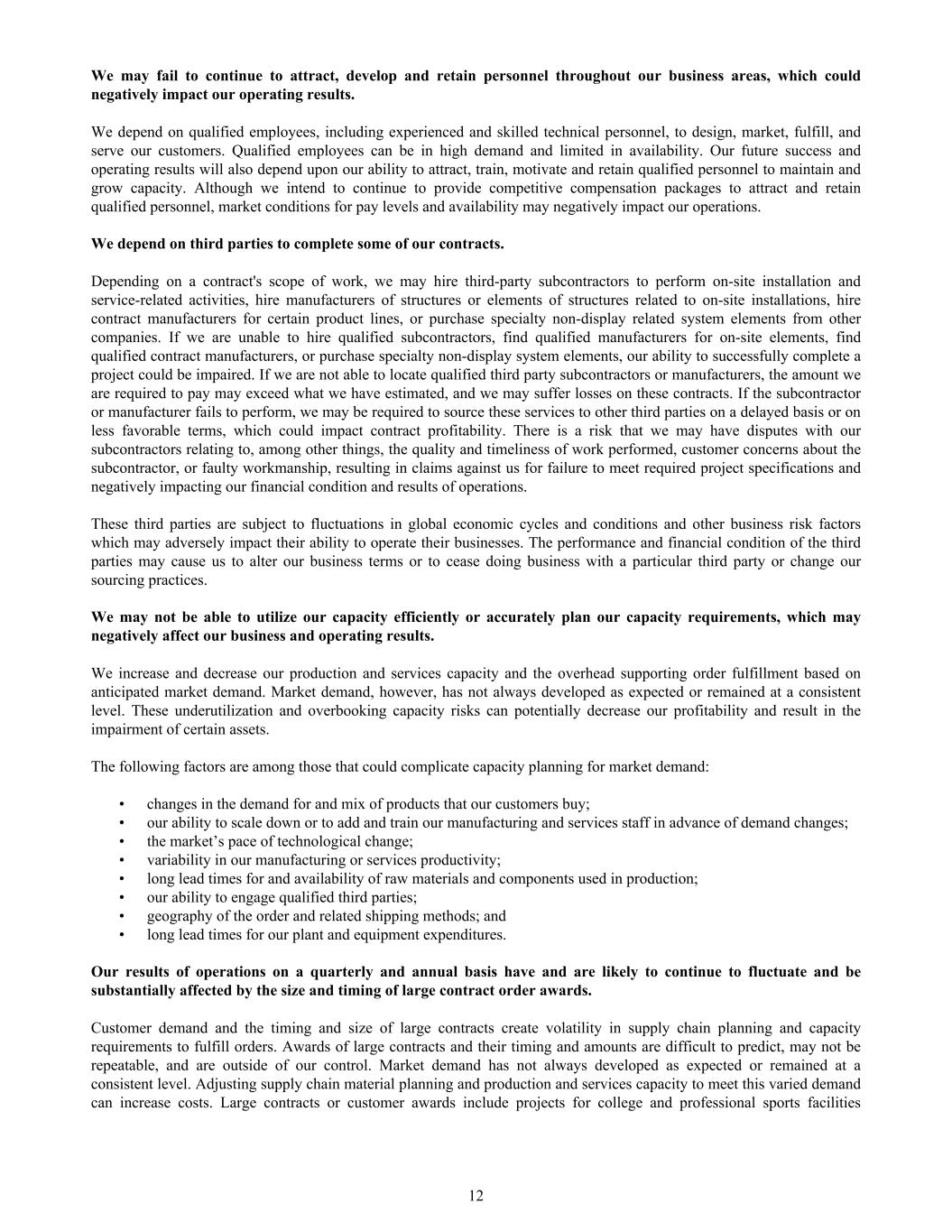
We may fail to continue to attract, develop and retain personnel throughout our business areas, which could negatively impact our operating results. We depend on qualified employees, including experienced and skilled technical personnel, to design, market, fulfill, and serve our customers. Qualified employees can be in high demand and limited in availability. Our future success and operating results will also depend upon our ability to attract, train, motivate and retain qualified personnel to maintain and grow capacity. Although we intend to continue to provide competitive compensation packages to attract and retain qualified personnel, market conditions for pay levels and availability may negatively impact our operations. We depend on third parties to complete some of our contracts. Depending on a contract's scope of work, we may hire third-party subcontractors to perform on-site installation and service-related activities, hire manufacturers of structures or elements of structures related to on-site installations, hire contract manufacturers for certain product lines, or purchase specialty non-display related system elements from other companies. If we are unable to hire qualified subcontractors, find qualified manufacturers for on-site elements, find qualified contract manufacturers, or purchase specialty non-display system elements, our ability to successfully complete a project could be impaired. If we are not able to locate qualified third party subcontractors or manufacturers, the amount we are required to pay may exceed what we have estimated, and we may suffer losses on these contracts. If the subcontractor or manufacturer fails to perform, we may be required to source these services to other third parties on a delayed basis or on less favorable terms, which could impact contract profitability. There is a risk that we may have disputes with our subcontractors relating to, among other things, the quality and timeliness of work performed, customer concerns about the subcontractor, or faulty workmanship, resulting in claims against us for failure to meet required project specifications and negatively impacting our financial condition and results of operations. These third parties are subject to fluctuations in global economic cycles and conditions and other business risk factors which may adversely impact their ability to operate their businesses. The performance and financial condition of the third parties may cause us to alter our business terms or to cease doing business with a particular third party or change our sourcing practices. We may not be able to utilize our capacity efficiently or accurately plan our capacity requirements, which may negatively affect our business and operating results. We increase and decrease our production and services capacity and the overhead supporting order fulfillment based on anticipated market demand. Market demand, however, has not always developed as expected or remained at a consistent level. These underutilization and overbooking capacity risks can potentially decrease our profitability and result in the impairment of certain assets. The following factors are among those that could complicate capacity planning for market demand: • changes in the demand for and mix of products that our customers buy; • our ability to scale down or to add and train our manufacturing and services staff in advance of demand changes; • the market’s pace of technological change; • variability in our manufacturing or services productivity; • long lead times for and availability of raw materials and components used in production; • our ability to engage qualified third parties; • geography of the order and related shipping methods; and • long lead times for our plant and equipment expenditures. Our results of operations on a quarterly and annual basis have and are likely to continue to fluctuate and be substantially affected by the size and timing of large contract order awards. Customer demand and the timing and size of large contracts create volatility in supply chain planning and capacity requirements to fulfill orders. Awards of large contracts and their timing and amounts are difficult to predict, may not be repeatable, and are outside of our control. Market demand has not always developed as expected or remained at a consistent level. Adjusting supply chain material planning and production and services capacity to meet this varied demand can increase costs. Large contracts or customer awards include projects for college and professional sports facilities 12
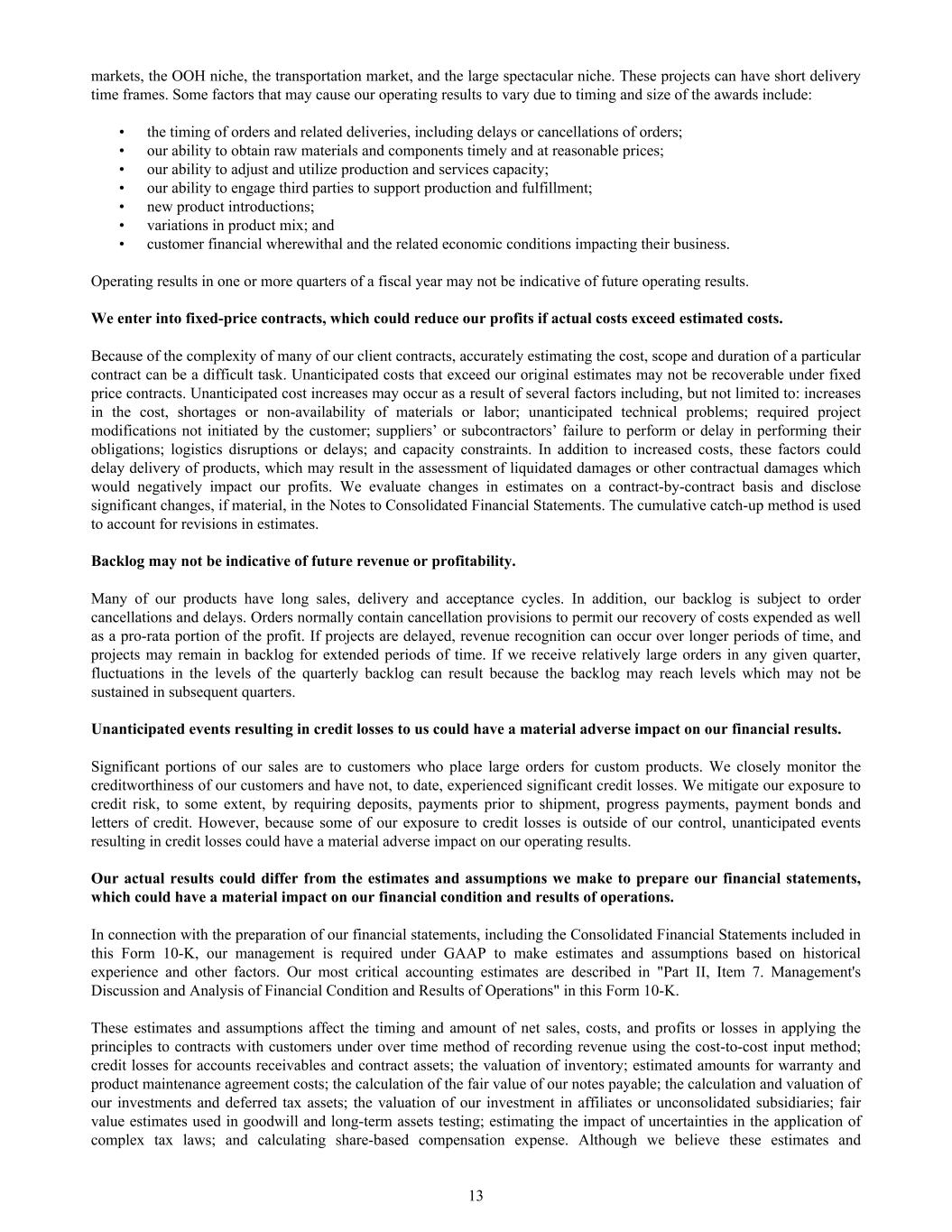
markets, the OOH niche, the transportation market, and the large spectacular niche. These projects can have short delivery time frames. Some factors that may cause our operating results to vary due to timing and size of the awards include: • the timing of orders and related deliveries, including delays or cancellations of orders; • our ability to obtain raw materials and components timely and at reasonable prices; • our ability to adjust and utilize production and services capacity; • our ability to engage third parties to support production and fulfillment; • new product introductions; • variations in product mix; and • customer financial wherewithal and the related economic conditions impacting their business. Operating results in one or more quarters of a fiscal year may not be indicative of future operating results. We enter into fixed-price contracts, which could reduce our profits if actual costs exceed estimated costs. Because of the complexity of many of our client contracts, accurately estimating the cost, scope and duration of a particular contract can be a difficult task. Unanticipated costs that exceed our original estimates may not be recoverable under fixed price contracts. Unanticipated cost increases may occur as a result of several factors including, but not limited to: increases in the cost, shortages or non-availability of materials or labor; unanticipated technical problems; required project modifications not initiated by the customer; suppliers’ or subcontractors’ failure to perform or delay in performing their obligations; logistics disruptions or delays; and capacity constraints. In addition to increased costs, these factors could delay delivery of products, which may result in the assessment of liquidated damages or other contractual damages which would negatively impact our profits. We evaluate changes in estimates on a contract-by-contract basis and disclose significant changes, if material, in the Notes to Consolidated Financial Statements. The cumulative catch-up method is used to account for revisions in estimates. Backlog may not be indicative of future revenue or profitability. Many of our products have long sales, delivery and acceptance cycles. In addition, our backlog is subject to order cancellations and delays. Orders normally contain cancellation provisions to permit our recovery of costs expended as well as a pro-rata portion of the profit. If projects are delayed, revenue recognition can occur over longer periods of time, and projects may remain in backlog for extended periods of time. If we receive relatively large orders in any given quarter, fluctuations in the levels of the quarterly backlog can result because the backlog may reach levels which may not be sustained in subsequent quarters. Unanticipated events resulting in credit losses to us could have a material adverse impact on our financial results. Significant portions of our sales are to customers who place large orders for custom products. We closely monitor the creditworthiness of our customers and have not, to date, experienced significant credit losses. We mitigate our exposure to credit risk, to some extent, by requiring deposits, payments prior to shipment, progress payments, payment bonds and letters of credit. However, because some of our exposure to credit losses is outside of our control, unanticipated events resulting in credit losses could have a material adverse impact on our operating results. Our actual results could differ from the estimates and assumptions we make to prepare our financial statements, which could have a material impact on our financial condition and results of operations. In connection with the preparation of our financial statements, including the Consolidated Financial Statements included in this Form 10-K, our management is required under GAAP to make estimates and assumptions based on historical experience and other factors. Our most critical accounting estimates are described in "Part II, Item 7. Management's Discussion and Analysis of Financial Condition and Results of Operations" in this Form 10-K. These estimates and assumptions affect the timing and amount of net sales, costs, and profits or losses in applying the principles to contracts with customers under over time method of recording revenue using the cost-to-cost input method; credit losses for accounts receivables and contract assets; the valuation of inventory; estimated amounts for warranty and product maintenance agreement costs; the calculation of the fair value of our notes payable; the calculation and valuation of our investments and deferred tax assets; the valuation of our investment in affiliates or unconsolidated subsidiaries; fair value estimates used in goodwill and long-term assets testing; estimating the impact of uncertainties in the application of complex tax laws; and calculating share-based compensation expense. Although we believe these estimates and 13
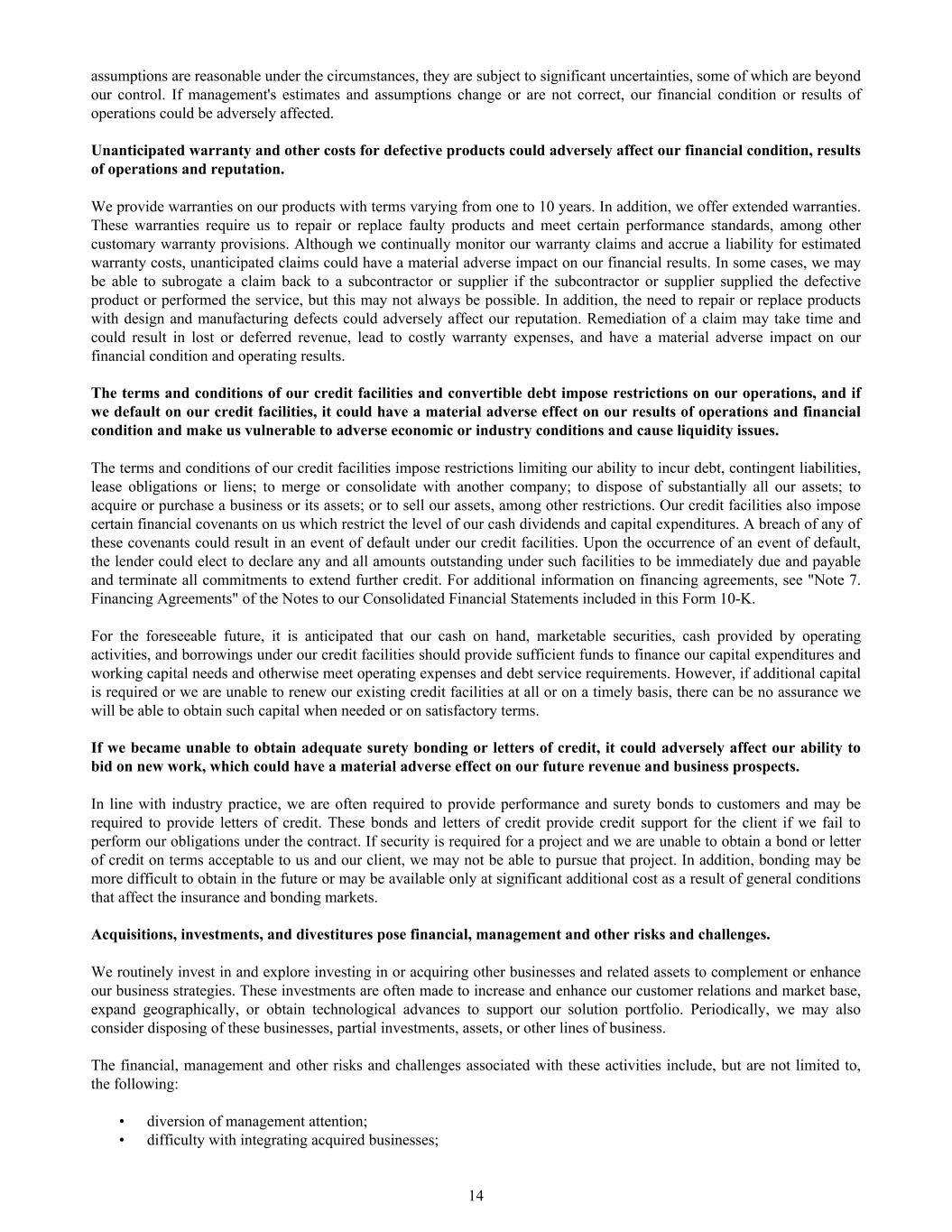
assumptions are reasonable under the circumstances, they are subject to significant uncertainties, some of which are beyond our control. If management's estimates and assumptions change or are not correct, our financial condition or results of operations could be adversely affected. Unanticipated warranty and other costs for defective products could adversely affect our financial condition, results of operations and reputation. We provide warranties on our products with terms varying from one to 10 years. In addition, we offer extended warranties. These warranties require us to repair or replace faulty products and meet certain performance standards, among other customary warranty provisions. Although we continually monitor our warranty claims and accrue a liability for estimated warranty costs, unanticipated claims could have a material adverse impact on our financial results. In some cases, we may be able to subrogate a claim back to a subcontractor or supplier if the subcontractor or supplier supplied the defective product or performed the service, but this may not always be possible. In addition, the need to repair or replace products with design and manufacturing defects could adversely affect our reputation. Remediation of a claim may take time and could result in lost or deferred revenue, lead to costly warranty expenses, and have a material adverse impact on our financial condition and operating results. The terms and conditions of our credit facilities and convertible debt impose restrictions on our operations, and if we default on our credit facilities, it could have a material adverse effect on our results of operations and financial condition and make us vulnerable to adverse economic or industry conditions and cause liquidity issues. The terms and conditions of our credit facilities impose restrictions limiting our ability to incur debt, contingent liabilities, lease obligations or liens; to merge or consolidate with another company; to dispose of substantially all our assets; to acquire or purchase a business or its assets; or to sell our assets, among other restrictions. Our credit facilities also impose certain financial covenants on us which restrict the level of our cash dividends and capital expenditures. A breach of any of these covenants could result in an event of default under our credit facilities. Upon the occurrence of an event of default, the lender could elect to declare any and all amounts outstanding under such facilities to be immediately due and payable and terminate all commitments to extend further credit. For additional information on financing agreements, see "Note 7. Financing Agreements" of the Notes to our Consolidated Financial Statements included in this Form 10-K. For the foreseeable future, it is anticipated that our cash on hand, marketable securities, cash provided by operating activities, and borrowings under our credit facilities should provide sufficient funds to finance our capital expenditures and working capital needs and otherwise meet operating expenses and debt service requirements. However, if additional capital is required or we are unable to renew our existing credit facilities at all or on a timely basis, there can be no assurance we will be able to obtain such capital when needed or on satisfactory terms. If we became unable to obtain adequate surety bonding or letters of credit, it could adversely affect our ability to bid on new work, which could have a material adverse effect on our future revenue and business prospects. In line with industry practice, we are often required to provide performance and surety bonds to customers and may be required to provide letters of credit. These bonds and letters of credit provide credit support for the client if we fail to perform our obligations under the contract. If security is required for a project and we are unable to obtain a bond or letter of credit on terms acceptable to us and our client, we may not be able to pursue that project. In addition, bonding may be more difficult to obtain in the future or may be available only at significant additional cost as a result of general conditions that affect the insurance and bonding markets. Acquisitions, investments, and divestitures pose financial, management and other risks and challenges. We routinely invest in and explore investing in or acquiring other businesses and related assets to complement or enhance our business strategies. These investments are often made to increase and enhance our customer relations and market base, expand geographically, or obtain technological advances to support our solution portfolio. Periodically, we may also consider disposing of these businesses, partial investments, assets, or other lines of business. The financial, management and other risks and challenges associated with these activities include, but are not limited to, the following: • diversion of management attention; • difficulty with integrating acquired businesses; 14
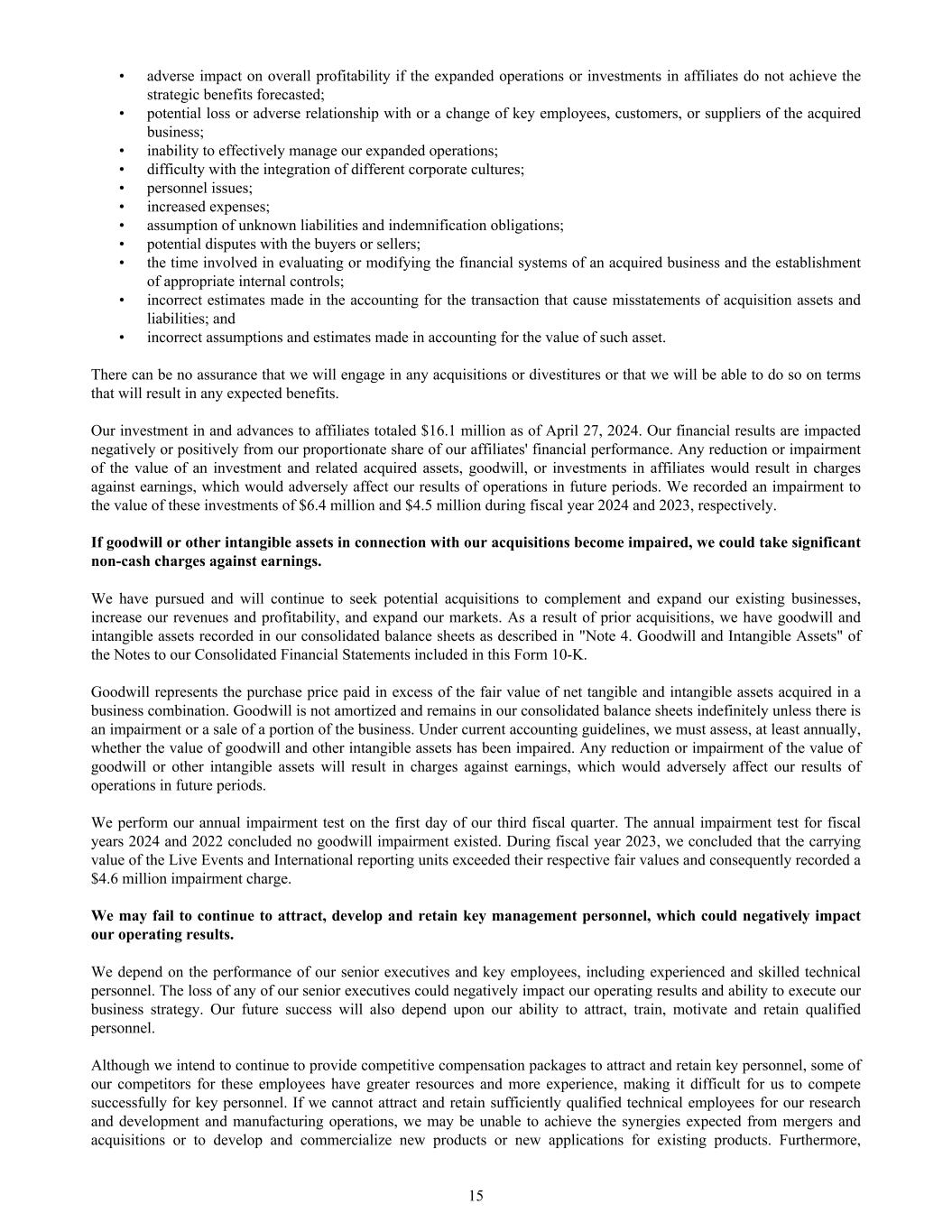
• adverse impact on overall profitability if the expanded operations or investments in affiliates do not achieve the strategic benefits forecasted; • potential loss or adverse relationship with or a change of key employees, customers, or suppliers of the acquired business; • inability to effectively manage our expanded operations; • difficulty with the integration of different corporate cultures; • personnel issues; • increased expenses; • assumption of unknown liabilities and indemnification obligations; • potential disputes with the buyers or sellers; • the time involved in evaluating or modifying the financial systems of an acquired business and the establishment of appropriate internal controls; • incorrect estimates made in the accounting for the transaction that cause misstatements of acquisition assets and liabilities; and • incorrect assumptions and estimates made in accounting for the value of such asset. There can be no assurance that we will engage in any acquisitions or divestitures or that we will be able to do so on terms that will result in any expected benefits. Our investment in and advances to affiliates totaled $16.1 million as of April 27, 2024. Our financial results are impacted negatively or positively from our proportionate share of our affiliates' financial performance. Any reduction or impairment of the value of an investment and related acquired assets, goodwill, or investments in affiliates would result in charges against earnings, which would adversely affect our results of operations in future periods. We recorded an impairment to the value of these investments of $6.4 million and $4.5 million during fiscal year 2024 and 2023, respectively. If goodwill or other intangible assets in connection with our acquisitions become impaired, we could take significant non-cash charges against earnings. We have pursued and will continue to seek potential acquisitions to complement and expand our existing businesses, increase our revenues and profitability, and expand our markets. As a result of prior acquisitions, we have goodwill and intangible assets recorded in our consolidated balance sheets as described in "Note 4. Goodwill and Intangible Assets" of the Notes to our Consolidated Financial Statements included in this Form 10-K. Goodwill represents the purchase price paid in excess of the fair value of net tangible and intangible assets acquired in a business combination. Goodwill is not amortized and remains in our consolidated balance sheets indefinitely unless there is an impairment or a sale of a portion of the business. Under current accounting guidelines, we must assess, at least annually, whether the value of goodwill and other intangible assets has been impaired. Any reduction or impairment of the value of goodwill or other intangible assets will result in charges against earnings, which would adversely affect our results of operations in future periods. We perform our annual impairment test on the first day of our third fiscal quarter. The annual impairment test for fiscal years 2024 and 2022 concluded no goodwill impairment existed. During fiscal year 2023, we concluded that the carrying value of the Live Events and International reporting units exceeded their respective fair values and consequently recorded a $4.6 million impairment charge. We may fail to continue to attract, develop and retain key management personnel, which could negatively impact our operating results. We depend on the performance of our senior executives and key employees, including experienced and skilled technical personnel. The loss of any of our senior executives could negatively impact our operating results and ability to execute our business strategy. Our future success will also depend upon our ability to attract, train, motivate and retain qualified personnel. Although we intend to continue to provide competitive compensation packages to attract and retain key personnel, some of our competitors for these employees have greater resources and more experience, making it difficult for us to compete successfully for key personnel. If we cannot attract and retain sufficiently qualified technical employees for our research and development and manufacturing operations, we may be unable to achieve the synergies expected from mergers and acquisitions or to develop and commercialize new products or new applications for existing products. Furthermore, 15

possible shortages of key personnel, including engineers, could require us to pay more to hire and retain key personnel, thereby increasing our costs. Increases in the cost of employee benefits could impact our financial results and cash flows. Our expenses relating to employee health benefits are significant. Unfavorable changes in the cost of and the unpredictability of claims under such benefits, including the current inflationary pressures on wages and benefits, could negatively impact our financial results and cash flows. Although we purchase stop loss insurance, its cost and healthcare costs have risen significantly in recent years. Legislative and private sector initiatives regarding healthcare reform could result in significant changes to the United States healthcare system. Due to the breadth and complexity of the healthcare reform legislation and the uncertainty surrounding further reform proposals, we are not able to fully determine the impact that healthcare reform will have in the future on company sponsored medical plans. The outcome of pending and future claims, investigations or litigation can have a material adverse impact on our business, financial condition, and results of operations. We are involved from time to time in a variety of litigation, investigations, inquires or similar matters arising in our business. Litigation, investigations and regulatory proceedings are subject to inherent uncertainties, and unfavorable rulings and outcomes can and do occur. Pending or future claims against us could result in professional liability, product liability, criminal liability, warranty obligations, indemnity claims, or other liabilities to the extent we are not insured against a loss or our insurance fails to provide adequate coverage. Also, a well-publicized actual or perceived threat of litigation could adversely affect our reputation and reduce the demand for our products. See "Note 16. Commitments and Contingencies" of the Notes to our Consolidated Financial Statements included in this Form 10-K for further information on litigation obligations. Information Systems, Legal, and Regulatory Risks Our business depends on numerous complex information systems. Any failure to maintain these systems, a network disruption, or breaches in data security could cause a material adverse effect on our business. We rely heavily on complex information systems for the successful operation of our business, for the support of our offerings, and for the collection and retention of business data. Any information system failure of or breach in security could adversely affect our operations, at least until our data can be restored and/or the breaches remediated. Despite the security measures we have in place, our facilities and systems and those of our third-party service providers may be vulnerable to cybersecurity breaches, acts of vandalism, computer viruses, misplaced or lost data, ransomware attacks, programming issues, and/or human errors or other similar events. Any misappropriation, loss or other unauthorized disclosure of confidential or personally identifiable information, whether by us or by our third-party service providers, could adversely affect our business and operations. We could face significant fines and penalties under various global laws revolving around data loss, lack of adequate data protection or lack of required reporting. Any disruption in our digital technologies could affect our business and operations, causing potentially significant expenses to recover and modify the data systems, to reimburse customers' losses, and to investigate and remediate any vulnerabilities, which could severely damage our reputation with customers, suppliers, employees and investors and expose us to risk of litigation and liability. Our global operations expose us to global regulatory, geopolitical, economic and social changes and add additional risks and uncertainties which can harm our business, operating results, and financial condition. Our domestic and foreign operations, sales, earnings, and strategies for profitable growth can be adversely affected by global conditions and compliance with global regulations and governmental orders. Global conditions include political developments; economic changes; unfavorable trading policies; difficulties in staffing and managing global operations; changes in foreign and domestic governmental regulations or requirements, treaty and trade relationships; the imposition of government orders that differ among jurisdictions, including mandatory closures, work-from-home and lock-down orders and social distancing protocols; changes in monetary and fiscal policies; changes in laws and regulations; or other activities of the United States and other foreign governments, agencies, and similar organizations. These conditions include, but are not limited to, changes in a country's or region's economic or political conditions; pricing and marketing of products; local labor conditions and regulations; reduced protection of intellectual property rights; changes in the regulatory or legal environment; lack of well-developed legal systems; restrictions and foreign exchange rate fluctuations; and burdensome taxes and tariffs and other trade regulations or barriers. Other exposures and uncertainties that exist include changing social conditions and attitudes, terrorism, or political hostilities and war. Other difficulties of global operations include staffing 16
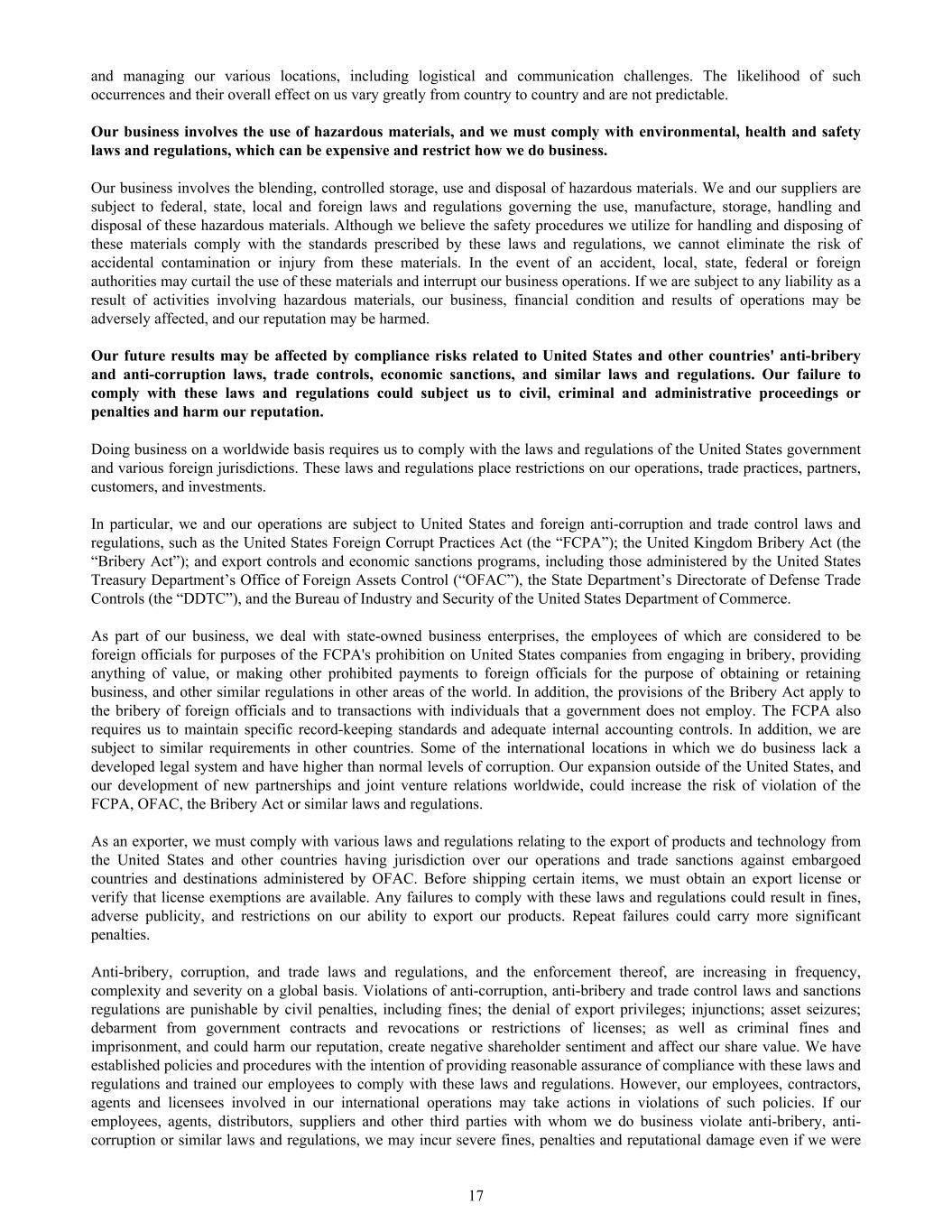
and managing our various locations, including logistical and communication challenges. The likelihood of such occurrences and their overall effect on us vary greatly from country to country and are not predictable. Our business involves the use of hazardous materials, and we must comply with environmental, health and safety laws and regulations, which can be expensive and restrict how we do business. Our business involves the blending, controlled storage, use and disposal of hazardous materials. We and our suppliers are subject to federal, state, local and foreign laws and regulations governing the use, manufacture, storage, handling and disposal of these hazardous materials. Although we believe the safety procedures we utilize for handling and disposing of these materials comply with the standards prescribed by these laws and regulations, we cannot eliminate the risk of accidental contamination or injury from these materials. In the event of an accident, local, state, federal or foreign authorities may curtail the use of these materials and interrupt our business operations. If we are subject to any liability as a result of activities involving hazardous materials, our business, financial condition and results of operations may be adversely affected, and our reputation may be harmed. Our future results may be affected by compliance risks related to United States and other countries' anti-bribery and anti-corruption laws, trade controls, economic sanctions, and similar laws and regulations. Our failure to comply with these laws and regulations could subject us to civil, criminal and administrative proceedings or penalties and harm our reputation. Doing business on a worldwide basis requires us to comply with the laws and regulations of the United States government and various foreign jurisdictions. These laws and regulations place restrictions on our operations, trade practices, partners, customers, and investments. In particular, we and our operations are subject to United States and foreign anti-corruption and trade control laws and regulations, such as the United States Foreign Corrupt Practices Act (the “FCPA”); the United Kingdom Bribery Act (the “Bribery Act”); and export controls and economic sanctions programs, including those administered by the United States Treasury Department’s Office of Foreign Assets Control (“OFAC”), the State Department’s Directorate of Defense Trade Controls (the “DDTC”), and the Bureau of Industry and Security of the United States Department of Commerce. As part of our business, we deal with state-owned business enterprises, the employees of which are considered to be foreign officials for purposes of the FCPA's prohibition on United States companies from engaging in bribery, providing anything of value, or making other prohibited payments to foreign officials for the purpose of obtaining or retaining business, and other similar regulations in other areas of the world. In addition, the provisions of the Bribery Act apply to the bribery of foreign officials and to transactions with individuals that a government does not employ. The FCPA also requires us to maintain specific record-keeping standards and adequate internal accounting controls. In addition, we are subject to similar requirements in other countries. Some of the international locations in which we do business lack a developed legal system and have higher than normal levels of corruption. Our expansion outside of the United States, and our development of new partnerships and joint venture relations worldwide, could increase the risk of violation of the FCPA, OFAC, the Bribery Act or similar laws and regulations. As an exporter, we must comply with various laws and regulations relating to the export of products and technology from the United States and other countries having jurisdiction over our operations and trade sanctions against embargoed countries and destinations administered by OFAC. Before shipping certain items, we must obtain an export license or verify that license exemptions are available. Any failures to comply with these laws and regulations could result in fines, adverse publicity, and restrictions on our ability to export our products. Repeat failures could carry more significant penalties. Anti-bribery, corruption, and trade laws and regulations, and the enforcement thereof, are increasing in frequency, complexity and severity on a global basis. Violations of anti-corruption, anti-bribery and trade control laws and sanctions regulations are punishable by civil penalties, including fines; the denial of export privileges; injunctions; asset seizures; debarment from government contracts and revocations or restrictions of licenses; as well as criminal fines and imprisonment, and could harm our reputation, create negative shareholder sentiment and affect our share value. We have established policies and procedures with the intention of providing reasonable assurance of compliance with these laws and regulations and trained our employees to comply with these laws and regulations. However, our employees, contractors, agents and licensees involved in our international operations may take actions in violations of such policies. If our employees, agents, distributors, suppliers and other third parties with whom we do business violate anti-bribery, anti- corruption or similar laws and regulations, we may incur severe fines, penalties and reputational damage even if we were 17

not aware of such violation. Additionally, there can be no assurance that our policies and procedures will effectively prevent us from violating these regulations in every transaction in which we may engage or provide a defense to any alleged violation. In particular, we may be held liable for the actions that our partners take inside or outside of the United States even though we are not aware of such actions or our partners may not be subject to these laws. Such a violation, even if our policies prohibit it, could have an adverse effect on our reputation, business, financial condition and results of operations. In addition, various state and municipal governments, universities and other investors maintain prohibitions or restrictions on investments in companies that do business with sanctioned countries, persons and entities, which could adversely affect our reputation, business, financial condition and results of operations. Regulation in the areas of privacy, data protection and information security could increase our costs and affect or limit our business opportunities and how we collect or use personal information. As privacy, data protection and information security laws, including data localization laws, are interpreted and applied, compliance costs may increase, particularly in the context of ensuring that adequate data protection and data transfer mechanisms are in place. In recent years, there have been increasing regulatory enforcement and litigation activities in the areas of privacy, data protection and information security in the United States and in various countries in which we operate. In addition, state and federal legislators and/or regulators in the United States and other countries in which we operate are increasingly adopting or revising privacy, data protection and information security laws that potentially could have a significant impact on our current and planned privacy, data protection and information security-related practices; our collection, use, sharing, retention and safeguarding of consumer and/or employee information; and some of our current or planned business activities. New legislation or regulation could increase our costs of compliance and business operations and could reduce revenues from certain business initiatives. Moreover, the application of existing or new laws to existing technology and practices can be uncertain and may lead to additional compliance risk and cost. Compliance with current or future privacy, data protection and information security laws relating to consumer and/or employee data, including the General Data Protection Regulation in the European Union and similar laws in other regions of the world, including the United States, could result in higher compliance and technology costs and could restrict our ability to provide certain products and services, which could materially and adversely affect our results of operations. Our failure to comply with privacy, data protection and information security laws could result in potentially significant regulatory and/or governmental investigations and/or actions, litigation, fines, sanctions, ongoing regulatory monitoring, customer attrition, customer indemnity claims, decreases in the use or acceptance of our products and services, and damage to our reputation and our brand. Environmental, society, and governance ("ESG") regulations and disclosures may impact our reputation, expose us to additional costs, or have other impacts which could adversely affect our business, financial condition, or results of operations. There has been an increased focus from regulators, investors, employees, consumers, and other stakeholders relating to ESG practices. We periodically communicate our ESG initiatives, which include prioritizing people, community, environmental, and product stewardship. Certain market participants, including major institutional investors, proxy advisory firms and capital providers, use benchmarks and scores to assess companies’ ESG profiles in making investment or revoting decisions or recommending voting positions. We have limited and in some instances no visibility or control over these scores or their underlying methodologies. Unfavorable ESG ratings could lead to increased negative investor sentiment towards us or our industry, which could negatively impact our share price as well as our access to and cost of capital. To the extent ESG matters negatively impact our reputation, it may also impede our ability to compete as effectively to attract and retain employees or customers, which may adversely impact our operations. Simultaneously, there are efforts by some stakeholders to reduce companies’ efforts on certain ESG-related matters. Both advocates and opponents to certain ESG matters are increasingly resorting to a range of activism forms, including media campaigns and litigation, to advance their perspectives. In addition, this emphasis on ESG matters has resulted and may result in the adoption of new laws and regulations, including new reporting requirements. Our failure to respond to regulatory requirements or to advance our initiatives could adversely impact our reputation, as well as the demand for our products. In addition, achieving these initiatives may result in increased costs, which could have a material adverse impact on our business, financial condition, or results of operations. Global tax law changes may adversely affect our business, financial condition and results of operations. We are subject to the income tax laws of the United States and its various state and local governments as well as several foreign tax jurisdictions. Our future income taxes could be materially adversely affected by changes in the amount or mix 18

of earnings amongst countries with differing statutory tax rates, changes in the valuation of deferred tax assets and liabilities, changes in tax rates or the interpretation of tax rules and regulations in jurisdictions in which we do business, changes in tax laws, or the outcome of income tax audits and any related litigation. The United States Tax Cuts and Jobs Act of 2017 is one such example of legislation that has impacted our effective tax rate. Further changes in the tax laws of the United States and foreign jurisdictions could arise, including additional tax reform in the United States and the base erosion and profit shifting project undertaken by the Organization for Economic Co- operation and Development (“OECD”). Both the United States tax reform and the OECD proposed recommendations which, in some cases, would make substantial changes to numerous long-standing tax positions and principles. These contemplated changes could increase tax uncertainty and may adversely affect our business, financial condition and results of operations. Ineffective internal control over financial reporting could result in errors in our financial statements, reduce investor confidence, and adversely impact our stock price. Under Section 404 of the Sarbanes-Oxley Act of 2002, we are required to evaluate and determine the effectiveness of our internal controls over financial reporting. Ineffective internal control over financial reporting could result in errors in our financial statements, reduce investor confidence, and adversely affect our stock price. As discussed in Part II, Item 9A “Controls and Procedures” in this Form 10-K, during the year-end closing processes for fiscal 2023, we identified a material weakness in our internal control related to the ineffective operation of certain transactional level controls over revenue recognition, specifically related to revenue contracts recognized over time, which resulted from insufficient precision of processes and insufficient training of the relevant control operators. These internal controls are important to accurately reflect our financial position and results of operations in our financial reports. We performed additional procedures over contracts for which revenue is recognized over time, including leveraging the expertise of a third-party specialist, and we did not identify any material errors in our reported revenue balance. However, due to the material weakness described above, there was a reasonable possibility that our existing controls would not have detected a material misstatement in a timely manner if it were to be material. Management has determined, through its current year testing, that the Company's enhanced policy and control activities were designed and operated effectively for a sufficient period of time during fiscal year 2024 to conclude that the previously identified material weakness has been remediated as of April 27, 2024. In the future, if we identify additional control deficiencies that individually or together constitute significant deficiencies or material weaknesses, our ability to accurately record, process, and report financial information and, consequently, our ability to prepare financial statements within required time periods, could be adversely affected. Our failure to maintain effective internal control over financial reporting could result in violations of applicable securities laws and stock exchange listing requirements; subject us to litigation and investigations; negatively affect investor confidence in our financial statements; and adversely impact our stock price and ability to access capital markets. Insurance coverage can be difficult or expensive to obtain, and our failure to obtain adequate insurance coverage could adversely affect our financial condition or results of operations. We maintain insurance both as a corporate risk management strategy and to satisfy the requirements of many of our contracts with customers. As the costs and availability of insurance change, we may decide not to be covered against certain losses where, in the judgment of management, the insurance is not warranted due to the cost or availability of coverage or the remoteness of the perceived risk. We cannot provide assurance that all necessary or appropriate insurances will be available, cover every type of loss incurred, or be able to be economically obtained. For example, some insurers limit or refuse coverages, increase premium costs or increase deductibles when global catastrophic events occur. As part of our corporate risk management strategy, we monitor and place our coverages with financially strong insurers, layer our risk with multiple insurers, and seek advice on the amount, breadth and type of insurance coverages to protect our interests. We also contractually require subcontractors and others working on our behalf to carry common insurance coverages for the types of work they perform to mitigate any risk of our loss. Our failure to obtain adequate insurance coverage at reasonable costs could adversely affect our financial condition or results of operations. 19
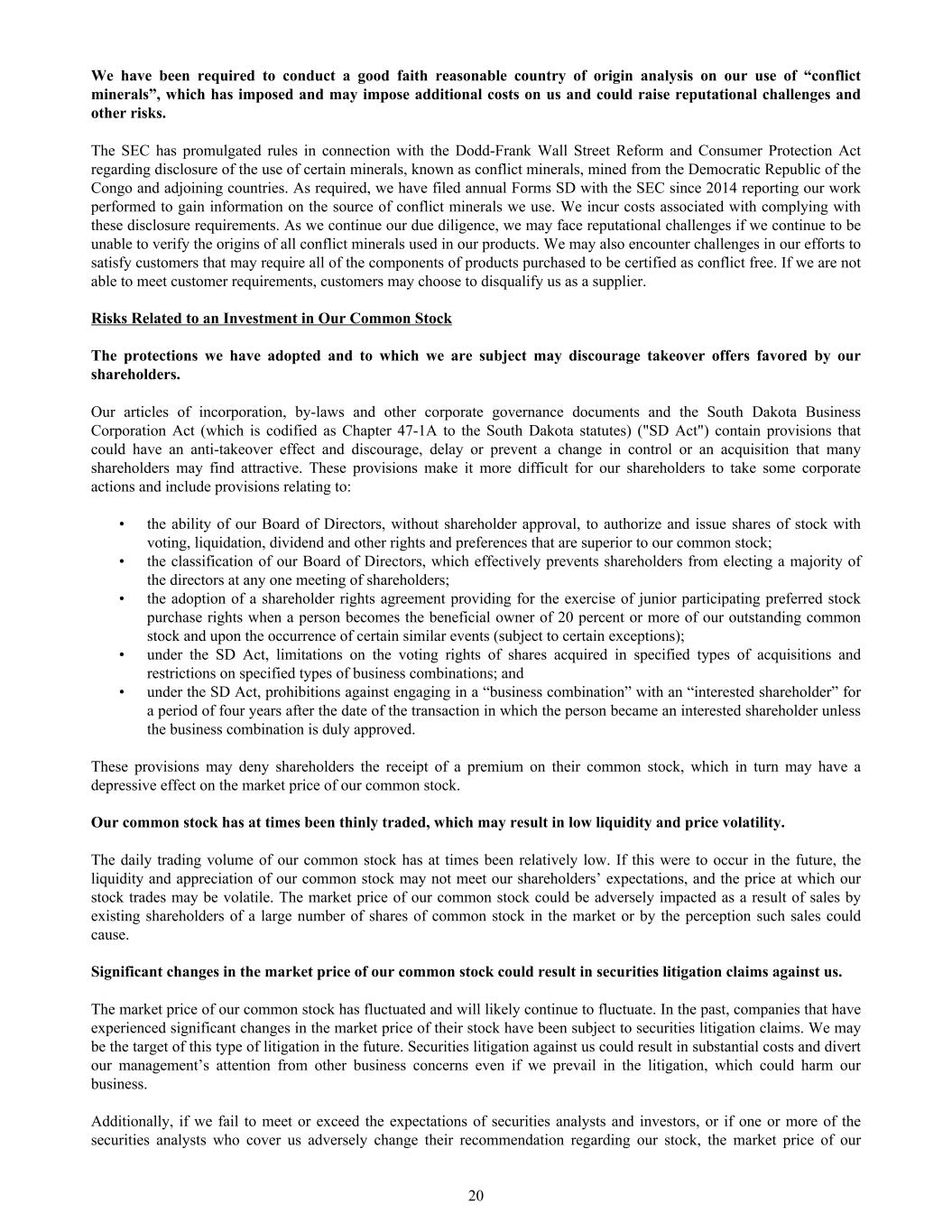
We have been required to conduct a good faith reasonable country of origin analysis on our use of “conflict minerals”, which has imposed and may impose additional costs on us and could raise reputational challenges and other risks. The SEC has promulgated rules in connection with the Dodd-Frank Wall Street Reform and Consumer Protection Act regarding disclosure of the use of certain minerals, known as conflict minerals, mined from the Democratic Republic of the Congo and adjoining countries. As required, we have filed annual Forms SD with the SEC since 2014 reporting our work performed to gain information on the source of conflict minerals we use. We incur costs associated with complying with these disclosure requirements. As we continue our due diligence, we may face reputational challenges if we continue to be unable to verify the origins of all conflict minerals used in our products. We may also encounter challenges in our efforts to satisfy customers that may require all of the components of products purchased to be certified as conflict free. If we are not able to meet customer requirements, customers may choose to disqualify us as a supplier. Risks Related to an Investment in Our Common Stock The protections we have adopted and to which we are subject may discourage takeover offers favored by our shareholders. Our articles of incorporation, by-laws and other corporate governance documents and the South Dakota Business Corporation Act (which is codified as Chapter 47-1A to the South Dakota statutes) ("SD Act") contain provisions that could have an anti-takeover effect and discourage, delay or prevent a change in control or an acquisition that many shareholders may find attractive. These provisions make it more difficult for our shareholders to take some corporate actions and include provisions relating to: • the ability of our Board of Directors, without shareholder approval, to authorize and issue shares of stock with voting, liquidation, dividend and other rights and preferences that are superior to our common stock; • the classification of our Board of Directors, which effectively prevents shareholders from electing a majority of the directors at any one meeting of shareholders; • the adoption of a shareholder rights agreement providing for the exercise of junior participating preferred stock purchase rights when a person becomes the beneficial owner of 20 percent or more of our outstanding common stock and upon the occurrence of certain similar events (subject to certain exceptions); • under the SD Act, limitations on the voting rights of shares acquired in specified types of acquisitions and restrictions on specified types of business combinations; and • under the SD Act, prohibitions against engaging in a “business combination” with an “interested shareholder” for a period of four years after the date of the transaction in which the person became an interested shareholder unless the business combination is duly approved. These provisions may deny shareholders the receipt of a premium on their common stock, which in turn may have a depressive effect on the market price of our common stock. Our common stock has at times been thinly traded, which may result in low liquidity and price volatility. The daily trading volume of our common stock has at times been relatively low. If this were to occur in the future, the liquidity and appreciation of our common stock may not meet our shareholders’ expectations, and the price at which our stock trades may be volatile. The market price of our common stock could be adversely impacted as a result of sales by existing shareholders of a large number of shares of common stock in the market or by the perception such sales could cause. Significant changes in the market price of our common stock could result in securities litigation claims against us. The market price of our common stock has fluctuated and will likely continue to fluctuate. In the past, companies that have experienced significant changes in the market price of their stock have been subject to securities litigation claims. We may be the target of this type of litigation in the future. Securities litigation against us could result in substantial costs and divert our management’s attention from other business concerns even if we prevail in the litigation, which could harm our business. Additionally, if we fail to meet or exceed the expectations of securities analysts and investors, or if one or more of the securities analysts who cover us adversely change their recommendation regarding our stock, the market price of our 20

common stock could decline. Moreover, our stock price may be based on expectations, estimates and forecasts of our future performance that may be unrealistic or that may not be met. Further, our stock price may fluctuate based on reporting by the financial media, including television, radio, press reports and blogs. Our business could be negatively affected as a result of actions of activist shareholders, and such activism could impact the trading value of our securities. Responding to actions by activist shareholders can be costly and time-consuming, and impact our brand, disrupt our operations and divert the attention of management and our employees. Such activities could interfere with our ability to execute our strategic plan. In addition, a proxy contest for the election of directors would require us to incur significant legal fees and proxy solicitation expenses and require significant time and attention by management and our board of directors. The perceived uncertainties as to our future direction also could affect the market price and volatility of our securities. Our executive officers, directors and principal shareholders have the ability to significantly influence all matters submitted to our shareholders for approval. Co-founder Dr. Aelred Kurtenbach served as our Chairman of the Board until September 3, 2014. Dr. Aelred Kurtenbach's family members currently serve as executive officers of the Company. His son, Mr. Reece Kurtenbach, serves as our Chairman of the Board and Chief Executive Officer, and two other children serve as our Vice President of Human Resources and as our Vice President of Manufacturing. Together, these individuals, in the aggregate, beneficially owned 10.0 percent of our outstanding common stock as of June 3, 2024, assuming the exercise by them of all of their options that were currently exercisable or that vest within 60 days of June 3, 2024. Our other executive officers and directors, in the aggregate, beneficially owned an additional 4.1 percent of our outstanding common stock as of June 3, 2024, assuming the exercise by them of all of their options currently exercisable or that vest within 60 days of June 3, 2024. Although this does not represent a majority of our outstanding common stock, if these shareholders were to choose to act together, they would be able to significantly influence all matters submitted to our shareholders for approval, as well as our management and affairs. For example, these persons, if they choose to act together, could significantly influence the election of directors and the approval of any merger, consolidation, sale of all or substantially all of our assets or other business combination or reorganization requiring shareholder approval. This concentration of voting power could delay or prevent an acquisition of us on terms that other shareholders may desire. The interests of this group of shareholders may not always coincide with the interests of other shareholders, and they may act in a manner that advances their best interests and not necessarily those of other shareholders, including seeking a premium value for their common stock, that might affect the prevailing market price for our common stock. Item 1B. UNRESOLVED STAFF COMMENTS None. Item 1C. CYBERSECURITY Cybersecurity Risk Management and Strategy The operation of our business is dependent on the secure functioning of our digital information systems and infrastructure. Our cybersecurity risk management program intends to protect the confidentiality, integrity, and availability of our critical systems and information. We design and assess our cybersecurity risk management program based on published frameworks, including the National Institute of Standards and Technology and routinely evaluate our program for ongoing adherence to those frameworks. Our cybersecurity program is aligned with our company strategy and governance processes. Our program is designed to deploy and monitor the prevention, detection, mitigation, and remediation of cyber risks and incidents through various means, including: • A security team responsible for monitoring our infrastructure and managing our cybersecurity risk assessment processes, our security controls, and response to cybersecurity incidents. 21

• Periodic use of outside independent advisors to evaluate the maturity of our cybersecurity program, review processes and policies, conduct penetration and vulnerability tests, and to monitor and help identify potential cybersecurity incidents. • An incident response plan that includes procedures for identifying, evaluating and responding to cybersecurity incidents. • A training and awareness communication series addressed to our employees to help them identify potential cybersecurity threats and attacks. • A risk management process using independent third-party service providers that process and store data. We assess the risks from cybersecurity threats posed by such services. We have not encountered cybersecurity incidents or identified risks from cybersecurity threats that have materially impaired our operations or financial standing. For a discussion of whether and how any risks from cybersecurity threats are reasonably likely to materially affect us, including our business strategy, results of operations or financial condition, refer to Item 1A. Risk Factors – titled "Our business depends on numerous complex information systems. Any failure to maintain these systems, a network disruption, or breaches in data security could cause a material adverse effect on our business", which is incorporated by reference into this Item 1C. Cybersecurity Governance The Strategy and Risk Committee of the Board of Directors oversees the Company’s cybersecurity risks and strategy. A member of the committee has a bachelor and doctoral degrees relevant to and experience in cybersecurity and information technology trends. Management provides the Strategy and Risk Committee periodic reports on cybersecurity risks, risk mitigation in place and planned, and any material cybersecurity incidents. These reports are provided to our Board of Directors. If a material cybersecurity incident were to occur, the Audit Committee would oversee the financial reporting and disclosure and law compliance aspects. Our program and team of cybersecurity professionals and resources is led and supervised by our Vice President of Information Technology, who has over 25 years of experience in information technology. To execute the program, we utilize internal and external technical experts in cybersecurity risk management, data and network security structures, incident response and security operations, and laws, regulation, and reporting requirements. Our cybersecurity team monitors the prevention, detection, mitigation, management, and remediation of cybersecurity risks and incidents through various means, which may include briefings with internal security personnel threat intelligence and other information obtained from governmental, public or private sources, including external consultants engaged by us; and alerts and reports produced by security tools deployed in our information technology environment. As part of the program, our executive management team is regularly informed about the monitoring, prevention, detection, mitigation, management, and remediation efforts. Item 2. PROPERTIES Our principal properties include space for manufacturing products, designing and testing new developments or processes, and employee collaboration space. Our properties are generally aligned with our business segments; however, we manufacture the same products across our manufacturing facilities to efficiently utilize capacity and reduce costs. We consider all our properties to be both suitable and adequate to meet our requirements for the foreseeable future. Our principal properties consist of the following: Facilities Owned or Leased Square Footage Facility Activities Brookings, SD, USA Owned 771,000 Corporate Headquarters, Manufacturing, Sales, Service Redwood Falls, MN, USA Owned 151,000 Manufacturing, Sales, Service, Office Ennistymon, Ireland Owned 62,000 Manufacturing, Sales, Service, Office Sioux Falls, SD, USA Leased 296,000 Manufacturing, Sales, Service, Office Shanghai, China Leased 157,000 Manufacturing, Sales, Service, Office We have a $75.0 million senior credit facility (the "Credit Facility") consisting of a $60.0 million asset-based revolving credit facility (the "ABL") maturing on May 11, 2026 and a $15.0 million delayed draw loan (the "Delayed Draw Loan). 22

Under the Credit Facility, we have encumbered substantially all of our owned real property for the benefit of the lenders thereunder. For additional information, see "Note 7. Financing Agreements" in the Notes to Consolidated Financial Statements included in this Form 10-K. Item 3. LEGAL PROCEEDINGS We are involved in a variety of legal actions relating to various matters during the normal course of business. Although we are unable to predict the ultimate outcome of these legal actions, it is the opinion of management that the disposition of these matters, taken as a whole, will not have a material adverse effect on our financial condition or results of operations. See "Note 16. Commitments and Contingencies" of the Notes to our Consolidated Financial Statements included in this Form 10-K for further information on any legal proceedings and claims. Item 4. MINE SAFETY DISCLOSURES Not applicable. PART II Item 5. MARKET FOR REGISTRANT’S COMMON EQUITY, RELATED STOCKHOLDER MATTERS AND ISSUER PURCHASES OF EQUITY SECURITIES Stock Performance Our common stock is quoted on The Nasdaq Global Select Market under the ticker symbol DAKT. Daily market activity, along with quoted prices and other trading information, are readily available for our common stock on numerous websites including www.nasdaq.com. As of June 3, 2024, we had 852 shareholders of record. The following graph shows changes during the period from April 29, 2017 to April 30, 2022 in the value of $100 invested in: (1) our common stock; (2) The Nasdaq Composite; and (3) the Standard and Poor's 600 Index for Electronic Equipment 23

Manufacturers. The values of each investment as of the dates indicated are based on share prices plus any cash dividends, with the dividends reinvested on the date they were paid. The calculations exclude trading commissions and taxes. Share Repurchases On June 16, 2016, our Board of Directors approved a stock repurchase program under which Daktronics may purchase up to $40.0 million of its outstanding shares of common stock. Under this program, we may repurchase shares from time to time in open market transactions and in privately negotiated transactions based on business, market, applicable legal requirements and other considerations. The repurchase program does not require the repurchase of a specific number of shares and may be terminated at any time. In April 2020, the Board suspended the program. On December 2, 2021, the Board of Directors of Daktronics voted to reauthorize the stock repurchase program. During fiscal 2024 and 2023, we had no repurchases of shares of our outstanding common stock. During fiscal 2022, we repurchased 0.6 million shares of common stock at a total cost of $3.2 million. As of April 27, 2024, we had $29.4 million of remaining capacity under our current share repurchase program. Repurchases of shares are treated as dividends under the SD Act, so our repurchases of shares could be affected by the limitations imposed on dividends in our Credit Facility, as further described in "Note 7. Financing Agreements" of the Notes to our Consolidated Financial Statements included in this Form 10-K. Item 6. [Reserved] Item 7. MANAGEMENT’S DISCUSSION AND ANALYSIS OF FINANCIAL CONDITION AND RESULTS OF OPERATIONS Management’s Discussion and Analysis of Financial Condition and Results of Operations (“MD&A”) provides a narrative from the perspective of management relating to the financial condition, results of operations, liquidity, and other factors that may impact our financial performance. The MD&A should be read in conjunction with the accompanying Consolidated Financial Statements and Notes to the Consolidated Financial Statements included in this Form 10-K. Daktronics, Inc. operates on a 52- or 53-week fiscal year, with our fiscal year ending on the Saturday closest to April 30 of each year. The fiscal years ended April 27, 2024, April 29, 2023 and April 30, 2022 contained operating results for 52 weeks. 24

The year-over-year comparisons in this MD&A are as of and for the fiscal years ended April 27, 2024 and April 29, 2023, unless stated otherwise. The comparison of fiscal 2023 with fiscal 2022, including the results of operations and liquidity, can be found in Item 7 section of our Annual Report on Form 10-K for fiscal 2023 filed with the SEC on July 12, 2023, which comparison is incorporated by reference herein. Non-GAAP Measures Contribution margin is a non-GAAP measure and consists of gross profit less selling expenses. Selling expenses consist primarily of personnel related costs, travel and entertainment expenses, marketing related expenses (show rooms, product demonstration, depreciation and maintenance, conventions and trade show expenses), the cost of customer relationship management/marketing systems, bad debt expenses, third-party commissions, and other expenses. In addition to gross profit, management uses contribution margin as another measure of assessing segment profitability and allocating selling resources to each segment. Management believes that contribution margin is useful to investors because it permits investors to view and evaluate our segment financial performance through the same lens as management. Overview Daktronics, Inc. and its subsidiaries are industry leaders in designing and manufacturing electronic scoreboards, programmable display systems and large screen video displays for sporting, commercial and transportation applications. We serve our customers by providing high quality standard display products as well as custom-designed and integrated systems. We offer a complete line of products, from small scoreboards and electronic displays to large multimillion-dollar video display systems as well as related control, timing, and sound systems. We are recognized as a technical leader with the capabilities to design, market, manufacture, install and service complete integrated systems displaying real-time data, graphics, animation and video. We engage in a full range of activities: marketing and sales, engineering and product design and development, manufacturing, technical contracting, professional services and customer service and support. Known Trends and Uncertainties: The supply chain and operating environment continued to stabilize over the past eighteen months post-pandemic and allowed for a more efficient production and fulfillment of orders. The expansion of use of digital display systems in the global market continues post-pandemic despite a number of factors that can impact customers committing to a system. In addition to often being discretionary purchases, a customer's decision to purchase a system can be dependent on factors such as macroeconomic environment, interest rates levels, regulatory environments, geopolitical events, and competitive factors. Display and control technologies and related professional services continue to advance. A majority of digital displays are constructed using standard surface mount display technology. Micro-LED technologies (also referred to as narrow pixel pitch) are being used and advanced, especially for displays installed for short viewing distances. Global investments have been made to advance these technologies and to increase manufacturing capacity. The use of artificial intelligence and other software advances continues to improve content creation and digital display monitoring systems. Inflation in parts supply, labor, and other resources continued to stabilize during fiscal 2024. Over the past decade, the cost to produce digital solutions has declined, which has caused a decline of digital solution pricing. We must sell more products to generate the same or a greater level of net sales as in previous fiscal years. Competitors' offerings, actions and reactions can vary and change over time or in certain customer situations. Projects with multimillion-dollar revenue potential attract competition, and competitors can use marketing or other tactics to win business. We believe the audiovisual industry fundamentals of increased use of LED display systems across industries and our development of new technologies, services, and sales channels will drive long-term growth for our Company. 25

RESULTS OF OPERATIONS Consolidated Performance Summary The following is an analysis of changes in key items included in the statements of operations for fiscal year 2024 as compared to fiscal year 2023. 2024 % of Net sales (1) 2023 % of Net sales (1) Dollar Change (1) Percent Change (1) Net sales $ 818,083 100.0 % $ 754,196 100.0 % $ 63,887 8.5 % Cost of sales 595,640 72.8 602,841 79.9 (7,201) (1.2) Gross profit 222,443 27.2 151,355 20.1 71,088 47.0 Operating expenses: Selling 56,954 7.0 56,655 7.5 299 0.5 General and administrative 42,632 5.2 38,747 5.1 3,885 10.0 Product design and development 35,742 4.4 29,989 4.0 5,753 19.2 Goodwill impairment — — 4,576 0.6 (4,576) (100.0) Total operating expenses 135,328 16.5 129,967 17.2 5,361 4.1 Operating income 87,115 10.6 21,388 2.8 65,727 307.3 Nonoperating (expense) income: Interest (expense) income, net (3,418) (0.4) (920) (0.1) (2,498) 271.5 Change in fair value of convertible note (16,550) (2.0) — — (16,550) — Other expense and debt issuance costs write-off, net (13,096) (1.6) (7,211) (1.0) (5,885) 81.6 Income before income taxes 54,051 6.6 13,257 1.8 40,794 307.7 Income tax expense 19,430 2.4 6,455 0.9 12,975 201.0 Net income $ 34,621 4.2 % $ 6,802 0.9 % $ 27,819 409.0 % Diluted earnings per share $ 0.74 $ 0.15 $ 0.59 397.8 % Diluted weighted average shares outstanding 46,543 45,521 1,022 2.2 % Orders $ 740,171 $ 680,954 $ 59,217 8.7 % (1) Amounts are calculated based on unrounded numbers and therefore may not recalculate using the rounded numbers provided. In addition, percentages may not add in total due to rounding. Net Sales: The stable operating environment and supply chain combined with our past investments in capacity resulted in a more efficient fulfillment process and a return to market expected lead times. These conditions and strong order levels resulted in the growth of net sales. These conditions are in contrast to the fiscal year 2023 operating environment where we 26
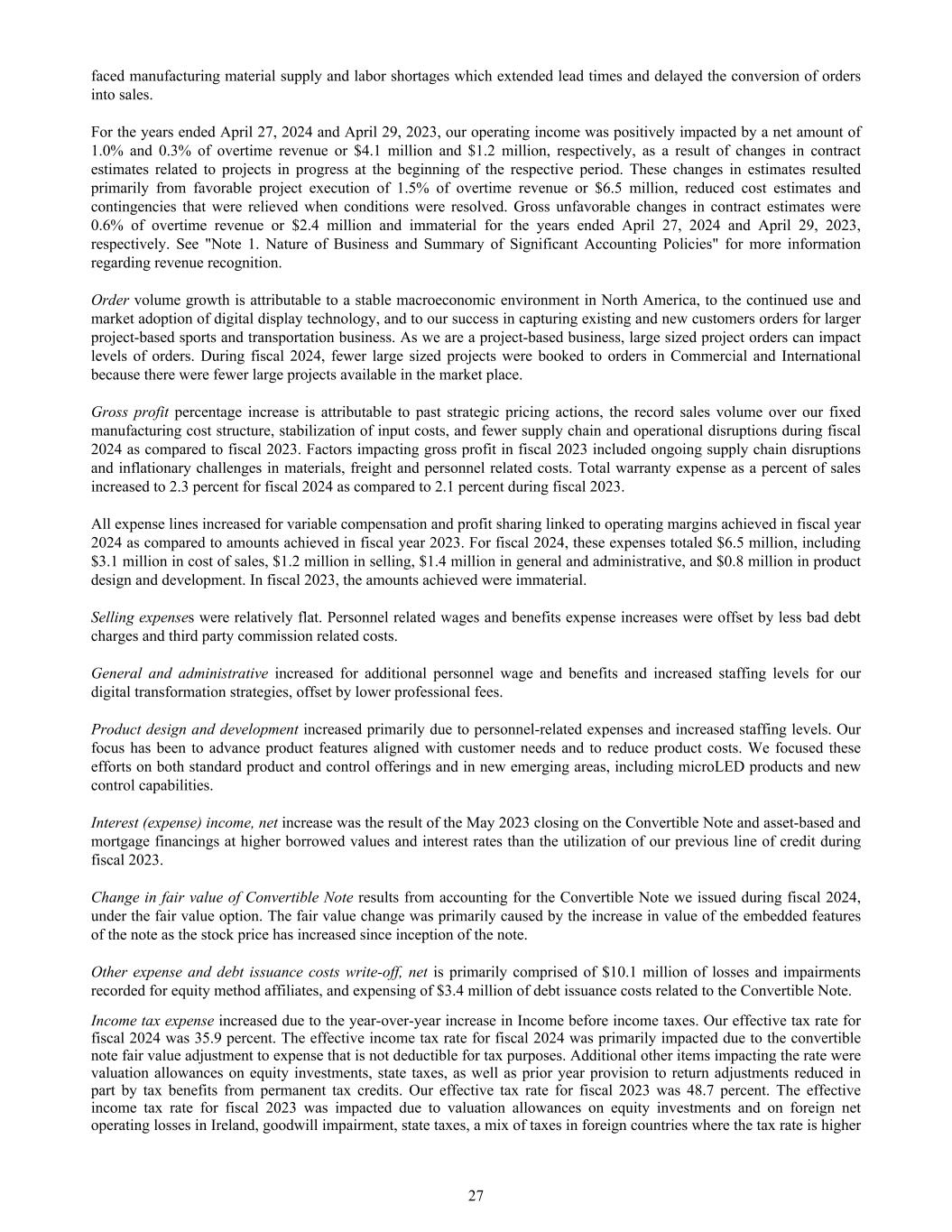
faced manufacturing material supply and labor shortages which extended lead times and delayed the conversion of orders into sales. For the years ended April 27, 2024 and April 29, 2023, our operating income was positively impacted by a net amount of 1.0% and 0.3% of overtime revenue or $4.1 million and $1.2 million, respectively, as a result of changes in contract estimates related to projects in progress at the beginning of the respective period. These changes in estimates resulted primarily from favorable project execution of 1.5% of overtime revenue or $6.5 million, reduced cost estimates and contingencies that were relieved when conditions were resolved. Gross unfavorable changes in contract estimates were 0.6% of overtime revenue or $2.4 million and immaterial for the years ended April 27, 2024 and April 29, 2023, respectively. See "Note 1. Nature of Business and Summary of Significant Accounting Policies" for more information regarding revenue recognition. Order volume growth is attributable to a stable macroeconomic environment in North America, to the continued use and market adoption of digital display technology, and to our success in capturing existing and new customers orders for larger project-based sports and transportation business. As we are a project-based business, large sized project orders can impact levels of orders. During fiscal 2024, fewer large sized projects were booked to orders in Commercial and International because there were fewer large projects available in the market place. Gross profit percentage increase is attributable to past strategic pricing actions, the record sales volume over our fixed manufacturing cost structure, stabilization of input costs, and fewer supply chain and operational disruptions during fiscal 2024 as compared to fiscal 2023. Factors impacting gross profit in fiscal 2023 included ongoing supply chain disruptions and inflationary challenges in materials, freight and personnel related costs. Total warranty expense as a percent of sales increased to 2.3 percent for fiscal 2024 as compared to 2.1 percent during fiscal 2023. All expense lines increased for variable compensation and profit sharing linked to operating margins achieved in fiscal year 2024 as compared to amounts achieved in fiscal year 2023. For fiscal 2024, these expenses totaled $6.5 million, including $3.1 million in cost of sales, $1.2 million in selling, $1.4 million in general and administrative, and $0.8 million in product design and development. In fiscal 2023, the amounts achieved were immaterial. Selling expenses were relatively flat. Personnel related wages and benefits expense increases were offset by less bad debt charges and third party commission related costs. General and administrative increased for additional personnel wage and benefits and increased staffing levels for our digital transformation strategies, offset by lower professional fees. Product design and development increased primarily due to personnel-related expenses and increased staffing levels. Our focus has been to advance product features aligned with customer needs and to reduce product costs. We focused these efforts on both standard product and control offerings and in new emerging areas, including microLED products and new control capabilities. Interest (expense) income, net increase was the result of the May 2023 closing on the Convertible Note and asset-based and mortgage financings at higher borrowed values and interest rates than the utilization of our previous line of credit during fiscal 2023. Change in fair value of Convertible Note results from accounting for the Convertible Note we issued during fiscal 2024, under the fair value option. The fair value change was primarily caused by the increase in value of the embedded features of the note as the stock price has increased since inception of the note. Other expense and debt issuance costs write-off, net is primarily comprised of $10.1 million of losses and impairments recorded for equity method affiliates, and expensing of $3.4 million of debt issuance costs related to the Convertible Note. Income tax expense increased due to the year-over-year increase in Income before income taxes. Our effective tax rate for fiscal 2024 was 35.9 percent. The effective income tax rate for fiscal 2024 was primarily impacted due to the convertible note fair value adjustment to expense that is not deductible for tax purposes. Additional other items impacting the rate were valuation allowances on equity investments, state taxes, as well as prior year provision to return adjustments reduced in part by tax benefits from permanent tax credits. Our effective tax rate for fiscal 2023 was 48.7 percent. The effective income tax rate for fiscal 2023 was impacted due to valuation allowances on equity investments and on foreign net operating losses in Ireland, goodwill impairment, state taxes, a mix of taxes in foreign countries where the tax rate is higher 27

than in the United States, as well as a prior year provision to return adjustments reduced in part by tax benefits from permanent tax credits. See "Note 12. Income Taxes" for further information. 28
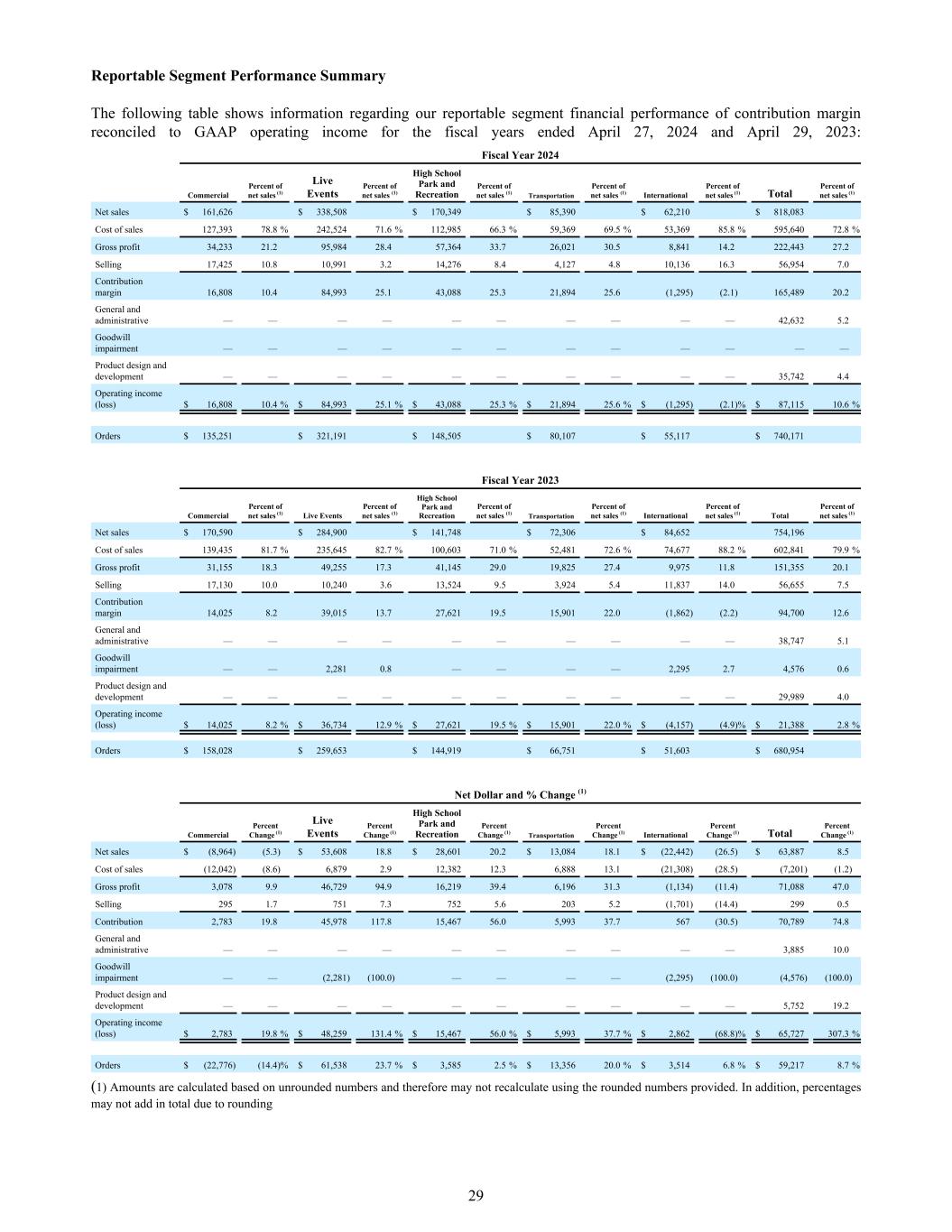
Reportable Segment Performance Summary The following table shows information regarding our reportable segment financial performance of contribution margin reconciled to GAAP operating income for the fiscal years ended April 27, 2024 and April 29, 2023: Fiscal Year 2024 Commercial Percent of net sales (1) Live Events Percent of net sales (1) High School Park and Recreation Percent of net sales (1) Transportation Percent of net sales (1) International Percent of net sales (1) Total Percent of net sales (1) Net sales $ 161,626 $ 338,508 $ 170,349 $ 85,390 $ 62,210 $ 818,083 Cost of sales 127,393 78.8 % 242,524 71.6 % 112,985 66.3 % 59,369 69.5 % 53,369 85.8 % 595,640 72.8 % Gross profit 34,233 21.2 95,984 28.4 57,364 33.7 26,021 30.5 8,841 14.2 222,443 27.2 Selling 17,425 10.8 10,991 3.2 14,276 8.4 4,127 4.8 10,136 16.3 56,954 7.0 Contribution margin 16,808 10.4 84,993 25.1 43,088 25.3 21,894 25.6 (1,295) (2.1) 165,489 20.2 General and administrative — — — — — — — — — — 42,632 5.2 Goodwill impairment — — — — — — — — — — — — Product design and development — — — — — — — — — — 35,742 4.4 Operating income (loss) $ 16,808 10.4 % $ 84,993 25.1 % $ 43,088 25.3 % $ 21,894 25.6 % $ (1,295) (2.1) % $ 87,115 10.6 % Orders $ 135,251 $ 321,191 $ 148,505 $ 80,107 $ 55,117 $ 740,171 Fiscal Year 2023 Commercial Percent of net sales (1) Live Events Percent of net sales (1) High School Park and Recreation Percent of net sales (1) Transportation Percent of net sales (1) International Percent of net sales (1) Total Percent of net sales (1) Net sales $ 170,590 $ 284,900 $ 141,748 $ 72,306 $ 84,652 754,196 Cost of sales 139,435 81.7 % 235,645 82.7 % 100,603 71.0 % 52,481 72.6 % 74,677 88.2 % 602,841 79.9 % Gross profit 31,155 18.3 49,255 17.3 41,145 29.0 19,825 27.4 9,975 11.8 151,355 20.1 Selling 17,130 10.0 10,240 3.6 13,524 9.5 3,924 5.4 11,837 14.0 56,655 7.5 Contribution margin 14,025 8.2 39,015 13.7 27,621 19.5 15,901 22.0 (1,862) (2.2) 94,700 12.6 General and administrative — — — — — — — — — — 38,747 5.1 Goodwill impairment — — 2,281 0.8 — — — — 2,295 2.7 4,576 0.6 Product design and development — — — — — — — — — — 29,989 4.0 Operating income (loss) $ 14,025 8.2 % $ 36,734 12.9 % $ 27,621 19.5 % $ 15,901 22.0 % $ (4,157) (4.9) % $ 21,388 2.8 % Orders $ 158,028 $ 259,653 $ 144,919 $ 66,751 $ 51,603 $ 680,954 Net Dollar and % Change (1) Commercial Percent Change (1) Live Events Percent Change (1) High School Park and Recreation Percent Change (1) Transportation Percent Change (1) International Percent Change (1) Total Percent Change (1) Net sales $ (8,964) (5.3) $ 53,608 18.8 $ 28,601 20.2 $ 13,084 18.1 $ (22,442) (26.5) $ 63,887 8.5 Cost of sales (12,042) (8.6) 6,879 2.9 12,382 12.3 6,888 13.1 (21,308) (28.5) (7,201) (1.2) Gross profit 3,078 9.9 46,729 94.9 16,219 39.4 6,196 31.3 (1,134) (11.4) 71,088 47.0 Selling 295 1.7 751 7.3 752 5.6 203 5.2 (1,701) (14.4) 299 0.5 Contribution 2,783 19.8 45,978 117.8 15,467 56.0 5,993 37.7 567 (30.5) 70,789 74.8 General and administrative — — — — — — — — — — 3,885 10.0 Goodwill impairment — — (2,281) (100.0) — — — — (2,295) (100.0) (4,576) (100.0) Product design and development — — — — — — — — — — 5,752 19.2 Operating income (loss) $ 2,783 19.8 % $ 48,259 131.4 % $ 15,467 56.0 % $ 5,993 37.7 % $ 2,862 (68.8) % $ 65,727 307.3 % Orders $ (22,776) (14.4) % $ 61,538 23.7 % $ 3,585 2.5 % $ 13,356 20.0 % $ 3,514 6.8 % $ 59,217 8.7 % (1) Amounts are calculated based on unrounded numbers and therefore may not recalculate using the rounded numbers provided. In addition, percentages may not add in total due to rounding 29

All segments' improved contribution margin is mostly attributable to improved gross profit as a percentage of sales. Gross profit improved due to past strategic pricing actions, stabilization of input costs, and the record sales volume over our fixed manufacturing cost structure aided by fewer supply chain and operational disruptions during fiscal 2024 as compared to fiscal 2023. Fewer supply chain and operational disruptions paired with our investments to increase capacity allowed for improved operational efficiency and fulfillment of beginning year backlog and new orders to result in increased sales. During fiscal year 2024, we returned to market expected lead times. We regularly adjust our sales and marketing activities and staffing levels to achieve current and expected future sales levels. For the years ended April 27, 2024 and April 29, 2023, our operating income was positively impacted by a net amount of 1.0% and 0.3% of overtime revenue or $4.1 million and $1.2 million, respectively, as a result of changes in contract estimates related to projects in progress at the beginning of the respective period. These changes in estimates resulted primarily from favorable project execution of 1.5% of overtime revenue or $6.5 million, reduced cost estimates and contingencies that were relieved when conditions were resolved. Gross unfavorable changes in contract estimates were 0.6% of overtime revenue or $2.4 million and immaterial for the years ended April 27, 2024 and April 29, 2023, respectively. Live Events business unit had the largest dollar impact of $4.5 million and $0.9 million gross negative impacts, there were 1.7% and 0.3% of overtime revenue sales in Live Events. The remaining business units had immaterial gross positive and gross negative changes. See "Note 1. Nature of Business and Summary of Significant Accounting Policies" for more information regarding revenue recognition. Commercial: The decrease in net sales and orders was driven by volatility in order bookings of larger sized Spectacular LED video displays projects, there were fewer projects in the market as compared to prior years, and a contraction in digital billboards deployed by our OOH customers. Gross profit as a percentage of sales improved 2.9 points for the factors noted above. Selling expenses remained relatively flat in dollars and increased as a percentage of sales because of the change in sales volume. Live Events: The increase in net sales was driven by fulfilling pent-up order backlog and returning to market acceptable lead times for new order bookings. Order bookings increased because of an active market of upgrades in sports-related facilities, primarily in colleges and universities. Gross profit as a percentage of sales improved a total of 11.1 points primarily due to the pricing strategies and volume increases attributable to the stabilization factors cited above and the net favorable estimate changes for overtime revenue recognition of 1.1 points, offset by a 1.0 points or $3.3 million warranty charge to resolve a discrete product issue. Selling expenses increased primarily for personnel related costs yet declined as a percent of sales. In fiscal 2023, we recorded a goodwill impairment of $2.3 million impacting operating income, with no such impact in fiscal 2024. High School Park and Recreation: The increase in net sales was driven by fulfilling pent-up orders in backlog and similar market demand for video related products in High Schools. Video projects are a larger dollar-sized transaction than traditional scoreboard products. Segment contribution margin profitability was primarily driven by the gross profit factors described above, offset by selling expense increases for personnel-related expenses. Transportation: The increase in net sales was driven by fulfilling orders in backlog and continued buildable order bookings, especially in large intelligent transportation system projects. Gross profit as a percentage of sales increased 3.1 points primarily for strategic pricing actions. Selling expense increases were for personnel-related expenses. Segment contribution margin improvements were primarily driven by gross profit factors described above, offset by $1.7 million warranty charges to resolve a discrete product issue. International: The decrease in net sales was driven by lower backlog and lower orders. Global geopolitical events have driven down the amount of market activity for digital display systems and large-sized projects causing the decrease in orders. Gross margin increased 2.4 points primarily due to strategic pricing actions. Even with efforts to lower selling and other operational costs, International operated at a negative $1.3 million contribution margin. In fiscal 2023, we recorded a goodwill impairment of $2.3 million impacting operating income, with no such impact in fiscal 2024. 30
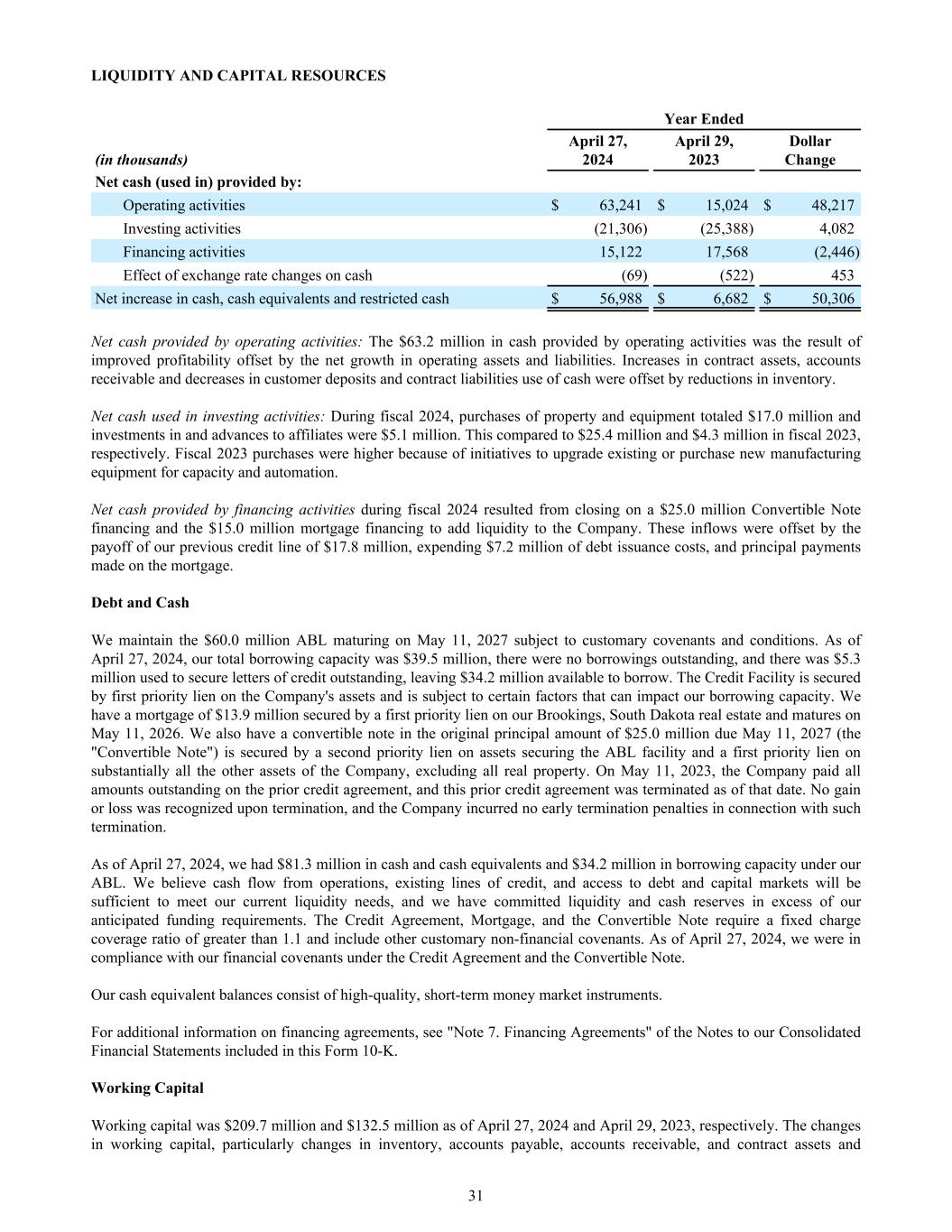
LIQUIDITY AND CAPITAL RESOURCES Year Ended (in thousands) April 27, 2024 April 29, 2023 Dollar Change Net cash (used in) provided by: Operating activities $ 63,241 $ 15,024 $ 48,217 Investing activities (21,306) (25,388) 4,082 Financing activities 15,122 17,568 (2,446) Effect of exchange rate changes on cash (69) (522) 453 Net increase in cash, cash equivalents and restricted cash $ 56,988 $ 6,682 $ 50,306 Net cash provided by operating activities: The $63.2 million in cash provided by operating activities was the result of improved profitability offset by the net growth in operating assets and liabilities. Increases in contract assets, accounts receivable and decreases in customer deposits and contract liabilities use of cash were offset by reductions in inventory. Net cash used in investing activities: During fiscal 2024, purchases of property and equipment totaled $17.0 million and investments in and advances to affiliates were $5.1 million. This compared to $25.4 million and $4.3 million in fiscal 2023, respectively. Fiscal 2023 purchases were higher because of initiatives to upgrade existing or purchase new manufacturing equipment for capacity and automation. Net cash provided by financing activities during fiscal 2024 resulted from closing on a $25.0 million Convertible Note financing and the $15.0 million mortgage financing to add liquidity to the Company. These inflows were offset by the payoff of our previous credit line of $17.8 million, expending $7.2 million of debt issuance costs, and principal payments made on the mortgage. Debt and Cash We maintain the $60.0 million ABL maturing on May 11, 2027 subject to customary covenants and conditions. As of April 27, 2024, our total borrowing capacity was $39.5 million, there were no borrowings outstanding, and there was $5.3 million used to secure letters of credit outstanding, leaving $34.2 million available to borrow. The Credit Facility is secured by first priority lien on the Company's assets and is subject to certain factors that can impact our borrowing capacity. We have a mortgage of $13.9 million secured by a first priority lien on our Brookings, South Dakota real estate and matures on May 11, 2026. We also have a convertible note in the original principal amount of $25.0 million due May 11, 2027 (the "Convertible Note") is secured by a second priority lien on assets securing the ABL facility and a first priority lien on substantially all the other assets of the Company, excluding all real property. On May 11, 2023, the Company paid all amounts outstanding on the prior credit agreement, and this prior credit agreement was terminated as of that date. No gain or loss was recognized upon termination, and the Company incurred no early termination penalties in connection with such termination. As of April 27, 2024, we had $81.3 million in cash and cash equivalents and $34.2 million in borrowing capacity under our ABL. We believe cash flow from operations, existing lines of credit, and access to debt and capital markets will be sufficient to meet our current liquidity needs, and we have committed liquidity and cash reserves in excess of our anticipated funding requirements. The Credit Agreement, Mortgage, and the Convertible Note require a fixed charge coverage ratio of greater than 1.1 and include other customary non-financial covenants. As of April 27, 2024, we were in compliance with our financial covenants under the Credit Agreement and the Convertible Note. Our cash equivalent balances consist of high-quality, short-term money market instruments. For additional information on financing agreements, see "Note 7. Financing Agreements" of the Notes to our Consolidated Financial Statements included in this Form 10-K. Working Capital Working capital was $209.7 million and $132.5 million as of April 27, 2024 and April 29, 2023, respectively. The changes in working capital, particularly changes in inventory, accounts payable, accounts receivable, and contract assets and 31
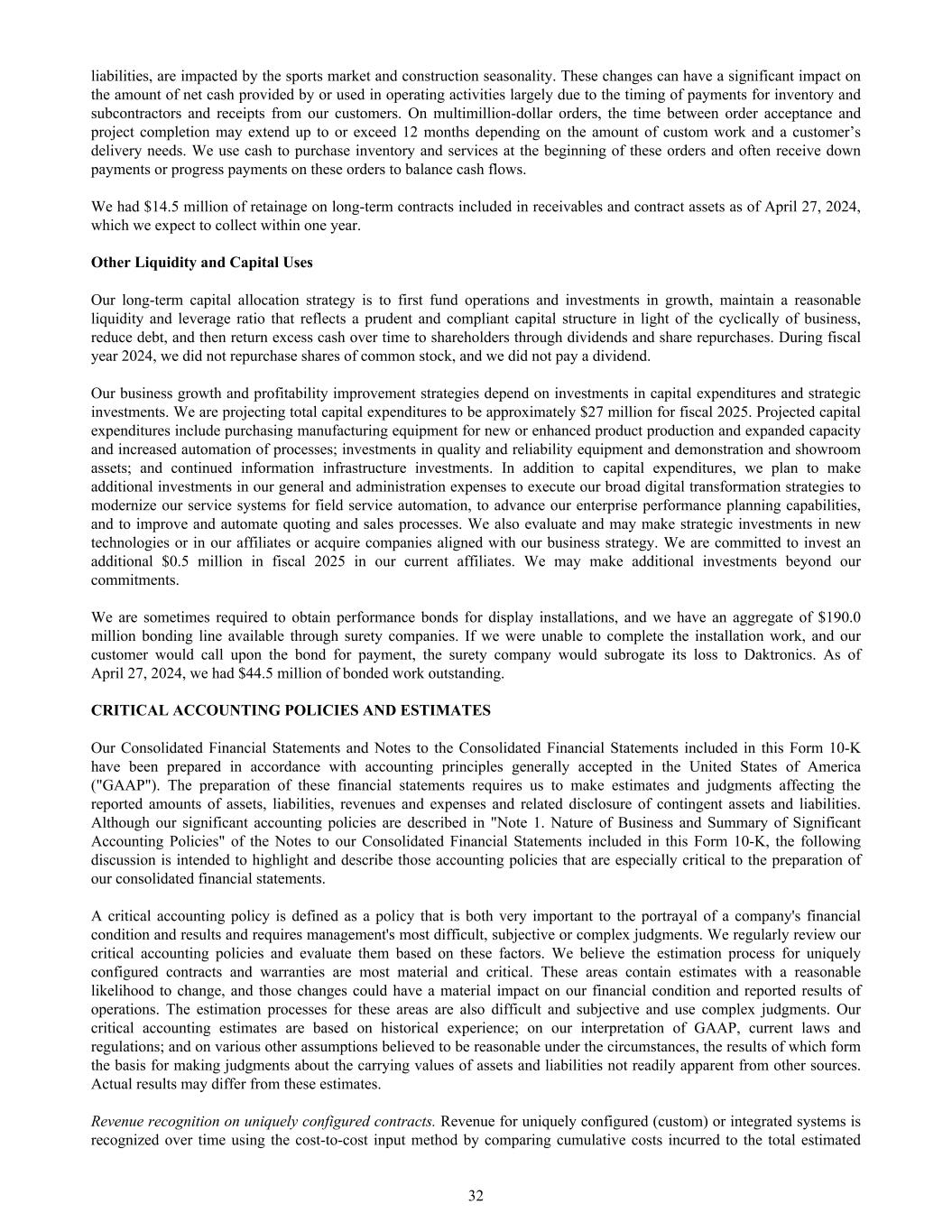
liabilities, are impacted by the sports market and construction seasonality. These changes can have a significant impact on the amount of net cash provided by or used in operating activities largely due to the timing of payments for inventory and subcontractors and receipts from our customers. On multimillion-dollar orders, the time between order acceptance and project completion may extend up to or exceed 12 months depending on the amount of custom work and a customer’s delivery needs. We use cash to purchase inventory and services at the beginning of these orders and often receive down payments or progress payments on these orders to balance cash flows. We had $14.5 million of retainage on long-term contracts included in receivables and contract assets as of April 27, 2024, which we expect to collect within one year. Other Liquidity and Capital Uses Our long-term capital allocation strategy is to first fund operations and investments in growth, maintain a reasonable liquidity and leverage ratio that reflects a prudent and compliant capital structure in light of the cyclically of business, reduce debt, and then return excess cash over time to shareholders through dividends and share repurchases. During fiscal year 2024, we did not repurchase shares of common stock, and we did not pay a dividend. Our business growth and profitability improvement strategies depend on investments in capital expenditures and strategic investments. We are projecting total capital expenditures to be approximately $27 million for fiscal 2025. Projected capital expenditures include purchasing manufacturing equipment for new or enhanced product production and expanded capacity and increased automation of processes; investments in quality and reliability equipment and demonstration and showroom assets; and continued information infrastructure investments. In addition to capital expenditures, we plan to make additional investments in our general and administration expenses to execute our broad digital transformation strategies to modernize our service systems for field service automation, to advance our enterprise performance planning capabilities, and to improve and automate quoting and sales processes. We also evaluate and may make strategic investments in new technologies or in our affiliates or acquire companies aligned with our business strategy. We are committed to invest an additional $0.5 million in fiscal 2025 in our current affiliates. We may make additional investments beyond our commitments. We are sometimes required to obtain performance bonds for display installations, and we have an aggregate of $190.0 million bonding line available through surety companies. If we were unable to complete the installation work, and our customer would call upon the bond for payment, the surety company would subrogate its loss to Daktronics. As of April 27, 2024, we had $44.5 million of bonded work outstanding. CRITICAL ACCOUNTING POLICIES AND ESTIMATES Our Consolidated Financial Statements and Notes to the Consolidated Financial Statements included in this Form 10-K have been prepared in accordance with accounting principles generally accepted in the United States of America ("GAAP"). The preparation of these financial statements requires us to make estimates and judgments affecting the reported amounts of assets, liabilities, revenues and expenses and related disclosure of contingent assets and liabilities. Although our significant accounting policies are described in "Note 1. Nature of Business and Summary of Significant Accounting Policies" of the Notes to our Consolidated Financial Statements included in this Form 10-K, the following discussion is intended to highlight and describe those accounting policies that are especially critical to the preparation of our consolidated financial statements. A critical accounting policy is defined as a policy that is both very important to the portrayal of a company's financial condition and results and requires management's most difficult, subjective or complex judgments. We regularly review our critical accounting policies and evaluate them based on these factors. We believe the estimation process for uniquely configured contracts and warranties are most material and critical. These areas contain estimates with a reasonable likelihood to change, and those changes could have a material impact on our financial condition and reported results of operations. The estimation processes for these areas are also difficult and subjective and use complex judgments. Our critical accounting estimates are based on historical experience; on our interpretation of GAAP, current laws and regulations; and on various other assumptions believed to be reasonable under the circumstances, the results of which form the basis for making judgments about the carrying values of assets and liabilities not readily apparent from other sources. Actual results may differ from these estimates. Revenue recognition on uniquely configured contracts. Revenue for uniquely configured (custom) or integrated systems is recognized over time using the cost-to-cost input method by comparing cumulative costs incurred to the total estimated 32
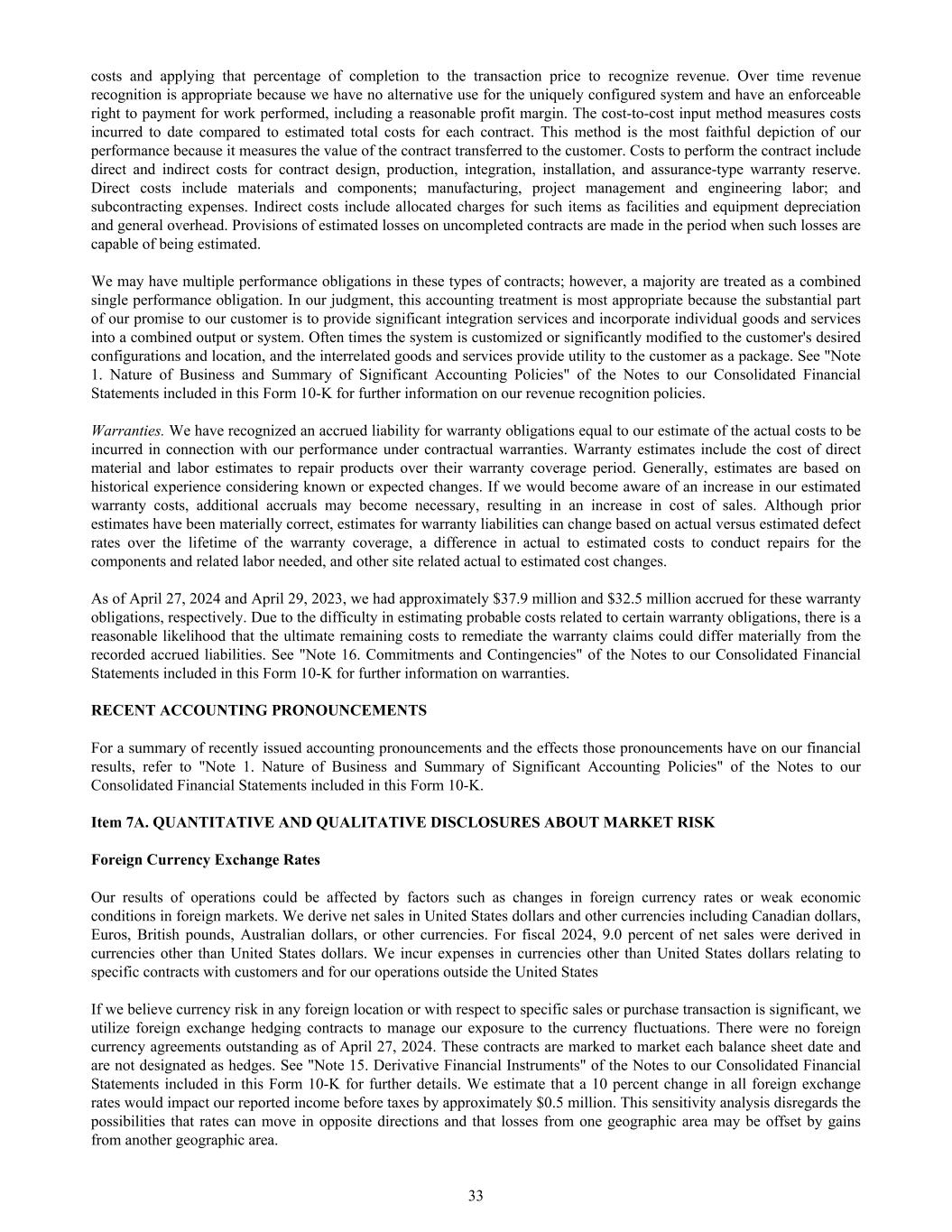
costs and applying that percentage of completion to the transaction price to recognize revenue. Over time revenue recognition is appropriate because we have no alternative use for the uniquely configured system and have an enforceable right to payment for work performed, including a reasonable profit margin. The cost-to-cost input method measures costs incurred to date compared to estimated total costs for each contract. This method is the most faithful depiction of our performance because it measures the value of the contract transferred to the customer. Costs to perform the contract include direct and indirect costs for contract design, production, integration, installation, and assurance-type warranty reserve. Direct costs include materials and components; manufacturing, project management and engineering labor; and subcontracting expenses. Indirect costs include allocated charges for such items as facilities and equipment depreciation and general overhead. Provisions of estimated losses on uncompleted contracts are made in the period when such losses are capable of being estimated. We may have multiple performance obligations in these types of contracts; however, a majority are treated as a combined single performance obligation. In our judgment, this accounting treatment is most appropriate because the substantial part of our promise to our customer is to provide significant integration services and incorporate individual goods and services into a combined output or system. Often times the system is customized or significantly modified to the customer's desired configurations and location, and the interrelated goods and services provide utility to the customer as a package. See "Note 1. Nature of Business and Summary of Significant Accounting Policies" of the Notes to our Consolidated Financial Statements included in this Form 10-K for further information on our revenue recognition policies. Warranties. We have recognized an accrued liability for warranty obligations equal to our estimate of the actual costs to be incurred in connection with our performance under contractual warranties. Warranty estimates include the cost of direct material and labor estimates to repair products over their warranty coverage period. Generally, estimates are based on historical experience considering known or expected changes. If we would become aware of an increase in our estimated warranty costs, additional accruals may become necessary, resulting in an increase in cost of sales. Although prior estimates have been materially correct, estimates for warranty liabilities can change based on actual versus estimated defect rates over the lifetime of the warranty coverage, a difference in actual to estimated costs to conduct repairs for the components and related labor needed, and other site related actual to estimated cost changes. As of April 27, 2024 and April 29, 2023, we had approximately $37.9 million and $32.5 million accrued for these warranty obligations, respectively. Due to the difficulty in estimating probable costs related to certain warranty obligations, there is a reasonable likelihood that the ultimate remaining costs to remediate the warranty claims could differ materially from the recorded accrued liabilities. See "Note 16. Commitments and Contingencies" of the Notes to our Consolidated Financial Statements included in this Form 10-K for further information on warranties. RECENT ACCOUNTING PRONOUNCEMENTS For a summary of recently issued accounting pronouncements and the effects those pronouncements have on our financial results, refer to "Note 1. Nature of Business and Summary of Significant Accounting Policies" of the Notes to our Consolidated Financial Statements included in this Form 10-K. Item 7A. QUANTITATIVE AND QUALITATIVE DISCLOSURES ABOUT MARKET RISK Foreign Currency Exchange Rates Our results of operations could be affected by factors such as changes in foreign currency rates or weak economic conditions in foreign markets. We derive net sales in United States dollars and other currencies including Canadian dollars, Euros, British pounds, Australian dollars, or other currencies. For fiscal 2024, 9.0 percent of net sales were derived in currencies other than United States dollars. We incur expenses in currencies other than United States dollars relating to specific contracts with customers and for our operations outside the United States If we believe currency risk in any foreign location or with respect to specific sales or purchase transaction is significant, we utilize foreign exchange hedging contracts to manage our exposure to the currency fluctuations. There were no foreign currency agreements outstanding as of April 27, 2024. These contracts are marked to market each balance sheet date and are not designated as hedges. See "Note 15. Derivative Financial Instruments" of the Notes to our Consolidated Financial Statements included in this Form 10-K for further details. We estimate that a 10 percent change in all foreign exchange rates would impact our reported income before taxes by approximately $0.5 million. This sensitivity analysis disregards the possibilities that rates can move in opposite directions and that losses from one geographic area may be offset by gains from another geographic area. 33

Over the long term, net sales to international markets are expected to increase as a percentage of total net sales and, consequently, a greater portion of our business could be denominated in foreign currencies. As a result, operating results may become more subject to fluctuations based upon changes in the exchange rates of certain currencies in relation to the United States dollar. To the extent we engage in international sales denominated in United States dollars, an increase in the value of the United States dollar relative to foreign currencies could make our products less competitive in international markets. This effect is also impacted by sources of raw materials from international sources and costs of our sales, service, and manufacturing locations outside the United States We will continue to monitor and minimize our exposure to currency fluctuations and, when appropriate, use financial hedging techniques to minimize the effect of these fluctuations. However, exchange rate fluctuations as well as differing economic conditions, changes in political climates, and other rules and regulations could adversely affect our ability to effectively hedge exchange rate fluctuations in the future. We have foreign currency cash accounts to operate our global business. These accounts are impacted by changes in foreign currency rates. Of our $81.3 million in cash balances as of April 27, 2024, $67.8 million were denominated in United States dollars, of which $0.3 million were held by our foreign subsidiaries. As of April 27, 2024, we had an additional $13.5 million in cash balances denominated in foreign currencies, of which $8.0 million was maintained in accounts of our foreign subsidiaries. Interest Rate Risks Our exposure to market risks relate primarily to changes in interest rates on our financing agreements, cash, and marketable securities. We do not expect our income or cash flows to be significantly impacted by interest rates. Commodity Risk We are dependent on basic raw materials, sub-assemblies, components, and other supplies used in our production operations. Our financial results have been and could continue to be affected by changes in the availability, prices, and global tariff regulation of these materials. Some of these materials are sourced from one or a limited number of suppliers in countries around the world. Some of these materials are also key source materials for our competitors and for other technology companies. Some of these materials are sourced outside of the countries in which we manufacture our products and are subject to transportation delays. Any of these factors may cause a sudden increase in costs and/or limited or unavailable supplies. As a result, we may not be able to acquire key production materials on a timely basis, which could adversely impact our ability to produce products and satisfy incoming sales orders on a timely basis. Our sourcing and material groups work to implement strategies to monitor and mitigate these risks. Periodically, we enter into pricing agreements or purchasing contracts under which we agree to purchase a minimum amount of product in exchange for guaranteed price terms over the length of the contract, which generally does not exceed one year. 34

Item 8. FINANCIAL STATEMENTS AND SUPPLEMENTARY DATA REPORT OF INDEPENDENT REGISTERED PUBLIC ACCOUNTING FIRM To the shareholders and the Board of Directors of Daktronics, Inc. Opinion on the Financial Statements We have audited the accompanying consolidated balance sheets of Daktronics, Inc. and subsidiaries (the "Company") as of April 27, 2024 and April 29, 2023, the related consolidated statements of operations, comprehensive income (loss), shareholders' equity, and cash flows, for each of the three years in the period ended April 27, 2024, and the related notes (collectively referred to as the "financial statements"). In our opinion, the financial statements present fairly, in all material respects, the financial position of the Company as of April 27, 2024 and April 29, 2023, and the results of its operations and its cash flows for each of the three years in the period ended April 27, 2024, in conformity with accounting principles generally accepted in the United States of America. We have also audited, in accordance with the standards of the Public Company Accounting Oversight Board (United States) (PCAOB), the Company's internal control over financial reporting as of April 27, 2024, based on criteria established in Internal Control — Integrated Framework (2013) issued by the Committee of Sponsoring Organizations of the Treadway Commission and our report dated June 26, 2024, expressed an unqualified opinion on the Company's internal control over financial reporting. Basis for Opinion These financial statements are the responsibility of the Company’s management. Our responsibility is to express an opinion on the Company’s financial statements based on our audits. We are a public accounting firm registered with the PCAOB and are required to be independent with respect to the Company in accordance with the U.S. federal securities laws and the applicable rules and regulations of the Securities and Exchange Commission and the PCAOB. We conducted our audits in accordance with the standards of the PCAOB. Those standards require that we plan and perform the audit to obtain reasonable assurance about whether the financial statements are free of material misstatement, whether due to error or fraud. Our audits included performing procedures to assess the risks of material misstatement of the financial statements, whether due to error or fraud, and performing procedures that respond to those risks. Such procedures included examining, on a test basis, evidence regarding the amounts and disclosures in the financial statements. Our audits also included evaluating the accounting principles used and significant estimates made by management, as well as evaluating the overall presentation of the financial statements. We believe that our audits provide a reasonable basis for our opinion. Critical Audit Matter The critical audit matter communicated below is a matter arising from the current-period audit of the financial statements that was communicated or required to be communicated to the audit committee and that (1) relates to accounts or disclosures that are material to the financial statements and (2) involved our especially challenging, subjective, or complex judgments. The communication of critical audit matters does not alter in any way our opinion on the financial statements, taken as a whole, and we are not, by communicating the critical audit matter below, providing a separate opinion on the critical audit matter or on the accounts or disclosures to which it relates. Revenue Recognition – Uniquely Configured Contracts — Refer to Notes 1 and 2 to the financial statements Critical Audit Matter Description The Company recognizes revenue as its contractual performance obligations are satisfied, which may be at a point in time or over time. Certain of the Company’s contracts are for the delivery, installation, and integration of uniquely configured audio-visual communication systems. Revenue for these uniquely configured systems is recognized over time using the cost-to-cost input method. This input method requires management to make estimates of the costs that will ultimately be incurred at the completion of each contract. Revenue is recognized based on the transaction price and the percentage of cost incurred as of the balance sheet date in relation to the total estimated inputs at completion. 35

We identified revenue associated with uniquely configured contracts as a critical audit matter because of the significant judgments necessary for management to estimate total costs to be incurred to recognize revenue under these contracts. Changes in estimated costs could have a significant impact on the timing and amount of revenue recognized. This required an increased level of auditor judgment due to the complexity of uniquely configured contracts and extent of effort when performing audit procedures to audit management’s estimate of total costs and evaluating the reasonableness of the underlying estimates. How the Critical Audit Matter Was Addressed in the Audit Our audit procedures related to estimates of total cost used to recognize revenue for uniquely configured contracts included the following, among others: • We tested the design and operating effectiveness of controls over uniquely configured contracts, including management’s controls over the estimates of total costs. • We selected a sample of uniquely configured contracts and performed the following: • Compared costs incurred to date to the costs management estimated to be incurred to date. • Evaluated management’s ability to achieve the estimates of total cost by performing corroborating inquiries with the Company’s project managers and engineers, and compared the estimates to management’s work plans, engineering specifications, and supplier contracts. • Confirmed contractual terms with third parties. • Tested the mathematical accuracy of management’s estimate of total costs. • We evaluated management’s ability to accurately estimate total costs by comparing actual costs to management’s historical estimates for uniquely configured contracts that have been fulfilled. /s/ Deloitte & Touche LLP Minneapolis, Minnesota June 26, 2024 We have served as the Company's auditor since 2017. 36
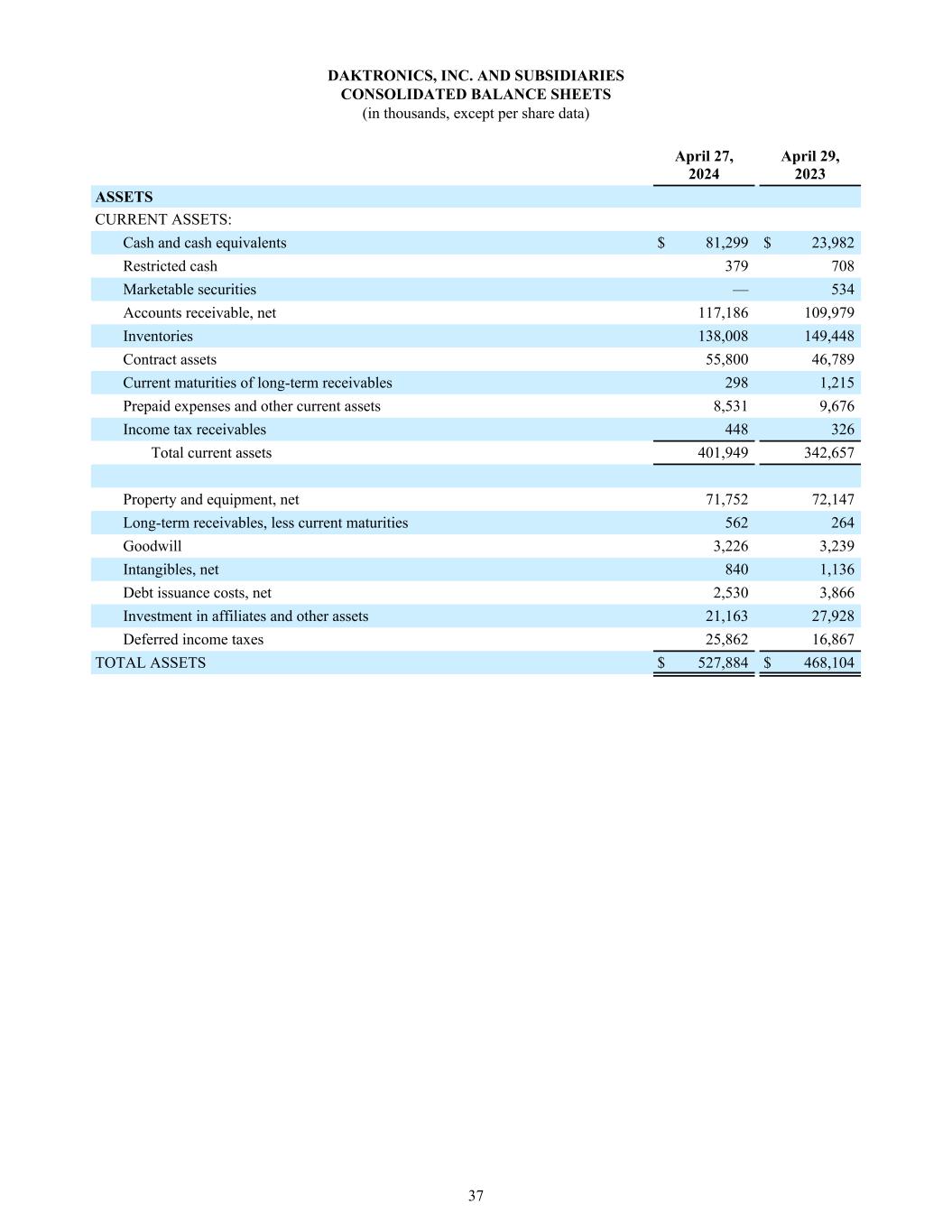
DAKTRONICS, INC. AND SUBSIDIARIES CONSOLIDATED BALANCE SHEETS (in thousands, except per share data) April 27, 2024 April 29, 2023 ASSETS CURRENT ASSETS: Cash and cash equivalents $ 81,299 $ 23,982 Restricted cash 379 708 Marketable securities — 534 Accounts receivable, net 117,186 109,979 Inventories 138,008 149,448 Contract assets 55,800 46,789 Current maturities of long-term receivables 298 1,215 Prepaid expenses and other current assets 8,531 9,676 Income tax receivables 448 326 Total current assets 401,949 342,657 Property and equipment, net 71,752 72,147 Long-term receivables, less current maturities 562 264 Goodwill 3,226 3,239 Intangibles, net 840 1,136 Debt issuance costs, net 2,530 3,866 Investment in affiliates and other assets 21,163 27,928 Deferred income taxes 25,862 16,867 TOTAL ASSETS $ 527,884 $ 468,104 37

DAKTRONICS, INC. AND SUBSIDIARIES CONSOLIDATED BALANCE SHEETS (continued) (in thousands, except per share data) April 27, 2024 April 29, 2023 LIABILITIES AND SHAREHOLDERS' EQUITY CURRENT LIABILITIES: Current portion of long-term debt $ 1,500 $ — Accounts payable 60,757 67,522 Contract liabilities 65,524 91,549 Accrued expenses 43,028 36,005 Warranty obligations 16,540 12,228 Income taxes payable 4,947 2,859 Total current liabilities 192,296 210,163 Long-term warranty obligations 21,388 20,313 Long-term contract liabilities 16,342 13,096 Other long-term obligations 5,759 5,709 Long-term debt, net 53,164 17,750 Deferred income taxes 143 195 Total long-term liabilities 96,796 57,063 SHAREHOLDERS' EQUITY: Preferred Shares, no par value, authorized 50 shares; no shares issued and outstanding — — Common stock, no par value, authorized 115,000 shares; 48,121 and 47,396 shares issued as of April 27, 2024 and April 29, 2023, respectively 65,525 63,023 Additional paid-in capital 52,046 50,259 Retained earnings 138,031 103,410 Treasury stock, at cost, 1,907 shares as of April 27, 2024 and April 29, 2023, respectively (10,285) (10,285) Accumulated other comprehensive loss (6,525) (5,529) TOTAL SHAREHOLDERS' EQUITY 238,792 200,878 TOTAL LIABILITIES AND SHAREHOLDERS' EQUITY $ 527,884 $ 468,104 See notes to consolidated financial statements. 38

DAKTRONICS, INC. AND SUBSIDIARIES CONSOLIDATED STATEMENTS OF OPERATIONS (in thousands, except per share data) Year Ended April 27, 2024 April 29, 2023 April 30, 2022 Net sales $ 818,083 $ 754,196 $ 610,970 Cost of sales 595,640 602,841 494,273 Gross profit 222,443 151,355 116,697 Operating expenses: Selling 56,954 56,655 51,075 General and administrative 42,632 38,747 32,563 Product design and development 35,742 29,989 29,013 Goodwill impairment — 4,576 — 135,328 129,967 112,651 Operating income 87,115 21,388 4,046 Nonoperating (expense) income: Interest (expense) income, net (3,418) (920) 171 Change in fair value of convertible note (16,550) — — Other expense and debt issuance costs write-off, net (13,096) (7,211) (3,109) Income before income taxes 54,051 13,257 1,108 Income tax expense 19,430 6,455 516 Net income $ 34,621 $ 6,802 $ 592 Weighted average shares outstanding: Basic 45,901 45,404 45,188 Diluted 46,543 45,521 45,326 Earnings per share: Basic $ 0.75 $ 0.15 $ 0.01 Diluted $ 0.74 $ 0.15 $ 0.01 See notes to consolidated financial statements. 39

DAKTRONICS, INC. AND SUBSIDIARIES CONSOLIDATED STATEMENTS OF COMPREHENSIVE INCOME (LOSS) (in thousands) Year Ended April 27, 2024 April 29, 2023 April 30, 2022 Net income $ 34,621 $ 6,802 $ 592 Other comprehensive income (loss): Cumulative translation adjustments (1,020) (616) (2,556) Unrealized gain (loss) on available-for-sale securities, net of tax 24 12 (34) Total other comprehensive (loss), net of tax (996) (604) (2,590) Comprehensive income (loss) $ 33,625 $ 6,198 $ (1,998) See notes to consolidated financial statements. 40

DAKTRONICS, INC. AND SUBSIDIARIES CONSOLIDATED STATEMENTS OF SHAREHOLDERS’ EQUITY (in thousands) Common Stock Additional Paid-In Capital Retained Earnings Treasury Stock Accumulated Other Comprehensive Loss TotalNumber Amount Number Amount Balance as of May 1, 2021: 46,264 $ 60,575 $ 46,595 $ 96,016 (1,297) $ (7,297) $ (2,335) $ 193,554 Net income — — — 592 — — — 592 Cumulative translation adjustments — — — — — — (2,556) (2,556) Unrealized (loss) on available-for- sale securities, net of tax — — — — — — (34) (34) Share-based compensation — — 1,973 — — — — 1,973 Exercise of stock options 2 8 — — — — — 8 Shares withheld for taxes on Restricted Stock Unit issuances (33) — (200) — — — — (200) Common stock issued upon vesting of Restricted Stock Units 190 — — — — — — — Employee savings plan activity 310 1,211 — — — — — 1,211 Treasury stock reissued — — 4 — 31 196 — 200 Treasury stock purchase — — — — (641) (3,184) — (3,184) Balance as of April 30, 2022: 46,733 61,794 48,372 96,608 (1,907) (10,285) (4,925) 191,564 Net income — — — 6,802 — — — 6,802 Cumulative translation adjustments — — — — — — (616) (616) Unrealized gain on available-for- sale securities, net of tax — — — — — — 12 12 Share-based compensation — — 2,027 — — — — 2,027 Exercise of stock options 5 21 — — — — — 21 Shares withheld for taxes on Restricted Stock Unit issuances (33) — (140) — — — — (140) Common stock issued upon vesting of Restricted Stock Units 267 — — — — — — — Employee savings plan activity 424 1,208 — — — — — 1,208 Balance as of April 29, 2023: 47,396 63,023 50,259 103,410 (1,907) (10,285) (5,529) 200,878 Net income — — — 34,621 — — — 34,621 Cumulative translation adjustments — — — — — — (1,020) (1,020) Unrealized gain on available-for- sale securities, net of tax — — — — — — 24 24 Share-based compensation — — 2,090 — — — — 2,090 Exercise of stock options 219 1,302 — — — — — 1,302 Shares withheld for taxes on Restricted Stock Unit issuances (37) — (303) — — — — (303) Common stock issued upon vesting of Restricted Stock Units 188 — — — — — — — Employee savings plan activity 355 1,200 — — — — — 1,200 Balance as of April 27, 2024: 48,121 $ 65,525 $ 52,046 $ 138,031 (1,907) $ (10,285) $ (6,525) $ 238,792 See notes to consolidated financial statements. 41

DAKTRONICS, INC. AND SUBSIDIARIES CONSOLIDATED STATEMENTS OF CASH FLOWS (in thousands) Year Ended April 27, 2024 April 29, 2023 April 30, 2022 CASH FLOWS FROM OPERATING ACTIVITIES: Net income $ 34,621 $ 6,802 $ 592 Adjustments to reconcile net income to net cash provided by (used in) operating activities: Depreciation and amortization 19,291 16,993 15,394 Loss (gain) on sale of property, equipment and other assets 44 (691) (743) Share-based compensation 2,090 2,027 1,973 Equity in loss of affiliates 3,764 3,332 2,970 Provision (recovery) for doubtful accounts, net 373 1,009 (286) Deferred income taxes, net (9,069) (3,633) (1,555) Non-cash impairment charges 6,359 9,049 — Change in fair value of convertible note 16,550 — — Debt issuance costs write-off 3,353 — — Change in operating assets and liabilities (14,135) (19,864) (45,380) Net cash provided by (used in) operating activities 63,241 15,024 (27,035) CASH FLOWS FROM INVESTING ACTIVITIES: Purchases of property and equipment (16,980) (25,385) (20,376) Proceeds from sales of property, equipment and other assets 174 822 885 Purchases of marketable securities — — (4,045) Proceeds from sales or maturities of marketable securities 550 3,490 — Purchases of equity and loans to equity investees (5,050) (4,315) (7,848) Net cash used in investing activities (21,306) (25,388) (31,384) CASH FLOWS FROM FINANCING ACTIVITIES: Borrowings on notes payable 41,172 378,694 46,801 Payments on notes payable (19,434) (360,944) (46,801) Debt issuance costs (7,205) (991) — Borrowings on long-term obligations — 1,233 — Principal payments on long-term obligations (410) (305) (200) Payments for common shares repurchased — — (3,184) Proceeds from exercise of stock options 1,302 21 8 Tax payments related to RSU issuances (303) (140) (200) Net cash provided by (used in) financing activities 15,122 17,568 (3,576) EFFECT OF EXCHANGE RATE CHANGES ON CASH (69) (522) (399) NET INCREASE (DECREASE) IN CASH, CASH EQUIVALENTS AND RESTRICTED CASH 56,988 6,682 (62,394) CASH, CASH EQUIVALENTS AND RESTRICTED CASH: Beginning of period 24,690 18,008 80,402 End of period $ 81,678 $ 24,690 $ 18,008 See notes to consolidated financial statements. 42

NOTES TO THE CONSOLIDATED FINANCIAL STATEMENTS (in thousands, except per share data) Note 1. Nature of Business and Summary of Significant Accounting Policies Nature of business: Daktronics, Inc. and its subsidiaries are engaged principally in the design, market, and manufacture of a wide range of integrated electronic display systems and related products which are sold in a variety of markets throughout the world and the rendering of related maintenance and professional services. Our products are designed primarily to inform and entertain people through the communication of content. Fiscal year: We operate on a 52- or 53-week fiscal year, with our fiscal year ending on the Saturday closest to April 30 of each year. When April 30 falls on a Wednesday, the fiscal year ends on the preceding Saturday. Within each fiscal year, each quarter is comprised of a 13-week periods following the beginning of each fiscal year. In each 53-week year, an additional week is added to the first quarter, and each of the last three quarters is comprised of a 13-week period. The fiscal years ended April 27, 2024, April 29, 2023 and April 30, 2022 contained operating results for 52 weeks. Principles of consolidation: The consolidated financial statements include Daktronics, Inc. and its subsidiaries. All intercompany accounts and transactions are eliminated in consolidation. We have a variable interest in a business where we have elected to follow the proportionate consolidation method because certain criteria were met under Accounting Standards Codification ("ASC") 810, Consolidations. We have arrangements we concluded were a variable interest entity and accounted for them under the proportionate consolidation method. These arrangements had an aggregate amount of contract assets, contract liabilities and gross profit of $1,955, $38 and $2,761, respectively, as of and for the year ended April 27, 2024. As of April 29, 2023, the aggregate amount of contract assets and gross profit was $5,223 and $2,748, respectively. Investments in affiliates: We consolidate entities in which we have a controlling financial interest by first considering if an entity meets the definition of a variable interest entity ("VIE") for which we are deemed to be the primary beneficiary, or if we have the power to control an entity through a majority of voting interest or through other arrangements. Variable Interest Entities: A VIE is an entity (i) that lacks sufficient equity to finance its activities without additional subordinated financial support from other parties; (ii) whose equity holders lack the characteristics of a controlling financial interest; and/or (iii) that is established with non-substantive voting rights. A VIE is consolidated by its primary beneficiary, which is defined as the party who has a controlling financial interest in the VIE through (a) the power to direct the activities of the VIE that most significantly affect the VIE’s economic performance, and (b) the obligation to absorb losses or the right to receive benefits of the VIE that could be significant to the VIE. This assessment may involve subjectivity in the determination of which activities most significantly affect the VIE’s performance and making estimates about the current and future fair value of the assets held by the VIE and the financial performance of the VIE. In assessing the Company's interests in a VIE, we also consider interests held by its related parties, including de facto agents. Additionally, we assess whether it is a member of a related party group that collectively meets the power and benefits criteria and, if so, whether we are most closely associated with the VIE. In performing the related party analysis, we consider both qualitative and quantitative factors including, but not limited to: the characteristics and size of its investment relative to the related party; our and the related party's ability to control or significantly influence key decisions of the VIE, including consideration of involvement by de facto agents; the obligation or likelihood for us or the related party to fund operating losses of the VIE; and the similarity and significance of the VIE’s business activities to those of us and the related party. The determination of whether an entity is a VIE and whether we are the primary beneficiary may involve significant judgment and depends upon facts and circumstances specific to an entity at the time of the assessment. Upon occurrence of certain events such as changes to the entity's legal formation or equity at risk, we reassess whether changes in facts and circumstances cause a change in the status of an entity as a VIE or voting interest entity, and/or a change in our consolidation assessment. Changes in consolidation status are applied prospectively. An entity may be consolidated as a result of this reassessment, in which case the assets, liabilities and noncontrolling interest in the entity are recorded at fair value upon initial consolidation. Any existing equity interest held by us in the entity prior to us obtaining control will be remeasured at fair value, which may result in a gain or loss recognized upon initial consolidation. However, if the consolidation represents an asset acquisition of a voting interest entity, our existing interest in the acquired assets, if any, is not remeasured to fair value but continues to be carried at historical cost. We may also deconsolidate a subsidiary as a result of this reassessment, which may result in a gain or loss recognized upon deconsolidation depending on the carrying values of the deconsolidated assets and liabilities compared to the fair value of any interests retained. 43
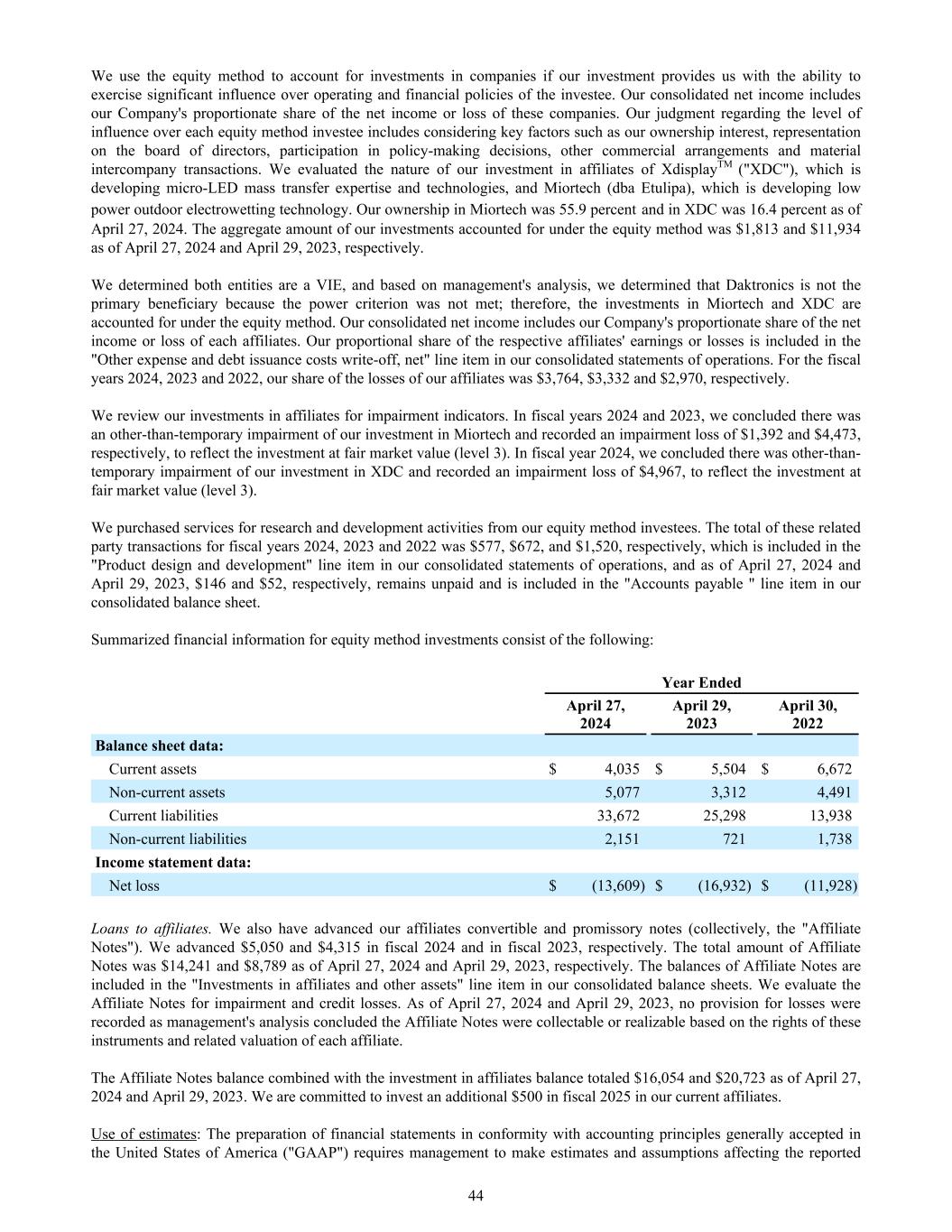
We use the equity method to account for investments in companies if our investment provides us with the ability to exercise significant influence over operating and financial policies of the investee. Our consolidated net income includes our Company's proportionate share of the net income or loss of these companies. Our judgment regarding the level of influence over each equity method investee includes considering key factors such as our ownership interest, representation on the board of directors, participation in policy-making decisions, other commercial arrangements and material intercompany transactions. We evaluated the nature of our investment in affiliates of XdisplayTM ("XDC"), which is developing micro-LED mass transfer expertise and technologies, and Miortech (dba Etulipa), which is developing low power outdoor electrowetting technology. Our ownership in Miortech was 55.9 percent and in XDC was 16.4 percent as of April 27, 2024. The aggregate amount of our investments accounted for under the equity method was $1,813 and $11,934 as of April 27, 2024 and April 29, 2023, respectively. We determined both entities are a VIE, and based on management's analysis, we determined that Daktronics is not the primary beneficiary because the power criterion was not met; therefore, the investments in Miortech and XDC are accounted for under the equity method. Our consolidated net income includes our Company's proportionate share of the net income or loss of each affiliates. Our proportional share of the respective affiliates' earnings or losses is included in the "Other expense and debt issuance costs write-off, net" line item in our consolidated statements of operations. For the fiscal years 2024, 2023 and 2022, our share of the losses of our affiliates was $3,764, $3,332 and $2,970, respectively. We review our investments in affiliates for impairment indicators. In fiscal years 2024 and 2023, we concluded there was an other-than-temporary impairment of our investment in Miortech and recorded an impairment loss of $1,392 and $4,473, respectively, to reflect the investment at fair market value (level 3). In fiscal year 2024, we concluded there was other-than- temporary impairment of our investment in XDC and recorded an impairment loss of $4,967, to reflect the investment at fair market value (level 3). We purchased services for research and development activities from our equity method investees. The total of these related party transactions for fiscal years 2024, 2023 and 2022 was $577, $672, and $1,520, respectively, which is included in the "Product design and development" line item in our consolidated statements of operations, and as of April 27, 2024 and April 29, 2023, $146 and $52, respectively, remains unpaid and is included in the "Accounts payable " line item in our consolidated balance sheet. Summarized financial information for equity method investments consist of the following: Year Ended April 27, 2024 April 29, 2023 April 30, 2022 Balance sheet data: Current assets $ 4,035 $ 5,504 $ 6,672 Non-current assets 5,077 3,312 4,491 Current liabilities 33,672 25,298 13,938 Non-current liabilities 2,151 721 1,738 Income statement data: Net loss $ (13,609) $ (16,932) $ (11,928) Loans to affiliates. We also have advanced our affiliates convertible and promissory notes (collectively, the "Affiliate Notes"). We advanced $5,050 and $4,315 in fiscal 2024 and in fiscal 2023, respectively. The total amount of Affiliate Notes was $14,241 and $8,789 as of April 27, 2024 and April 29, 2023, respectively. The balances of Affiliate Notes are included in the "Investments in affiliates and other assets" line item in our consolidated balance sheets. We evaluate the Affiliate Notes for impairment and credit losses. As of April 27, 2024 and April 29, 2023, no provision for losses were recorded as management's analysis concluded the Affiliate Notes were collectable or realizable based on the rights of these instruments and related valuation of each affiliate. The Affiliate Notes balance combined with the investment in affiliates balance totaled $16,054 and $20,723 as of April 27, 2024 and April 29, 2023. We are committed to invest an additional $500 in fiscal 2025 in our current affiliates. Use of estimates: The preparation of financial statements in conformity with accounting principles generally accepted in the United States of America ("GAAP") requires management to make estimates and assumptions affecting the reported 44
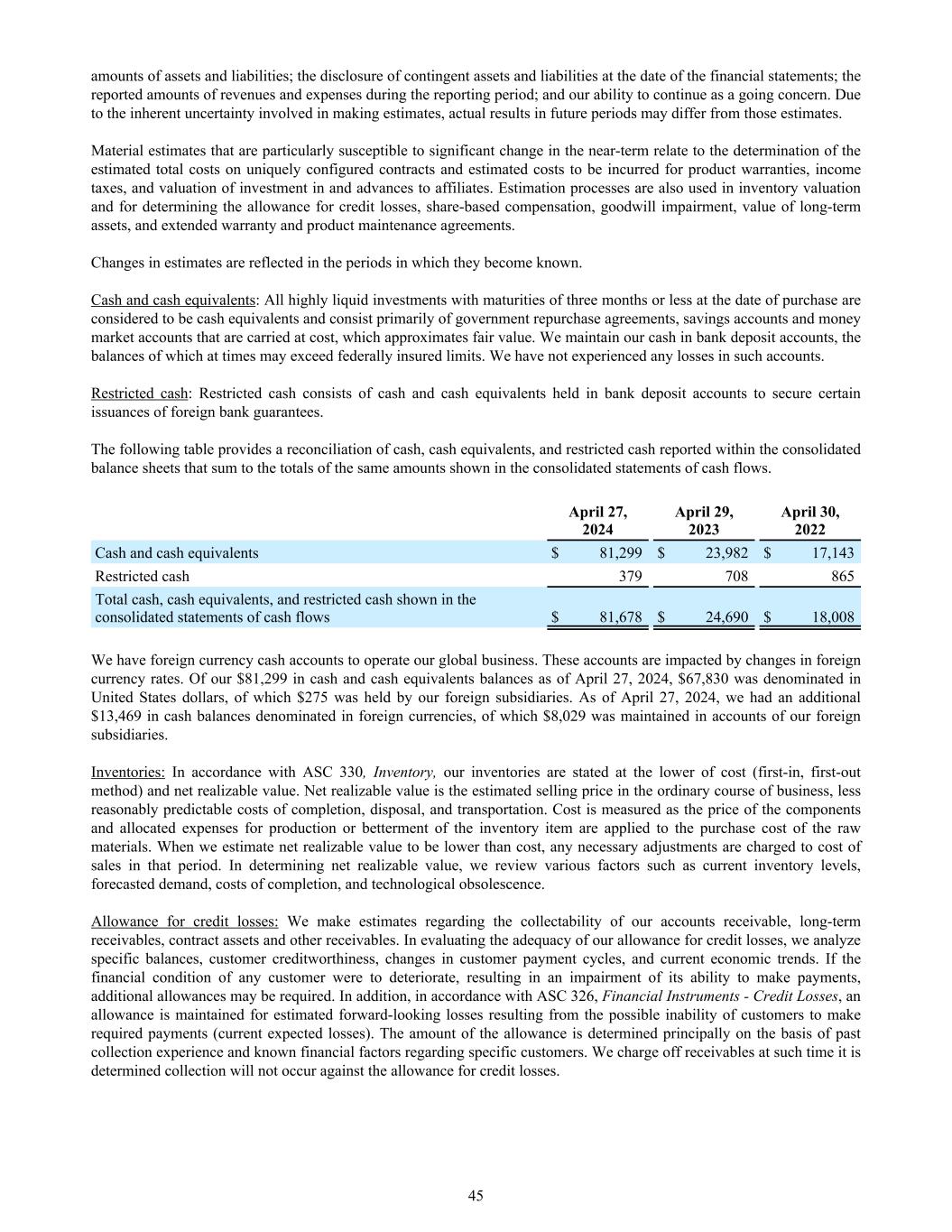
amounts of assets and liabilities; the disclosure of contingent assets and liabilities at the date of the financial statements; the reported amounts of revenues and expenses during the reporting period; and our ability to continue as a going concern. Due to the inherent uncertainty involved in making estimates, actual results in future periods may differ from those estimates. Material estimates that are particularly susceptible to significant change in the near-term relate to the determination of the estimated total costs on uniquely configured contracts and estimated costs to be incurred for product warranties, income taxes, and valuation of investment in and advances to affiliates. Estimation processes are also used in inventory valuation and for determining the allowance for credit losses, share-based compensation, goodwill impairment, value of long-term assets, and extended warranty and product maintenance agreements. Changes in estimates are reflected in the periods in which they become known. Cash and cash equivalents: All highly liquid investments with maturities of three months or less at the date of purchase are considered to be cash equivalents and consist primarily of government repurchase agreements, savings accounts and money market accounts that are carried at cost, which approximates fair value. We maintain our cash in bank deposit accounts, the balances of which at times may exceed federally insured limits. We have not experienced any losses in such accounts. Restricted cash: Restricted cash consists of cash and cash equivalents held in bank deposit accounts to secure certain issuances of foreign bank guarantees. The following table provides a reconciliation of cash, cash equivalents, and restricted cash reported within the consolidated balance sheets that sum to the totals of the same amounts shown in the consolidated statements of cash flows. April 27, 2024 April 29, 2023 April 30, 2022 Cash and cash equivalents $ 81,299 $ 23,982 $ 17,143 Restricted cash 379 708 865 Total cash, cash equivalents, and restricted cash shown in the consolidated statements of cash flows $ 81,678 $ 24,690 $ 18,008 We have foreign currency cash accounts to operate our global business. These accounts are impacted by changes in foreign currency rates. Of our $81,299 in cash and cash equivalents balances as of April 27, 2024, $67,830 was denominated in United States dollars, of which $275 was held by our foreign subsidiaries. As of April 27, 2024, we had an additional $13,469 in cash balances denominated in foreign currencies, of which $8,029 was maintained in accounts of our foreign subsidiaries. Inventories: In accordance with ASC 330, Inventory, our inventories are stated at the lower of cost (first-in, first-out method) and net realizable value. Net realizable value is the estimated selling price in the ordinary course of business, less reasonably predictable costs of completion, disposal, and transportation. Cost is measured as the price of the components and allocated expenses for production or betterment of the inventory item are applied to the purchase cost of the raw materials. When we estimate net realizable value to be lower than cost, any necessary adjustments are charged to cost of sales in that period. In determining net realizable value, we review various factors such as current inventory levels, forecasted demand, costs of completion, and technological obsolescence. Allowance for credit losses: We make estimates regarding the collectability of our accounts receivable, long-term receivables, contract assets and other receivables. In evaluating the adequacy of our allowance for credit losses, we analyze specific balances, customer creditworthiness, changes in customer payment cycles, and current economic trends. If the financial condition of any customer were to deteriorate, resulting in an impairment of its ability to make payments, additional allowances may be required. In addition, in accordance with ASC 326, Financial Instruments - Credit Losses, an allowance is maintained for estimated forward-looking losses resulting from the possible inability of customers to make required payments (current expected losses). The amount of the allowance is determined principally on the basis of past collection experience and known financial factors regarding specific customers. We charge off receivables at such time it is determined collection will not occur against the allowance for credit losses. 45
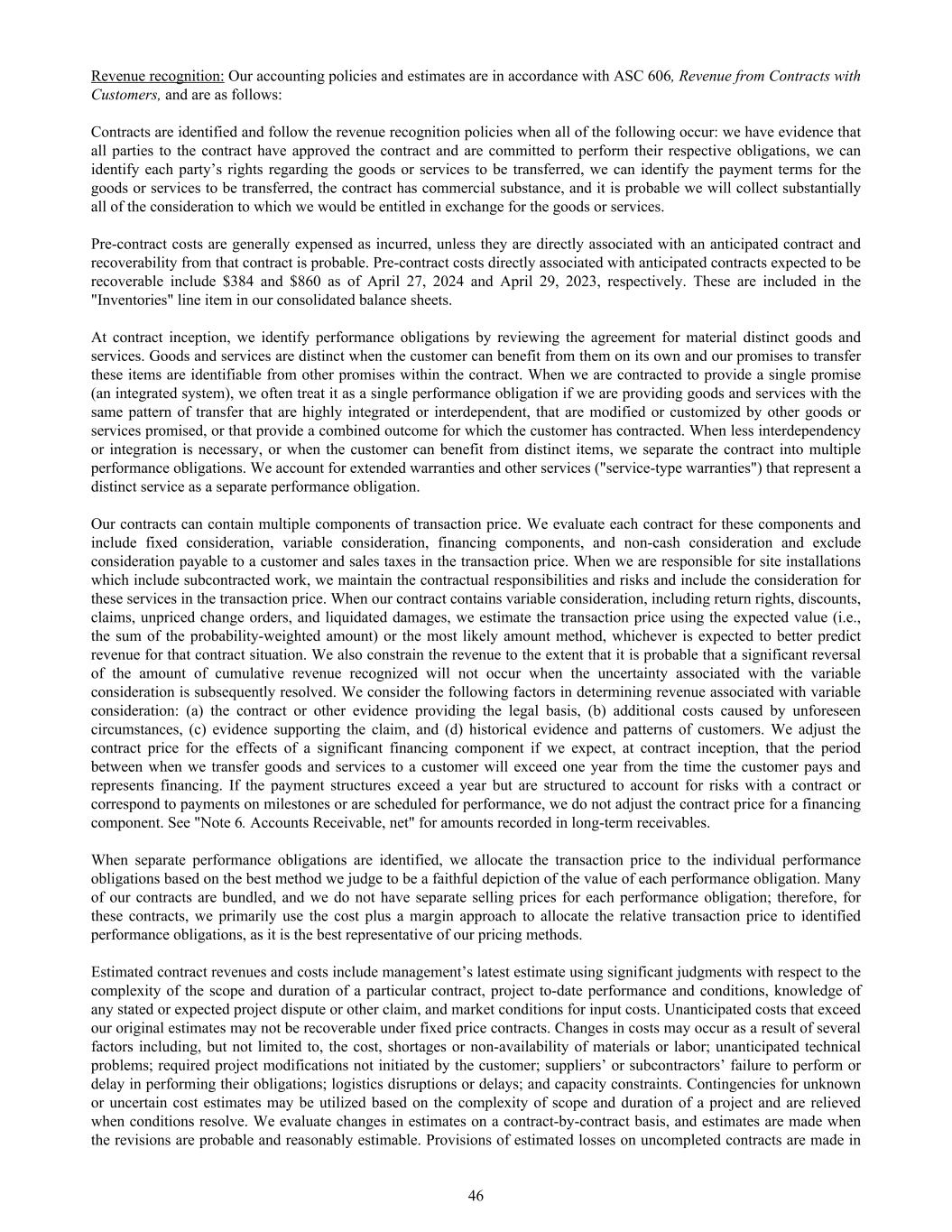
Revenue recognition: Our accounting policies and estimates are in accordance with ASC 606, Revenue from Contracts with Customers, and are as follows: Contracts are identified and follow the revenue recognition policies when all of the following occur: we have evidence that all parties to the contract have approved the contract and are committed to perform their respective obligations, we can identify each party’s rights regarding the goods or services to be transferred, we can identify the payment terms for the goods or services to be transferred, the contract has commercial substance, and it is probable we will collect substantially all of the consideration to which we would be entitled in exchange for the goods or services. Pre-contract costs are generally expensed as incurred, unless they are directly associated with an anticipated contract and recoverability from that contract is probable. Pre-contract costs directly associated with anticipated contracts expected to be recoverable include $384 and $860 as of April 27, 2024 and April 29, 2023, respectively. These are included in the "Inventories" line item in our consolidated balance sheets. At contract inception, we identify performance obligations by reviewing the agreement for material distinct goods and services. Goods and services are distinct when the customer can benefit from them on its own and our promises to transfer these items are identifiable from other promises within the contract. When we are contracted to provide a single promise (an integrated system), we often treat it as a single performance obligation if we are providing goods and services with the same pattern of transfer that are highly integrated or interdependent, that are modified or customized by other goods or services promised, or that provide a combined outcome for which the customer has contracted. When less interdependency or integration is necessary, or when the customer can benefit from distinct items, we separate the contract into multiple performance obligations. We account for extended warranties and other services ("service-type warranties") that represent a distinct service as a separate performance obligation. Our contracts can contain multiple components of transaction price. We evaluate each contract for these components and include fixed consideration, variable consideration, financing components, and non-cash consideration and exclude consideration payable to a customer and sales taxes in the transaction price. When we are responsible for site installations which include subcontracted work, we maintain the contractual responsibilities and risks and include the consideration for these services in the transaction price. When our contract contains variable consideration, including return rights, discounts, claims, unpriced change orders, and liquidated damages, we estimate the transaction price using the expected value (i.e., the sum of the probability-weighted amount) or the most likely amount method, whichever is expected to better predict revenue for that contract situation. We also constrain the revenue to the extent that it is probable that a significant reversal of the amount of cumulative revenue recognized will not occur when the uncertainty associated with the variable consideration is subsequently resolved. We consider the following factors in determining revenue associated with variable consideration: (a) the contract or other evidence providing the legal basis, (b) additional costs caused by unforeseen circumstances, (c) evidence supporting the claim, and (d) historical evidence and patterns of customers. We adjust the contract price for the effects of a significant financing component if we expect, at contract inception, that the period between when we transfer goods and services to a customer will exceed one year from the time the customer pays and represents financing. If the payment structures exceed a year but are structured to account for risks with a contract or correspond to payments on milestones or are scheduled for performance, we do not adjust the contract price for a financing component. See "Note 6. Accounts Receivable, net" for amounts recorded in long-term receivables. When separate performance obligations are identified, we allocate the transaction price to the individual performance obligations based on the best method we judge to be a faithful depiction of the value of each performance obligation. Many of our contracts are bundled, and we do not have separate selling prices for each performance obligation; therefore, for these contracts, we primarily use the cost plus a margin approach to allocate the relative transaction price to identified performance obligations, as it is the best representative of our pricing methods. Estimated contract revenues and costs include management’s latest estimate using significant judgments with respect to the complexity of the scope and duration of a particular contract, project to-date performance and conditions, knowledge of any stated or expected project dispute or other claim, and market conditions for input costs. Unanticipated costs that exceed our original estimates may not be recoverable under fixed price contracts. Changes in costs may occur as a result of several factors including, but not limited to, the cost, shortages or non-availability of materials or labor; unanticipated technical problems; required project modifications not initiated by the customer; suppliers’ or subcontractors’ failure to perform or delay in performing their obligations; logistics disruptions or delays; and capacity constraints. Contingencies for unknown or uncertain cost estimates may be utilized based on the complexity of scope and duration of a project and are relieved when conditions resolve. We evaluate changes in estimates on a contract-by-contract basis, and estimates are made when the revisions are probable and reasonably estimable. Provisions of estimated losses on uncompleted contracts are made in 46

the period when such losses are capable of being estimated. The cumulative catch-up method is used to account for revisions in estimates. Revenue is recognized when we satisfy a performance obligation. We receive payments from customers based on a billing schedule as established in our contracts. Billing schedules include down payments and progress billings over time; set milestone payments that are specific to the project are scheduled for performance-based payments or are set time-based payment(s). Variability in contract assets and contract liabilities relates to the timing of billings and revenue recognition, which can vary significantly depending on contractual payment terms, build and installation schedules, and the related timing differences in transfer of control. Balances are also impacted by the seasonality in our business. Significant judgments and estimates are used in applying our revenue policies. In order to assure appropriate and consistent revenue recognition, we regularly evaluate available project related information and update estimates accordingly. We maintain internal policies and procedures to provide guidance for those involved in recording revenue. We monitor for changes in our business sales practices and customer interactions to capture the appropriate types of performance obligations and adjust for any change in control terms and conditions. Our material performance obligation types include: Unique configuration contracts: audio-visual communication systems uniquely configured (custom) or integrated for a customer's particular location and system configuration may include all or a combination of the following: engineering services, project management services, video display(s), control solution(s), installation and integration services, scoring and messaging equipment, training, other on-site services, spare parts, software licenses, and assurance-type warranties. We may have multiple performance obligations in these types of contracts; however, a majority are treated as a combined single performance obligation. In our judgment, this accounting treatment is most appropriate because the substantial part of our promise to customers is to provide significant integration services and incorporate individual goods and services into a combined output or system. Often times, the system is customized or significantly modified to the customer's desired configurations and location, and the interrelated goods and services provide utility to the customer as a package. Revenue for uniquely configured (custom) or integrated systems is recognized over time using the cost-to-cost input method by comparing cumulative costs incurred to the total estimated costs and applying that percentage of completion to the transaction price to recognize revenue. Over time revenue recognition is appropriate because we have no alternative use for the uniquely configured system and have an enforceable right to payment for work performed, including a reasonable profit margin. The cost-to-cost input method measures costs incurred to date compared to estimated total costs for each contract. This method is the most faithful depiction of our performance because it measures the value of the contract transferred to the customer. Costs to perform the contract include direct and indirect costs for contract design, production, integration, installation, and assurance-type warranty reserve. Direct costs include materials and components; manufacturing, project management and engineering labor; and subcontracting expenses. Indirect costs include allocated charges for such items as facilities and equipment depreciation and general overhead. Provisions of estimated losses on uncompleted contracts are made in the period when such losses are capable of being estimated. Contract modifications to existing contracts with customers are evaluated in accordance with the five-step revenue model. We treat contract modifications as a separate contract and new performance obligations when the additional goods or services are distinct and do not add to the unique configuration or are outside the integrated system and when the consideration reflects standalone selling prices. If the additional goods or services offered under the modification enhance the uniquely configured or integrated systems, revenue is allocated to the existing contracts' performance obligation. Modifications may cause changes in the timing of revenue recognition depending on the allocation to various performance obligations. The time between contract order and project completion is typically less than 12 months but may extend longer depending on the amount of custom work and customers’ delivery needs. Limited configuration (standard systems) and after-sale parts contracts: Limited configuration (standard systems) or after-sale parts contracts with limited or no configuration or limited integration are recognized as distinct individual performance obligations when material. When not distinct, we combine into one performance 47
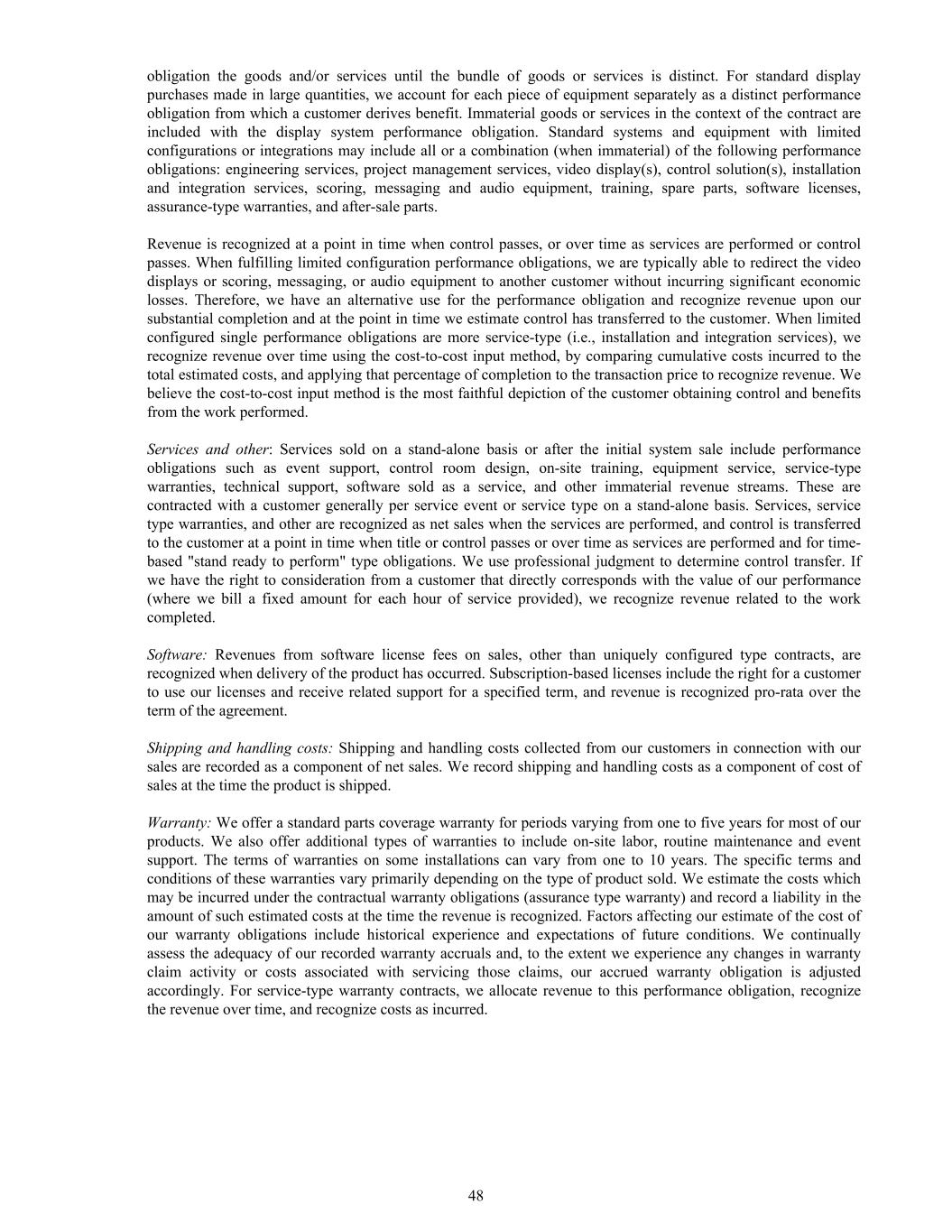
obligation the goods and/or services until the bundle of goods or services is distinct. For standard display purchases made in large quantities, we account for each piece of equipment separately as a distinct performance obligation from which a customer derives benefit. Immaterial goods or services in the context of the contract are included with the display system performance obligation. Standard systems and equipment with limited configurations or integrations may include all or a combination (when immaterial) of the following performance obligations: engineering services, project management services, video display(s), control solution(s), installation and integration services, scoring, messaging and audio equipment, training, spare parts, software licenses, assurance-type warranties, and after-sale parts. Revenue is recognized at a point in time when control passes, or over time as services are performed or control passes. When fulfilling limited configuration performance obligations, we are typically able to redirect the video displays or scoring, messaging, or audio equipment to another customer without incurring significant economic losses. Therefore, we have an alternative use for the performance obligation and recognize revenue upon our substantial completion and at the point in time we estimate control has transferred to the customer. When limited configured single performance obligations are more service-type (i.e., installation and integration services), we recognize revenue over time using the cost-to-cost input method, by comparing cumulative costs incurred to the total estimated costs, and applying that percentage of completion to the transaction price to recognize revenue. We believe the cost-to-cost input method is the most faithful depiction of the customer obtaining control and benefits from the work performed. Services and other: Services sold on a stand-alone basis or after the initial system sale include performance obligations such as event support, control room design, on-site training, equipment service, service-type warranties, technical support, software sold as a service, and other immaterial revenue streams. These are contracted with a customer generally per service event or service type on a stand-alone basis. Services, service type warranties, and other are recognized as net sales when the services are performed, and control is transferred to the customer at a point in time when title or control passes or over time as services are performed and for time- based "stand ready to perform" type obligations. We use professional judgment to determine control transfer. If we have the right to consideration from a customer that directly corresponds with the value of our performance (where we bill a fixed amount for each hour of service provided), we recognize revenue related to the work completed. Software: Revenues from software license fees on sales, other than uniquely configured type contracts, are recognized when delivery of the product has occurred. Subscription-based licenses include the right for a customer to use our licenses and receive related support for a specified term, and revenue is recognized pro-rata over the term of the agreement. Shipping and handling costs: Shipping and handling costs collected from our customers in connection with our sales are recorded as a component of net sales. We record shipping and handling costs as a component of cost of sales at the time the product is shipped. Warranty: We offer a standard parts coverage warranty for periods varying from one to five years for most of our products. We also offer additional types of warranties to include on-site labor, routine maintenance and event support. The terms of warranties on some installations can vary from one to 10 years. The specific terms and conditions of these warranties vary primarily depending on the type of product sold. We estimate the costs which may be incurred under the contractual warranty obligations (assurance type warranty) and record a liability in the amount of such estimated costs at the time the revenue is recognized. Factors affecting our estimate of the cost of our warranty obligations include historical experience and expectations of future conditions. We continually assess the adequacy of our recorded warranty accruals and, to the extent we experience any changes in warranty claim activity or costs associated with servicing those claims, our accrued warranty obligation is adjusted accordingly. For service-type warranty contracts, we allocate revenue to this performance obligation, recognize the revenue over time, and recognize costs as incurred. 48

Property and equipment: In accordance with ASC 360, Property, Plant, and Equipment, property and equipment are stated at cost and depreciated principally on the straight-line method over the following estimated useful lives: Years Buildings and improvements 5 - 40 Machinery and equipment 5 - 7 Office furniture and equipment 3 - 5 Computer software and hardware 3 - 5 Equipment held for rental 2 - 7 Demonstration equipment 3 - 5 Transportation equipment 5 - 7 Leasehold improvements are depreciated over the lesser of the useful life of the asset or the term of the lease. Impairment of Long-Lived Assets: In accordance with ASC 360, Property, Plant, and Equipment, we assess long-lived tangible assets and definite-lived intangible assets for impairment whenever events or changes in circumstances indicate the carrying value may not be recoverable. When evaluating long-lived assets for potential impairment, we first compare the carrying value of the asset to the asset's estimated future cash flows (undiscounted and without interest charges). If the estimated future cash flows are less than the carrying value of the asset, we calculate an impairment loss. The impairment loss calculation compares the carrying value of the asset to the asset's estimated fair value. We recognize an impairment loss if the amount of the asset's carrying value exceeds the asset's estimated fair value. If we recognize an impairment loss, the adjusted carrying amount of the asset becomes its new cost basis. For a depreciable long-lived asset, the new cost basis will be depreciated (amortized) over the remaining useful life of that asset. Our impairment loss calculations contain uncertainties because they require management to make assumptions and to apply judgment to estimate future cash flows and asset fair values, including forecasting useful lives of the assets and selecting the discount rate that reflects the risk inherent in future cash flows. Goodwill and Other Intangible Assets: We account for goodwill and other intangible assets with indefinite lives in accordance with ASC 350, Intangibles - Goodwill and Other. Under these provisions, goodwill is not amortized but is tested for impairment on at least an annual basis. Impairment testing is required more often than annually if an event or circumstance indicates an impairment or a decline in value may have occurred. A qualitative assessment may be used to first determine whether it is "more likely than not" that the fair value of a reporting unit is less its carrying value. Based on this assessment, if it is determined that is more likely than not that impairment has occurred, a quantitative analysis will be performed. The quantitative assessment uses an income approach to estimate the fair value of each reporting unit. The income approach is based on the projected cash flows, which are discounted to their present value using discount rates which consider the timing and risk of the forecasted cash flows. Fair value is estimated using internally developed forecasts and assumptions and takes into account management plans, business trends, and market and economic conditions. If the quantitative assessment of goodwill impairment fails, an impairment loss equal to the amount that a reporting unit's carrying value exceeds its fair value will be recognized. Foreign currency translation: We follow the provisions of ASC 830, Foreign Currency Matters. Our foreign subsidiaries use the local currency of their respective countries as their functional currency. The assets and liabilities of foreign operations are translated at the exchange rates in effect at the balance sheet date. The operating results of foreign operations are translated at weighted average exchange rates. The related translation gains or losses are reported as a separate component of shareholders’ equity in accumulated other comprehensive loss. Income taxes: We account for income taxes in accordance with ASC 740, Income Taxes. We record a tax provision for anticipated tax consequences of the reported results of operations. Deferred tax assets and liabilities are measured using currently enacted tax rates and statutory tax rates applicable to the years in which we expect these temporary differences will affect taxable income. These assets and liabilities are analyzed regularly, and we assess the likelihood that deferred tax assets will be recoverable from future taxable income. When necessary, a valuation allowance is established if it is more 49
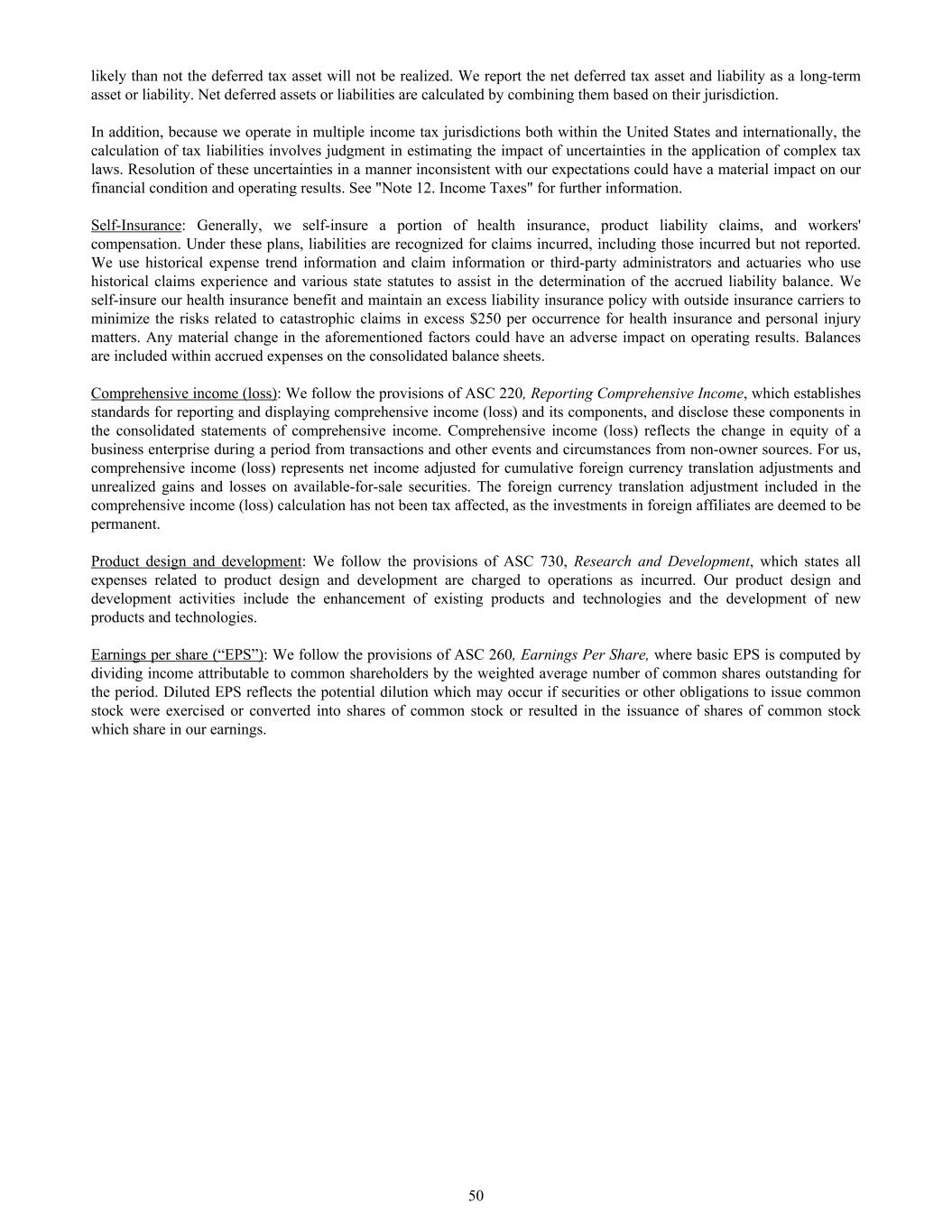
likely than not the deferred tax asset will not be realized. We report the net deferred tax asset and liability as a long-term asset or liability. Net deferred assets or liabilities are calculated by combining them based on their jurisdiction. In addition, because we operate in multiple income tax jurisdictions both within the United States and internationally, the calculation of tax liabilities involves judgment in estimating the impact of uncertainties in the application of complex tax laws. Resolution of these uncertainties in a manner inconsistent with our expectations could have a material impact on our financial condition and operating results. See "Note 12. Income Taxes" for further information. Self-Insurance: Generally, we self-insure a portion of health insurance, product liability claims, and workers' compensation. Under these plans, liabilities are recognized for claims incurred, including those incurred but not reported. We use historical expense trend information and claim information or third-party administrators and actuaries who use historical claims experience and various state statutes to assist in the determination of the accrued liability balance. We self-insure our health insurance benefit and maintain an excess liability insurance policy with outside insurance carriers to minimize the risks related to catastrophic claims in excess $250 per occurrence for health insurance and personal injury matters. Any material change in the aforementioned factors could have an adverse impact on operating results. Balances are included within accrued expenses on the consolidated balance sheets. Comprehensive income (loss): We follow the provisions of ASC 220, Reporting Comprehensive Income, which establishes standards for reporting and displaying comprehensive income (loss) and its components, and disclose these components in the consolidated statements of comprehensive income. Comprehensive income (loss) reflects the change in equity of a business enterprise during a period from transactions and other events and circumstances from non-owner sources. For us, comprehensive income (loss) represents net income adjusted for cumulative foreign currency translation adjustments and unrealized gains and losses on available-for-sale securities. The foreign currency translation adjustment included in the comprehensive income (loss) calculation has not been tax affected, as the investments in foreign affiliates are deemed to be permanent. Product design and development: We follow the provisions of ASC 730, Research and Development, which states all expenses related to product design and development are charged to operations as incurred. Our product design and development activities include the enhancement of existing products and technologies and the development of new products and technologies. Earnings per share (“EPS”): We follow the provisions of ASC 260, Earnings Per Share, where basic EPS is computed by dividing income attributable to common shareholders by the weighted average number of common shares outstanding for the period. Diluted EPS reflects the potential dilution which may occur if securities or other obligations to issue common stock were exercised or converted into shares of common stock or resulted in the issuance of shares of common stock which share in our earnings. 50
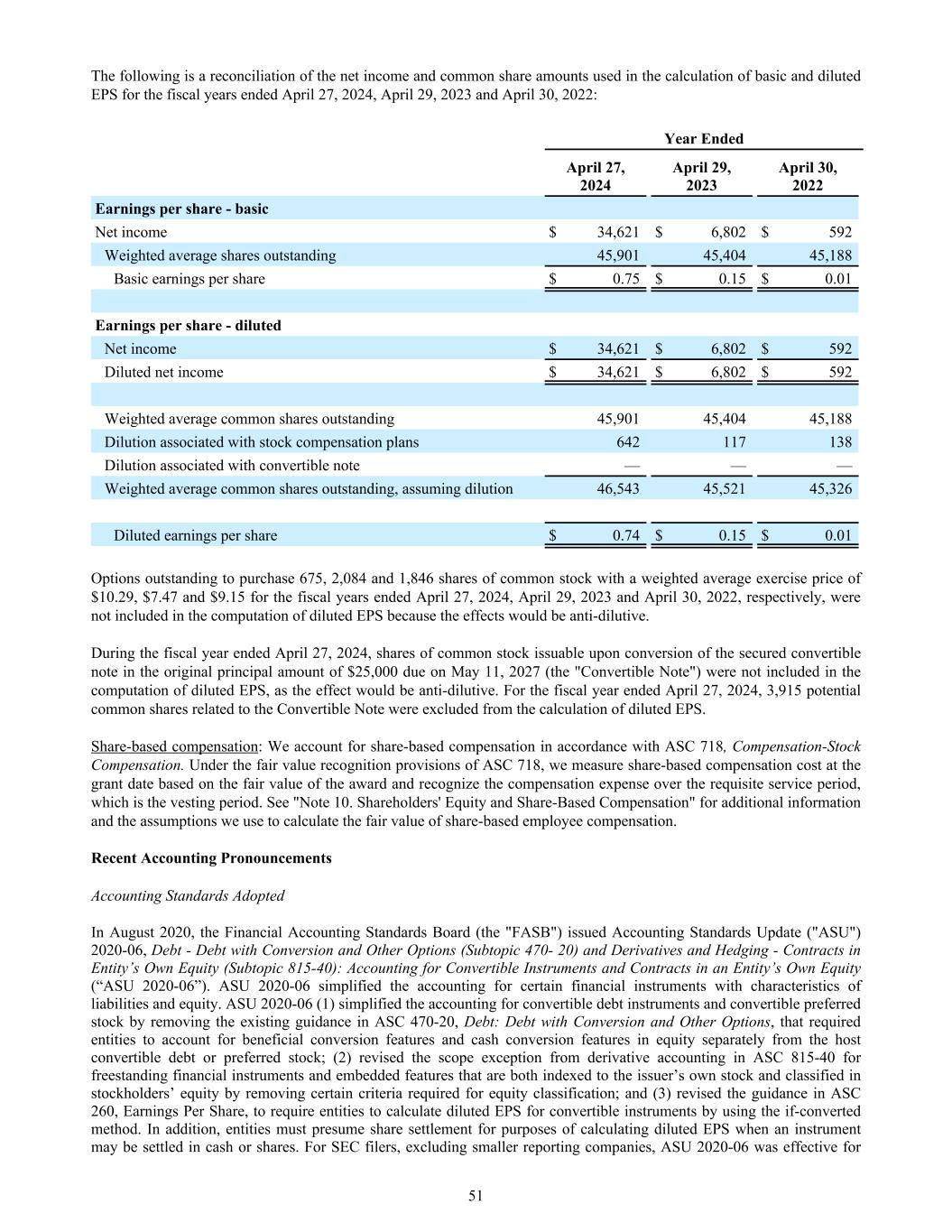
The following is a reconciliation of the net income and common share amounts used in the calculation of basic and diluted EPS for the fiscal years ended April 27, 2024, April 29, 2023 and April 30, 2022: Year Ended April 27, 2024 April 29, 2023 April 30, 2022 Earnings per share - basic Net income $ 34,621 $ 6,802 $ 592 Weighted average shares outstanding 45,901 45,404 45,188 Basic earnings per share $ 0.75 $ 0.15 $ 0.01 Earnings per share - diluted Net income $ 34,621 $ 6,802 $ 592 Diluted net income $ 34,621 $ 6,802 $ 592 Weighted average common shares outstanding 45,901 45,404 45,188 Dilution associated with stock compensation plans 642 117 138 Dilution associated with convertible note — — — Weighted average common shares outstanding, assuming dilution 46,543 45,521 45,326 Diluted earnings per share $ 0.74 $ 0.15 $ 0.01 Options outstanding to purchase 675, 2,084 and 1,846 shares of common stock with a weighted average exercise price of $10.29, $7.47 and $9.15 for the fiscal years ended April 27, 2024, April 29, 2023 and April 30, 2022, respectively, were not included in the computation of diluted EPS because the effects would be anti-dilutive. During the fiscal year ended April 27, 2024, shares of common stock issuable upon conversion of the secured convertible note in the original principal amount of $25,000 due on May 11, 2027 (the "Convertible Note") were not included in the computation of diluted EPS, as the effect would be anti-dilutive. For the fiscal year ended April 27, 2024, 3,915 potential common shares related to the Convertible Note were excluded from the calculation of diluted EPS. Share-based compensation: We account for share-based compensation in accordance with ASC 718, Compensation-Stock Compensation. Under the fair value recognition provisions of ASC 718, we measure share-based compensation cost at the grant date based on the fair value of the award and recognize the compensation expense over the requisite service period, which is the vesting period. See "Note 10. Shareholders' Equity and Share-Based Compensation" for additional information and the assumptions we use to calculate the fair value of share-based employee compensation. Recent Accounting Pronouncements Accounting Standards Adopted In August 2020, the Financial Accounting Standards Board (the "FASB") issued Accounting Standards Update ("ASU") 2020-06, Debt - Debt with Conversion and Other Options (Subtopic 470- 20) and Derivatives and Hedging - Contracts in Entity’s Own Equity (Subtopic 815-40): Accounting for Convertible Instruments and Contracts in an Entity’s Own Equity (“ASU 2020-06”). ASU 2020-06 simplified the accounting for certain financial instruments with characteristics of liabilities and equity. ASU 2020-06 (1) simplified the accounting for convertible debt instruments and convertible preferred stock by removing the existing guidance in ASC 470-20, Debt: Debt with Conversion and Other Options, that required entities to account for beneficial conversion features and cash conversion features in equity separately from the host convertible debt or preferred stock; (2) revised the scope exception from derivative accounting in ASC 815-40 for freestanding financial instruments and embedded features that are both indexed to the issuer’s own stock and classified in stockholders’ equity by removing certain criteria required for equity classification; and (3) revised the guidance in ASC 260, Earnings Per Share, to require entities to calculate diluted EPS for convertible instruments by using the if-converted method. In addition, entities must presume share settlement for purposes of calculating diluted EPS when an instrument may be settled in cash or shares. For SEC filers, excluding smaller reporting companies, ASU 2020-06 was effective for 51
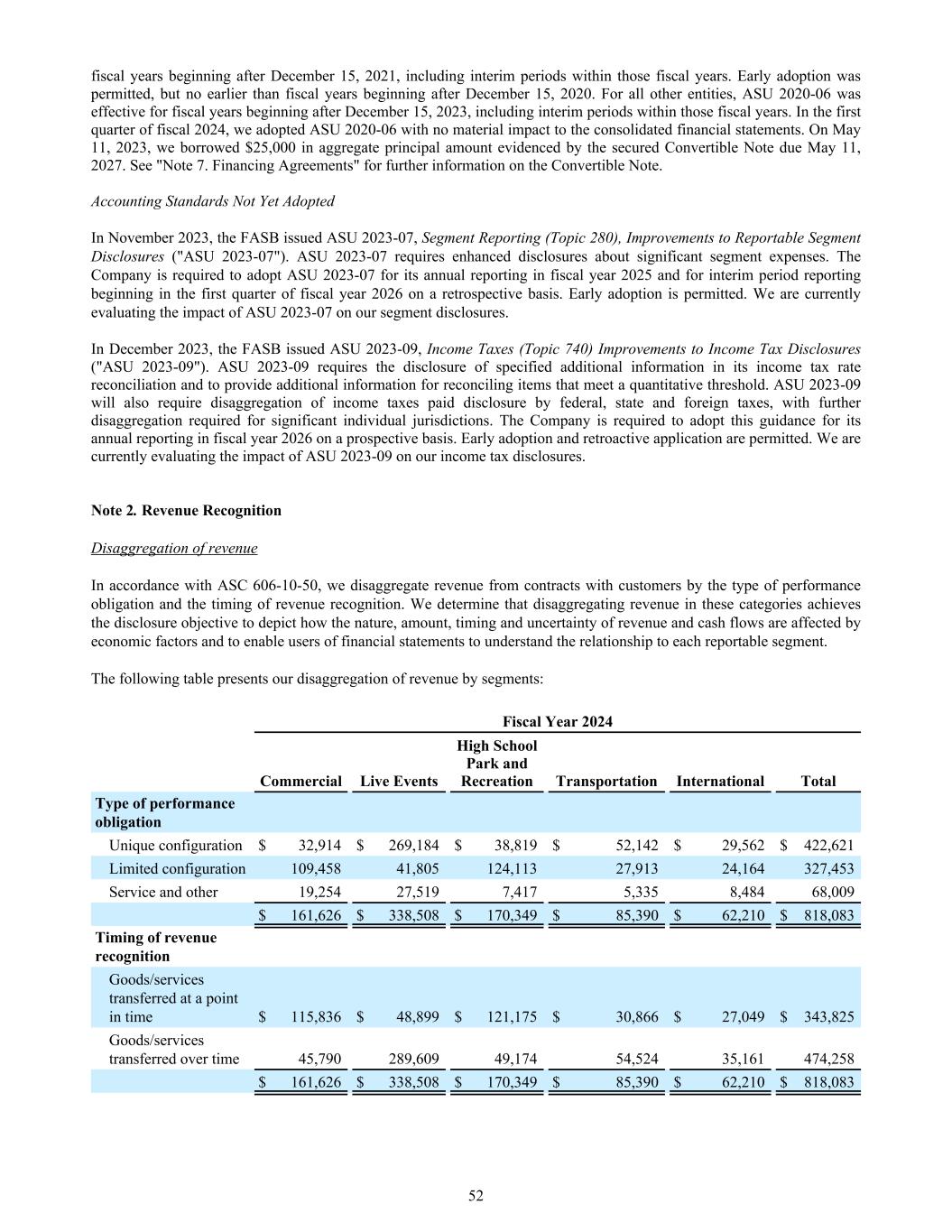
fiscal years beginning after December 15, 2021, including interim periods within those fiscal years. Early adoption was permitted, but no earlier than fiscal years beginning after December 15, 2020. For all other entities, ASU 2020-06 was effective for fiscal years beginning after December 15, 2023, including interim periods within those fiscal years. In the first quarter of fiscal 2024, we adopted ASU 2020-06 with no material impact to the consolidated financial statements. On May 11, 2023, we borrowed $25,000 in aggregate principal amount evidenced by the secured Convertible Note due May 11, 2027. See "Note 7. Financing Agreements" for further information on the Convertible Note. Accounting Standards Not Yet Adopted In November 2023, the FASB issued ASU 2023-07, Segment Reporting (Topic 280), Improvements to Reportable Segment Disclosures ("ASU 2023-07"). ASU 2023-07 requires enhanced disclosures about significant segment expenses. The Company is required to adopt ASU 2023-07 for its annual reporting in fiscal year 2025 and for interim period reporting beginning in the first quarter of fiscal year 2026 on a retrospective basis. Early adoption is permitted. We are currently evaluating the impact of ASU 2023-07 on our segment disclosures. In December 2023, the FASB issued ASU 2023-09, Income Taxes (Topic 740) Improvements to Income Tax Disclosures ("ASU 2023-09"). ASU 2023-09 requires the disclosure of specified additional information in its income tax rate reconciliation and to provide additional information for reconciling items that meet a quantitative threshold. ASU 2023-09 will also require disaggregation of income taxes paid disclosure by federal, state and foreign taxes, with further disaggregation required for significant individual jurisdictions. The Company is required to adopt this guidance for its annual reporting in fiscal year 2026 on a prospective basis. Early adoption and retroactive application are permitted. We are currently evaluating the impact of ASU 2023-09 on our income tax disclosures. Note 2. Revenue Recognition Disaggregation of revenue In accordance with ASC 606-10-50, we disaggregate revenue from contracts with customers by the type of performance obligation and the timing of revenue recognition. We determine that disaggregating revenue in these categories achieves the disclosure objective to depict how the nature, amount, timing and uncertainty of revenue and cash flows are affected by economic factors and to enable users of financial statements to understand the relationship to each reportable segment. The following table presents our disaggregation of revenue by segments: Fiscal Year 2024 Commercial Live Events High School Park and Recreation Transportation International Total Type of performance obligation Unique configuration $ 32,914 $ 269,184 $ 38,819 $ 52,142 $ 29,562 $ 422,621 Limited configuration 109,458 41,805 124,113 27,913 24,164 327,453 Service and other 19,254 27,519 7,417 5,335 8,484 68,009 $ 161,626 $ 338,508 $ 170,349 $ 85,390 $ 62,210 $ 818,083 Timing of revenue recognition Goods/services transferred at a point in time $ 115,836 $ 48,899 $ 121,175 $ 30,866 $ 27,049 $ 343,825 Goods/services transferred over time 45,790 289,609 49,174 54,524 35,161 474,258 $ 161,626 $ 338,508 $ 170,349 $ 85,390 $ 62,210 $ 818,083 52
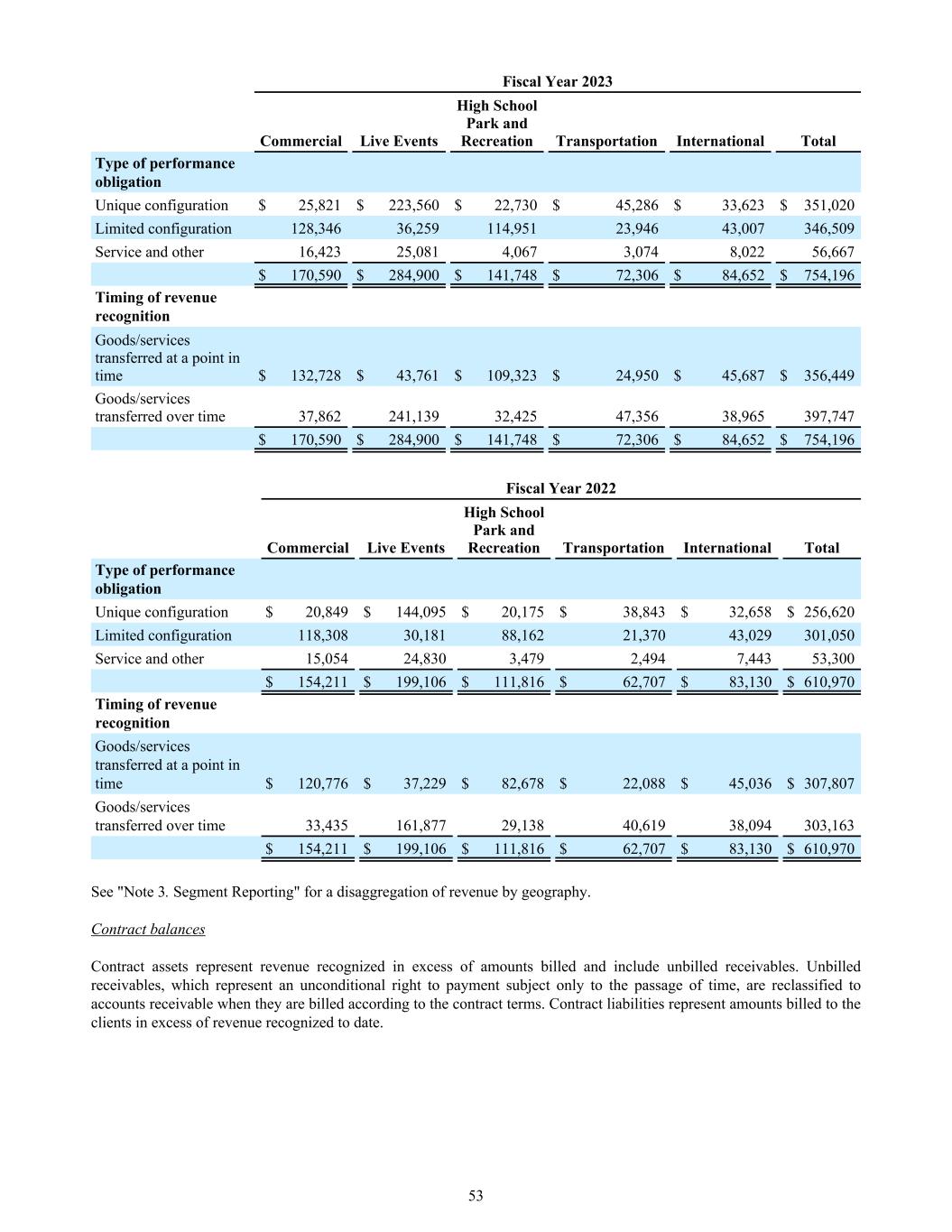
Fiscal Year 2023 Commercial Live Events High School Park and Recreation Transportation International Total Type of performance obligation Unique configuration $ 25,821 $ 223,560 $ 22,730 $ 45,286 $ 33,623 $ 351,020 Limited configuration 128,346 36,259 114,951 23,946 43,007 346,509 Service and other 16,423 25,081 4,067 3,074 8,022 56,667 $ 170,590 $ 284,900 $ 141,748 $ 72,306 $ 84,652 $ 754,196 Timing of revenue recognition Goods/services transferred at a point in time $ 132,728 $ 43,761 $ 109,323 $ 24,950 $ 45,687 $ 356,449 Goods/services transferred over time 37,862 241,139 32,425 47,356 38,965 397,747 $ 170,590 $ 284,900 $ 141,748 $ 72,306 $ 84,652 $ 754,196 Fiscal Year 2022 Commercial Live Events High School Park and Recreation Transportation International Total Type of performance obligation Unique configuration $ 20,849 $ 144,095 $ 20,175 $ 38,843 $ 32,658 $ 256,620 Limited configuration 118,308 30,181 88,162 21,370 43,029 301,050 Service and other 15,054 24,830 3,479 2,494 7,443 53,300 $ 154,211 $ 199,106 $ 111,816 $ 62,707 $ 83,130 $ 610,970 Timing of revenue recognition Goods/services transferred at a point in time $ 120,776 $ 37,229 $ 82,678 $ 22,088 $ 45,036 $ 307,807 Goods/services transferred over time 33,435 161,877 29,138 40,619 38,094 303,163 $ 154,211 $ 199,106 $ 111,816 $ 62,707 $ 83,130 $ 610,970 See "Note 3. Segment Reporting" for a disaggregation of revenue by geography. Contract balances Contract assets represent revenue recognized in excess of amounts billed and include unbilled receivables. Unbilled receivables, which represent an unconditional right to payment subject only to the passage of time, are reclassified to accounts receivable when they are billed according to the contract terms. Contract liabilities represent amounts billed to the clients in excess of revenue recognized to date. 53
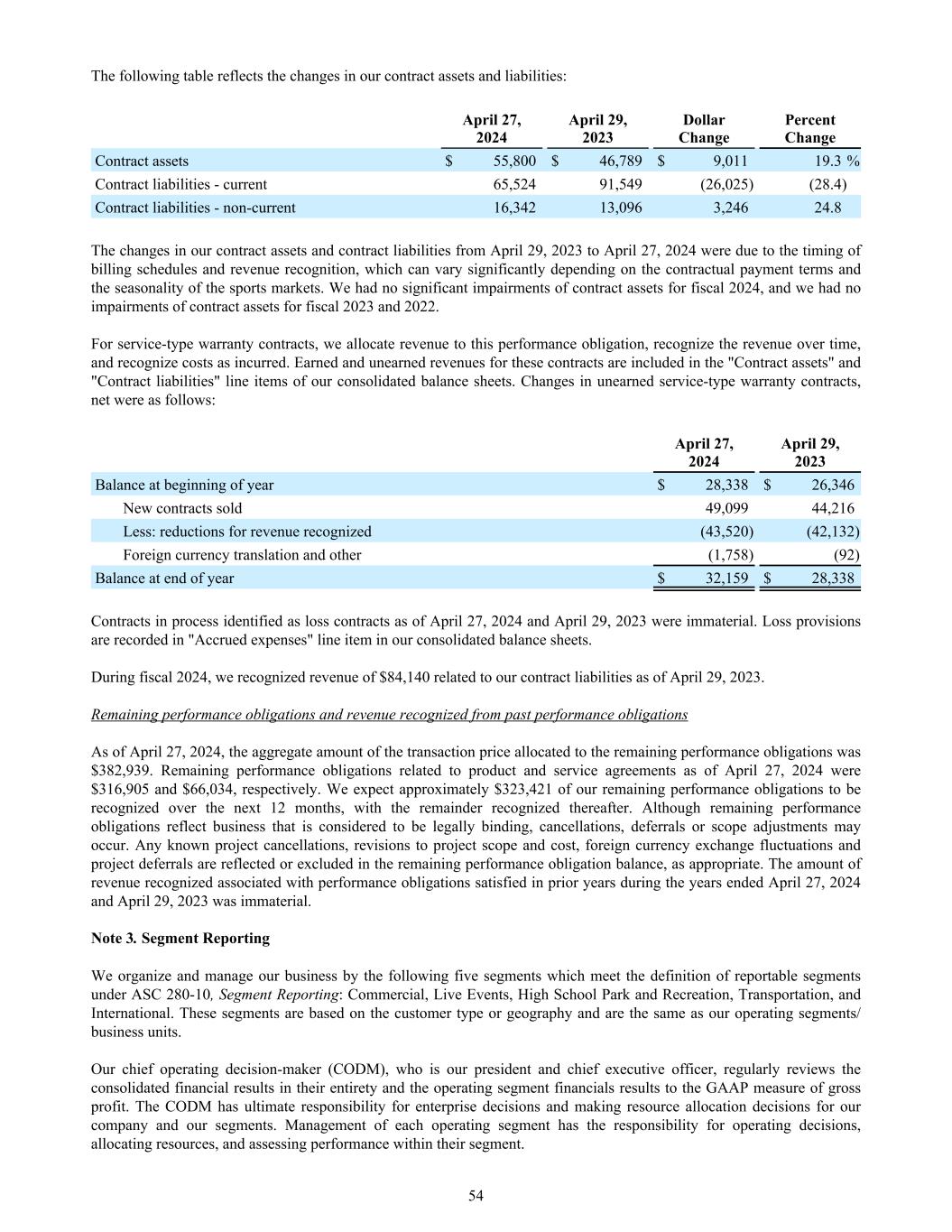
The following table reflects the changes in our contract assets and liabilities: April 27, 2024 April 29, 2023 Dollar Change Percent Change Contract assets $ 55,800 $ 46,789 $ 9,011 19.3 % Contract liabilities - current 65,524 91,549 (26,025) (28.4) Contract liabilities - non-current 16,342 13,096 3,246 24.8 The changes in our contract assets and contract liabilities from April 29, 2023 to April 27, 2024 were due to the timing of billing schedules and revenue recognition, which can vary significantly depending on the contractual payment terms and the seasonality of the sports markets. We had no significant impairments of contract assets for fiscal 2024, and we had no impairments of contract assets for fiscal 2023 and 2022. For service-type warranty contracts, we allocate revenue to this performance obligation, recognize the revenue over time, and recognize costs as incurred. Earned and unearned revenues for these contracts are included in the "Contract assets" and "Contract liabilities" line items of our consolidated balance sheets. Changes in unearned service-type warranty contracts, net were as follows: April 27, 2024 April 29, 2023 Balance at beginning of year $ 28,338 $ 26,346 New contracts sold 49,099 44,216 Less: reductions for revenue recognized (43,520) (42,132) Foreign currency translation and other (1,758) (92) Balance at end of year $ 32,159 $ 28,338 Contracts in process identified as loss contracts as of April 27, 2024 and April 29, 2023 were immaterial. Loss provisions are recorded in "Accrued expenses" line item in our consolidated balance sheets. During fiscal 2024, we recognized revenue of $84,140 related to our contract liabilities as of April 29, 2023. Remaining performance obligations and revenue recognized from past performance obligations As of April 27, 2024, the aggregate amount of the transaction price allocated to the remaining performance obligations was $382,939. Remaining performance obligations related to product and service agreements as of April 27, 2024 were $316,905 and $66,034, respectively. We expect approximately $323,421 of our remaining performance obligations to be recognized over the next 12 months, with the remainder recognized thereafter. Although remaining performance obligations reflect business that is considered to be legally binding, cancellations, deferrals or scope adjustments may occur. Any known project cancellations, revisions to project scope and cost, foreign currency exchange fluctuations and project deferrals are reflected or excluded in the remaining performance obligation balance, as appropriate. The amount of revenue recognized associated with performance obligations satisfied in prior years during the years ended April 27, 2024 and April 29, 2023 was immaterial. Note 3. Segment Reporting We organize and manage our business by the following five segments which meet the definition of reportable segments under ASC 280-10, Segment Reporting: Commercial, Live Events, High School Park and Recreation, Transportation, and International. These segments are based on the customer type or geography and are the same as our operating segments/ business units. Our chief operating decision-maker (CODM), who is our president and chief executive officer, regularly reviews the consolidated financial results in their entirety and the operating segment financials results to the GAAP measure of gross profit. The CODM has ultimate responsibility for enterprise decisions and making resource allocation decisions for our company and our segments. Management of each operating segment has the responsibility for operating decisions, allocating resources, and assessing performance within their segment. 54

• Our Commercial business unit primarily consists of sales of our integrated video display systems, digital billboards, Galaxy® and Fuelight™ product lines, and dynamic messaging systems to resellers (primarily sign companies), out-of-home ("OOH") companies, national retailers, quick-serve restaurants, casinos, shopping centers, cruise ships, commercial building owners, and petroleum retailers. • Our Live Events business unit primarily consists of sales of integrated scoring and video display systems to college and professional sports facilities and convention centers and sales of our mobile display technology to video rental organizations and other live events type venues. • Our High School Park and Recreation business unit primarily consists of sales of scoring systems, Galaxy® displays and video display systems to primary and secondary education facilities and resellers (primarily sign companies). • Our Transportation business unit primarily consists of sales of intelligent transportation systems dynamic messaging signs for road management, mass transit, and aviation applications and other electronic signage for advertising and way-finding needs, which includes our Vanguard® and Galaxy® product lines and other intelligent transportation systems dynamic message signs, to governmental transportation departments, transportation industry contractors, airlines and other transportation related customers. • Our International business unit consists of sales of all product lines outside the United States and Canada. In our International business unit, we focus on product lines related to integrated scoring and video display systems for sports and commercial applications, OOH advertising products, architectural lighting, and transportation related products for sale outside of the United States and Canada to the related type of company, including sports and commercial business facilities, OOH companies, and governmental transportation agencies. Our segments follow the same accounting policies as those described in "Note 1. Nature of Business and Summary of Significant Accounting Policies." Some expenses or services are not directly allocable to a sale or segment or the resources and related expenses are shared across business segment areas. These expenses are allocated using estimates and allocation methodologies based on financial measures and professional judgment. Shared or unabsorbed manufacturing costs are allocated to the business unit benefiting most from that manufacturing location's production capabilities. Shared or unabsorbed costs of domestic field sales and services infrastructure, including most field administrative staff, are allocated to the Commercial, Live Events, High School Park and Recreation, and Transportation business units based on cost of sales. Shared manufacturing, buildings and utilities, and procurement costs are allocated based on payroll dollars, square footage and various other financial measures in the segment analysis. Assets are not allocated to the segments. Depreciation and amortization are allocated to each segment based on various financial measures; however, some depreciation and amortization are corporate in nature and remain unallocated We do not maintain information on sales by products; therefore, disclosure of such information is not practical. 55
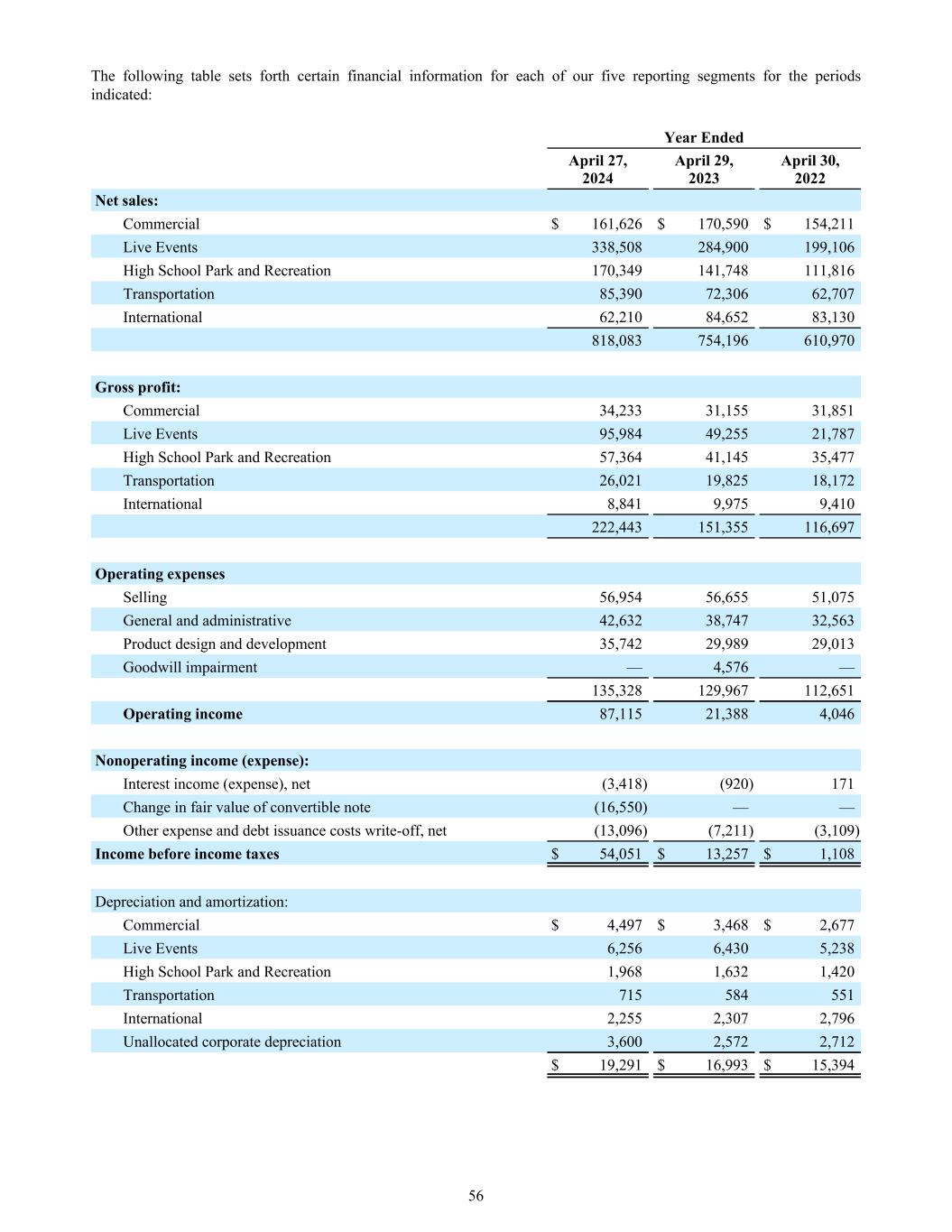
The following table sets forth certain financial information for each of our five reporting segments for the periods indicated: Year Ended April 27, 2024 April 29, 2023 April 30, 2022 Net sales: Commercial $ 161,626 $ 170,590 $ 154,211 Live Events 338,508 284,900 199,106 High School Park and Recreation 170,349 141,748 111,816 Transportation 85,390 72,306 62,707 International 62,210 84,652 83,130 818,083 754,196 610,970 Gross profit: Commercial 34,233 31,155 31,851 Live Events 95,984 49,255 21,787 High School Park and Recreation 57,364 41,145 35,477 Transportation 26,021 19,825 18,172 International 8,841 9,975 9,410 222,443 151,355 116,697 Operating expenses Selling 56,954 56,655 51,075 General and administrative 42,632 38,747 32,563 Product design and development 35,742 29,989 29,013 Goodwill impairment — 4,576 — 135,328 129,967 112,651 Operating income 87,115 21,388 4,046 Nonoperating income (expense): Interest income (expense), net (3,418) (920) 171 Change in fair value of convertible note (16,550) — — Other expense and debt issuance costs write-off, net (13,096) (7,211) (3,109) Income before income taxes $ 54,051 $ 13,257 $ 1,108 Depreciation and amortization: Commercial $ 4,497 $ 3,468 $ 2,677 Live Events 6,256 6,430 5,238 High School Park and Recreation 1,968 1,632 1,420 Transportation 715 584 551 International 2,255 2,307 2,796 Unallocated corporate depreciation 3,600 2,572 2,712 $ 19,291 $ 16,993 $ 15,394 56

No single geographic area comprises a material amount of our net sales or property and equipment, net of accumulated depreciation, other than the United States. The following table presents information about net sales and property and equipment, net of accumulated depreciation, in the United States and elsewhere: Year Ended April 27, 2024 April 29, 2023 April 30, 2022 Net sales: United States $ 744,419 $ 661,312 $ 513,740 Outside United States 73,664 92,884 97,230 $ 818,083 $ 754,196 $ 610,970 Property and equipment, net of accumulated depreciation: United States $ 64,332 $ 63,786 $ 58,643 Outside United States 7,420 8,361 8,122 $ 71,752 $ 72,147 $ 66,765 We have numerous customers worldwide for sales of our products and services, and no customer accounted for 10 percent or more of net sales; therefore, we are not economically dependent on a limited number of customers for the sale of our products and services. We have numerous raw material and component suppliers, and no supplier accounts for 10% or more of our cost of sales; however, we have a complex global supply chain subject to geopolitical and transportation risks and a number of single- source suppliers that could limit our supply or cause delays in obtaining raw materials and components needed in manufacturing. Note 4. Goodwill and Intangible Assets Goodwill The changes in the carrying amount of goodwill related to each reportable segment for the fiscal year ended April 27, 2024 were as follows: Commercial Transportation Total Balance as of April 29, 2023: $ 3,198 $ 41 $ 3,239 Foreign currency translation (10) (3) (13) Goodwill impairment — — — Balance as of April 27, 2024: $ 3,188 $ 38 $ 3,226 We perform an analysis of goodwill on an annual basis, and it is tested for impairment more frequently if events or changes in circumstances indicate that an asset might be impaired. Our annual analysis is performed during our third quarter of each fiscal year based on the goodwill amount as of the first business day of our third fiscal quarter. We performed our annual impairment test on October 29, 2023 and concluded no goodwill impairment existed for fiscal year 2024. The annual impairment test for fiscal year 2023 concluded that the carrying value of the Live Events and International reporting units exceeded their respective fair values and consequently recorded an a $4,576 impairment charge. We determined the fair value of the reporting units based on an income approach, using the present value of future discounted cash flows. Significant estimates used to determine fair value include the weighted average cost of capital and financial forecasts. The recognized impairment was primarily a result of our weighted average cost of capital being notably higher, which was driven by strains on our liquidity caused by disrupted supply chains and geopolitical conditions during fiscal 2024. As a result, the present value of our future cash flows was lower, which caused the impairment charge. Based on our annual impairment test, we concluded that the fair value of the Commercial and Transportation reporting units exceeded 57

their respective carrying values and concluded no goodwill impairment existed for those reporting units. The annual impairment test for fiscal year 2022 concluded no goodwill impairment existed. Accumulated impairments to goodwill as of April 27, 2024 was $4,576. Intangible Assets The following table summarizes intangible assets, net, as of April 27, 2024 and April 29, 2023: April 27, 2024 Weighted Average Life (in years) Gross Carrying Amount Accumulated Amortization Net Carrying Amount Registered trademarks 20.0 $ 636 $ 296 $ 340 Customer relationships 10.3 2,549 2,049 500 Total 12.2 $ 3,185 $ 2,345 $ 840 April 29, 2023 Weighted Average Life (in years) Gross Carrying Amount Accumulated Amortization Net Carrying Amount Registered trademarks 20.0 $ 650 $ 270 $ 380 Customer relationships 10.3 2,563 1,807 756 Total 12.2 $ 3,213 $ 2,077 $ 1,136 In the fiscal years 2024, 2023, and 2022, amortization expense was $287, $290, and $504, respectively. Amortization expenses are included primarily in product design and development and selling expense in the consolidated statements of operations. Intangible assets are written off when fully amortized. As of April 27, 2024, amortization expenses for future periods were estimated to be as follows: Fiscal years ending Amount 2025 $ 283 2026 252 2027 36 2028 36 2029 36 Thereafter 197 Total expected amortization expense $ 840 Note 5. Selected Financial Statement Data Inventories consisted of the following: April 27, 2024 April 29, 2023 Raw materials $ 66,900 $ 81,627 Work-in-process 13,848 14,155 Finished goods 57,260 53,666 $ 138,008 $ 149,448 58

Property and equipment, net consisted of the following: April 27, 2024 April 29, 2023 Land $ 2,895 $ 1,996 Buildings 71,670 71,222 Machinery and equipment 131,983 126,164 Office furniture and equipment 3,765 4,112 Computer software and hardware 46,135 44,700 Construction in Process 5,064 2,805 Demonstration equipment 7,094 7,432 Transportation equipment 7,667 7,057 276,273 265,488 Less accumulated depreciation 204,521 193,341 $ 71,752 $ 72,147 Our depreciation expense was $17,453, $16,703, and $14,890 for the fiscal years 2024, 2023, and 2022, respectively. Accrued expenses consisted of the following: April 27, 2024 April 29, 2023 Compensation $ 27,365 $ 17,466 Taxes, other than income taxes 3,410 3,390 Accrued employee benefits 3,871 3,953 Operating lease liabilities 1,984 2,253 Short-term accrued expenses 6,398 8,943 $ 43,028 $ 36,005 59
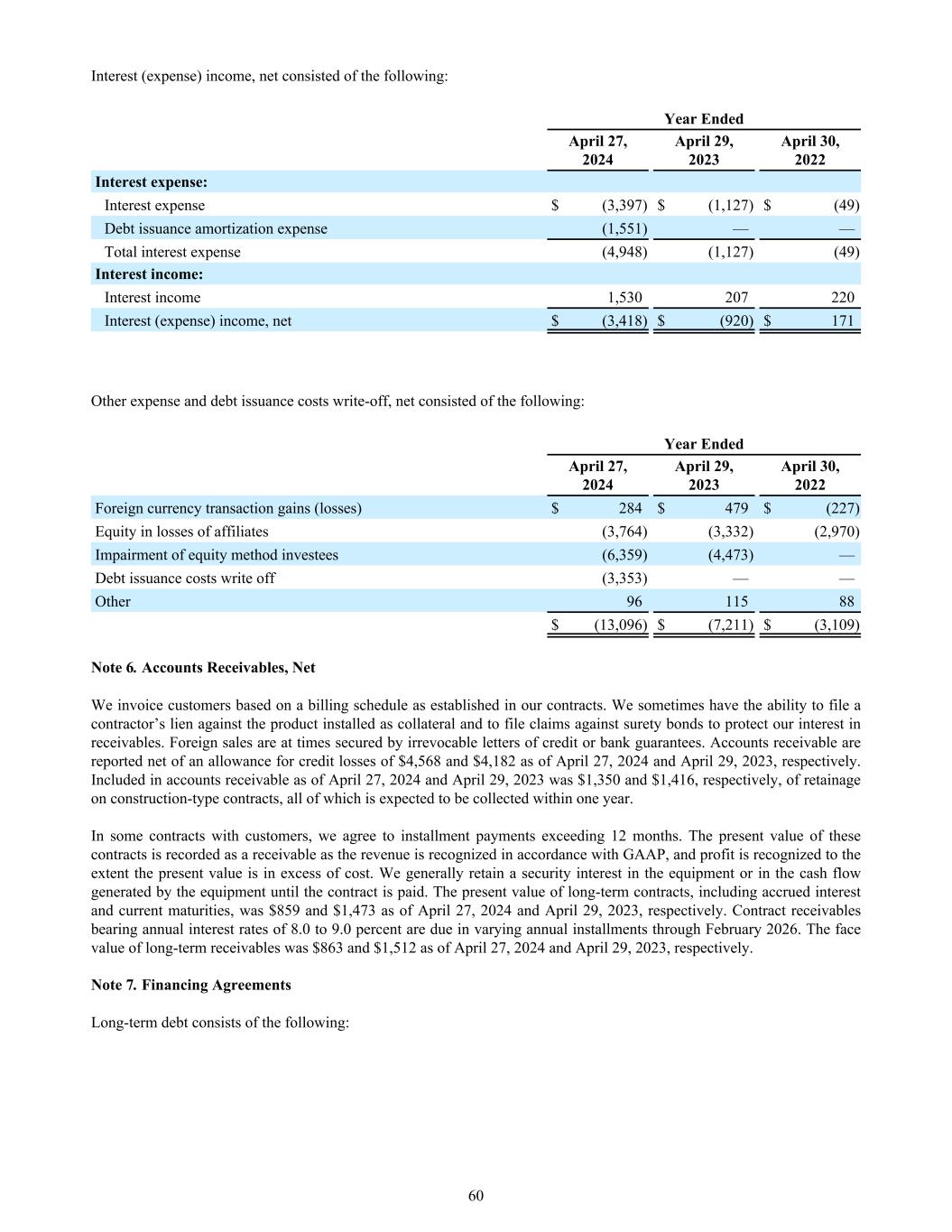
Interest (expense) income, net consisted of the following: Year Ended April 27, 2024 April 29, 2023 April 30, 2022 Interest expense: Interest expense $ (3,397) $ (1,127) $ (49) Debt issuance amortization expense (1,551) — — Total interest expense (4,948) (1,127) (49) Interest income: Interest income 1,530 207 220 Interest (expense) income, net $ (3,418) $ (920) $ 171 Other expense and debt issuance costs write-off, net consisted of the following: Year Ended April 27, 2024 April 29, 2023 April 30, 2022 Foreign currency transaction gains (losses) $ 284 $ 479 $ (227) Equity in losses of affiliates (3,764) (3,332) (2,970) Impairment of equity method investees (6,359) (4,473) — Debt issuance costs write off (3,353) — — Other 96 115 88 $ (13,096) $ (7,211) $ (3,109) Note 6. Accounts Receivables, Net We invoice customers based on a billing schedule as established in our contracts. We sometimes have the ability to file a contractor’s lien against the product installed as collateral and to file claims against surety bonds to protect our interest in receivables. Foreign sales are at times secured by irrevocable letters of credit or bank guarantees. Accounts receivable are reported net of an allowance for credit losses of $4,568 and $4,182 as of April 27, 2024 and April 29, 2023, respectively. Included in accounts receivable as of April 27, 2024 and April 29, 2023 was $1,350 and $1,416, respectively, of retainage on construction-type contracts, all of which is expected to be collected within one year. In some contracts with customers, we agree to installment payments exceeding 12 months. The present value of these contracts is recorded as a receivable as the revenue is recognized in accordance with GAAP, and profit is recognized to the extent the present value is in excess of cost. We generally retain a security interest in the equipment or in the cash flow generated by the equipment until the contract is paid. The present value of long-term contracts, including accrued interest and current maturities, was $859 and $1,473 as of April 27, 2024 and April 29, 2023, respectively. Contract receivables bearing annual interest rates of 8.0 to 9.0 percent are due in varying annual installments through February 2026. The face value of long-term receivables was $863 and $1,512 as of April 27, 2024 and April 29, 2023, respectively. Note 7. Financing Agreements Long-term debt consists of the following: 60

April 27, 2024 April 29, 2023 ABL credit facility/prior line of credit $ — $ 17,750 Mortgage 13,875 — Convertible note 25,000 — Long-term debt, gross 38,875 17,750 Debt issuance costs, net (761) — Change in fair value of convertible note 16,550 — Current portion (1,500) — Long-term debt, net $ 53,164 $ 17,750 Credit Agreements On May 11, 2023, we closed on a $75,000 senior credit facility (the "Credit Facility"). The Credit Facility consists of a $60,000 asset-based revolving credit facility (the "ABL") maturing on May 11. 2026, which is secured by first priority lien on the Company's assets and is subject to certain factors that can impact our borrowing capacity, and a $15,000 delayed draw loan (the "Delayed Draw Loan") secured by a first priority mortgage on our Brookings, South Dakota real estate (the "Mortgage"). The ABL and Delayed Draw Loan are evidenced by a Credit Agreement dated as of May 11, 2023 (the "Credit Agreement") between the Company and JPMorgan Chase Bank, N.A., as the lender. On May 11, 2023, the Company paid all amounts outstanding on the prior credit agreement, and this prior credit agreement was terminated as of that date. No gain or loss was recognized upon termination, and the Company incurred no early termination penalties in connection with such termination. Under the ABL, certain factors can impact our borrowing capacity. As of April 27, 2024, our total borrowing capacity was $39,507 there were no borrowings outstanding, and there was $5,342 used to secure letters of credit outstanding leaving $34,165 available to borrow. We made no borrowings on this ABL during fiscal 2024. The interest rate on the ABL is set on a sliding scale based on the trailing 12-month fixed charge coverage and ranges from 2.5 to 3.5 percent over the standard overnight financing rate (SOFR). The ABL is secured by a first priority lien on the Company's assets described in the Credit Agreement and the Pledge and Security Agreement dated as of May 11, 2023 by and among the Company, Daktronics Installation, Inc. and JPMorgan Chase Bank, N.A. The $15,000 Delayed Draw Loan was funded on July 7, 2023 and is secured by the Mortgage on the Company's Brookings, South Dakota real estate. It amortizes over 10 years and has monthly payments of $125. The Delayed Draw Loan is subject to the terms of the Credit Agreement and matures on May 11, 2026. The interest rate on the Delayed Draw Loan is set on a sliding scale based on the trailing 12-month fixed charge coverage ratio and ranges between 1.0 and 2.0 percent over the Commercial Bank Floating Rate (CBFR). The interest rate as of April 27, 2024 for Delayed Draw Loan was 9.5 percent. Convertible Note On May 11, 2023, we borrowed $25,000 in aggregate principal amount evidenced by the secured Convertible Note due May 11, 2027. The Convertible Note holder (the "Holder") has a second priority lien on assets securing the ABL facility and a first priority lien on substantially all of the other assets of the Company, excluding all real property, subject to the Intercreditor Agreement dated as of May 11, 2023 by and among the Company, JPMorgan Chase Bank N.A., and the Holder of the Convertible Note. Conversion Features • The Convertible Note allows the Holder and any of the Holder’s permitted transferees, donees, pledgees, assignees or successors-in-interest (collectively, the “Selling Shareholders”) to convert all or any portion of the principal amount of the Convertible Note, together with any accrued and unpaid interest and any other unpaid amounts, including late charges, if any (together, the “Conversion Amount”), into shares of the Company’s common stock at an initial conversion price of $6.31 per share, subject to adjustment in accordance with the terms of the Convertible Note (the “Conversion Price”). 61

• The Company also has a forced conversion right, which is exercisable on the occurrence of certain conditions set forth in the Convertible Note, pursuant to which it can cause all or any portion of the outstanding and unpaid Conversion Amount to be converted into shares of common stock at the Conversion Price. Additionally, if the Company fails other than by reason of a failure by the Holder to comply with its obligations, the Holder is permitted to cash payments from the Company until such conversion failure is cured. Redemption Features • If the Company were to have an "Event of Default", as defined by the Convertible Note, then the Holder may require the Company to redeem all or any portion of the Convertible Note. • If the Company has a "Change of Control", as defined by the Convertible Note, then the Holder is entitled to payment of the outstanding amount of the Convertible Note at the "Change in Control Redemption Price," as defined in the Convertible Note. Interest Interest accruing under the Convertible Note is payable, at the option of the Company, in either (i) cash or (ii) a combination of cash interest and capitalized interest; provided, however, that at least fifty percent (50%) of the interest paid on each interest date must be paid as cash interest. The Convertible Note accrues interest (or is payable) quarterly at an annual rate of 9.0 percent when interest is paid in cash or an annual rate of 10.0 percent if interest is paid in kind. Upon an event of default under the Convertible Note, the annual interest rate will increase to 12.0 percent. The annual rate of 9.0 percent was used to calculate the interest accrued as of April 27, 2024, as interest will be paid in cash. We elected the fair value option to account for the Convertible Note as described in "Note 14. Fair Value Measurement". The financial liability was initially measured at its issue-date fair value and is subsequently remeasured at fair value on a recurring basis at each reporting period date. We have elected to present the fair value and the accrued interest component separately in the consolidated statements of operations. Therefore, interest will be recognized and accrued separately in interest expense, with changes in fair value of the Convertible Note presented in the "Change in fair value of convertible note" line item in our consolidated statements of operations. The changes in fair value of the Convertible Note during fiscal 2024 was as follows: Liability Component (in thousands) Balance as of May 11, 2023 $ 25,000 Redemption of convertible promissory note — Fair value change recognized 16,550 Balance as of April 27, 2024 $ 41,550 The estimated fair value of the Convertible Note upon its issuance date of May 11, 2023 was its face value because it was negotiated at arms length and as of April 27, 2024 was computed using a binomial lattice model which incorporates significant inputs that are not observable in the market and thus represents a Level 3 measurement. We determined the fair value by using the following key assumptions in the binomial lattice model: Risk-Free Rate (Annual) 4.78 % Implied Yield 16.28 % Volatility (Annual) 40.00 % Dividend Yield (Annual) — % The Credit Agreement and the Convertible Note require a fixed charge coverage ratio of greater than 1.1 and include other customary non-financial covenants. As of April 27, 2024, we were in compliance with our financial covenants under the Credit Agreement and the Convertible Note. 62

Debt Issuance Costs Debt issuance costs incurred and capitalized are amortized on a straight-line basis over the term of the associated debt agreement. If early principal payments or conversions occur, a proportional amount of unamortized debt issuance costs is expensed. As part of these financings, we capitalized $8,195 in debt issuance costs. During the fiscal year ended April 27, 2024, due to the Convertible Note being accounted for at fair value, we expensed $3,353 of the related debt issuance costs which is included in the "Other expense and debt issuance costs write-off, net" line item in our consolidated statements of operations. During the fiscal year ended April 27, 2024, we amortized $1,551 of debt issuance costs. The remaining debt issuance costs of $3,291 are being amortized over the three-year term of the Credit Facility. Future Maturities Aggregate contractual maturities of debt in future fiscal years are as follows: Fiscal years ending Amount 2025 1,500 2026 1,500 2027 10,875 2028 25,000 2029 and beyond — Total debt $ 38,875 Note 8. Share Repurchase Program On June 16, 2016, our Board of Directors approved a stock repurchase program under which we may purchase up to $40,000 of the Company's outstanding shares of common stock. Under this program, we may repurchase shares from time to time in open market transactions and in privately negotiated transactions based on business, market, applicable legal requirements and other considerations. The repurchase program does not require the repurchase of a specific number of shares and may be terminated at any time. In April 2020, the Board had suspended the program. On December 2, 2021, the Board of Directors of Daktronics voted to reauthorize the stock repurchase program. During fiscal 2024 and 2023, we had no repurchases of shares of our outstanding common stock. During fiscal 2022, we repurchased 641 shares of common stock at a total cost of $3,184. As of April 27, 2024, we had $29,355 of remaining capacity under our current share repurchase program. Note 9. Leases We lease facilities and various equipment to manufacture products and provide employee collaboration space and tools. These are all classified as operating leases and have initial lease terms ranging from 1 year to 5 years. These operating leases do not contain material residual value guarantees or material restrictive covenants. Our lease for our facility in Sioux Falls, South Dakota has a purchase option. We have no material financing leases. We determine if an arrangement is a lease at the inception of the lease. Leases with an initial term of 12 months or less are not recorded on the balance sheet. Right-of-use assets represent our right to use an underlying asset for the lease term, and lease liabilities represent our obligation to make lease payments arising from the lease. Operating lease right-of-use assets and liabilities are recognized at the commencement date based on the present value of lease payments over the lease term. As we are generally not able to determine the rate implicit in our leases, we use the incremental borrowing rate based on the information available at the commencement date in determining the present value of future lease payments. The operating lease right-of-use asset includes any prepaid lease payments and initial direct costs and excludes any lease incentives and impairments. Some of our leases include options to extend the term, which is only included in the right-of- use assets and lease liability calculation when it is reasonably certain that we will exercise that option. We have lease agreements with lease and non-lease components, and we have elected to account for all asset classes as a single lease 63
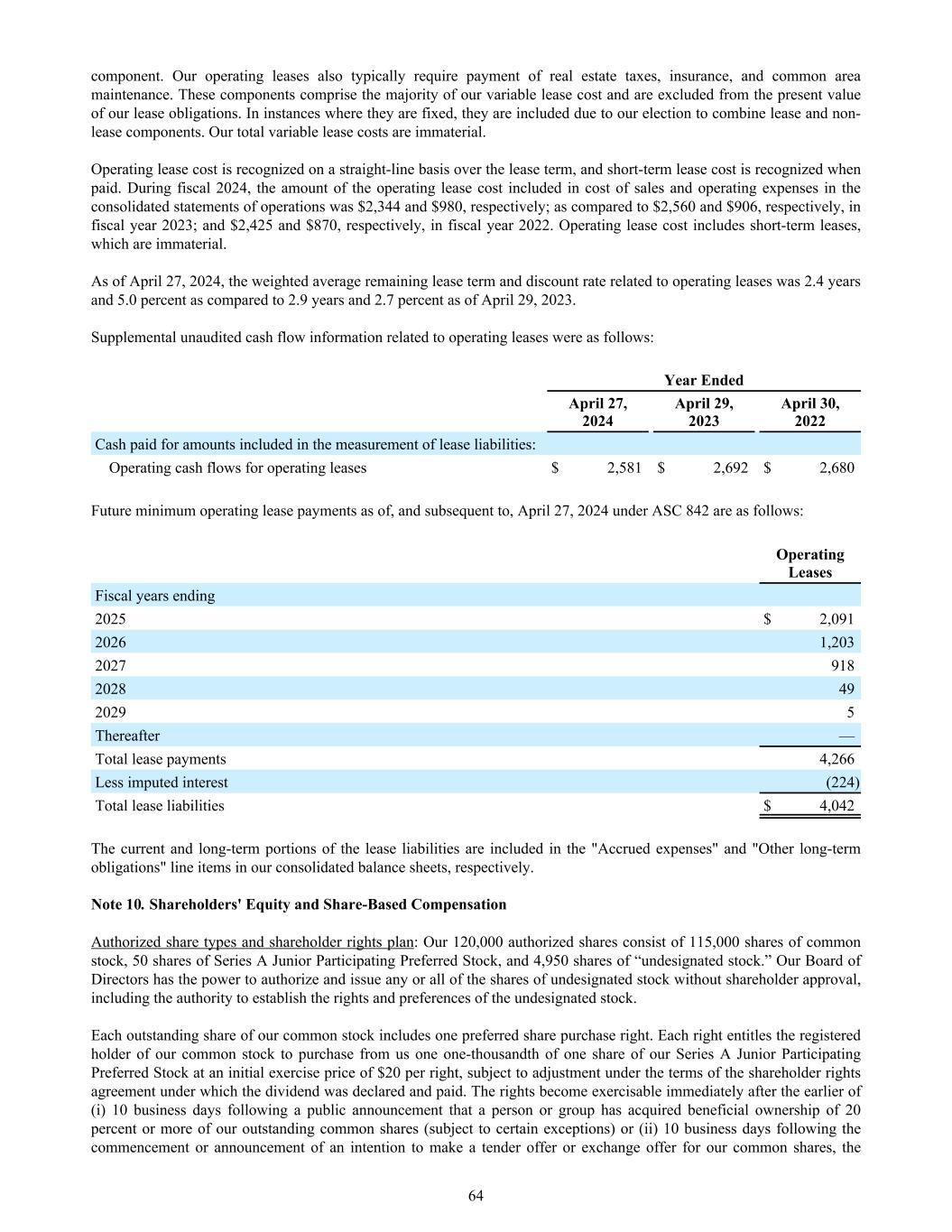
component. Our operating leases also typically require payment of real estate taxes, insurance, and common area maintenance. These components comprise the majority of our variable lease cost and are excluded from the present value of our lease obligations. In instances where they are fixed, they are included due to our election to combine lease and non- lease components. Our total variable lease costs are immaterial. Operating lease cost is recognized on a straight-line basis over the lease term, and short-term lease cost is recognized when paid. During fiscal 2024, the amount of the operating lease cost included in cost of sales and operating expenses in the consolidated statements of operations was $2,344 and $980, respectively; as compared to $2,560 and $906, respectively, in fiscal year 2023; and $2,425 and $870, respectively, in fiscal year 2022. Operating lease cost includes short-term leases, which are immaterial. As of April 27, 2024, the weighted average remaining lease term and discount rate related to operating leases was 2.4 years and 5.0 percent as compared to 2.9 years and 2.7 percent as of April 29, 2023. Supplemental unaudited cash flow information related to operating leases were as follows: Year Ended April 27, 2024 April 29, 2023 April 30, 2022 Cash paid for amounts included in the measurement of lease liabilities: Operating cash flows for operating leases $ 2,581 $ 2,692 $ 2,680 Future minimum operating lease payments as of, and subsequent to, April 27, 2024 under ASC 842 are as follows: Operating Leases Fiscal years ending 2025 $ 2,091 2026 1,203 2027 918 2028 49 2029 5 Thereafter — Total lease payments 4,266 Less imputed interest (224) Total lease liabilities $ 4,042 The current and long-term portions of the lease liabilities are included in the "Accrued expenses" and "Other long-term obligations" line items in our consolidated balance sheets, respectively. Note 10. Shareholders' Equity and Share-Based Compensation Authorized share types and shareholder rights plan: Our 120,000 authorized shares consist of 115,000 shares of common stock, 50 shares of Series A Junior Participating Preferred Stock, and 4,950 shares of “undesignated stock.” Our Board of Directors has the power to authorize and issue any or all of the shares of undesignated stock without shareholder approval, including the authority to establish the rights and preferences of the undesignated stock. Each outstanding share of our common stock includes one preferred share purchase right. Each right entitles the registered holder of our common stock to purchase from us one one-thousandth of one share of our Series A Junior Participating Preferred Stock at an initial exercise price of $20 per right, subject to adjustment under the terms of the shareholder rights agreement under which the dividend was declared and paid. The rights become exercisable immediately after the earlier of (i) 10 business days following a public announcement that a person or group has acquired beneficial ownership of 20 percent or more of our outstanding common shares (subject to certain exceptions) or (ii) 10 business days following the commencement or announcement of an intention to make a tender offer or exchange offer for our common shares, the 64

consummation of which would result in the beneficial ownership by a person or group of 20 percent or more of our outstanding common shares. The rights expire on November 19, 2024, which date may be extended by our Board of Directors subject to certain additional conditions. Stock incentive plans: During fiscal 2021, we established the Daktronics, Inc. 2020 Stock Incentive Plan (“2020 Plan”) and ceased granting options under the 2015 Stock Incentive Plan ("2015 Plan"). The 2020 Plan provides for the issuance of stock-based awards, including stock options, restricted stock, restricted stock units and deferred stock to employees, directors and consultants. Stock options issued to employees under the 2015 Plan and 2020 Plan generally have a 10-year life, an exercise price equal to the closing market value on the grant date and a five-year annual vesting period. The restricted stock granted to independent directors vests in one year, provided that the directors remain on the Board. Restricted stock units are granted to employees and have a five-year annual vesting period. As with stock options, restricted stock and restricted stock unit ownership cannot be transferred during the vesting period. As of April 27, 2024, the aggregate number of shares available for future grants under the 2020 Plan for stock options and restricted stock awards was 1,631 shares. Shares of common stock subject to all stock awards granted under the 2020 Plan are counted as one share of stock for each share of stock subject to the award. Although the 2015 Plan remains in effect for options outstanding that were granted under the 2015 Plan until the earlier of the exercise of the options or their expiration or termination without being exercised, no new options can be granted under the 2015 Plan. Restricted stock and restricted stock units: We issue restricted stock to our non-employee directors and restricted stock units to employees. Restricted stock issued to non-employee directors are participating securities and receive dividends prior to vesting. Unvested restricted stock will terminate and be forfeited upon termination of employment or service. The fair value of restricted stock and our restricted stock unit awards are measured on the grant date based on the market value of our common stock. The related compensation expense as calculated under ASC 718, net of estimated forfeitures, is recognized over the applicable vesting period. Unrecognized compensation expense related to the restricted stock and restricted stock unit awards was approximately $1,977 as of April 27, 2024, which is expected to be recognized over a weighted-average period of 2.76 years. The total fair value of restricted stock vested was $1,536, $1,160, and $1,203 in fiscal years 2024, 2023, and 2022, respectively. A summary of non-vested restricted stock and restricted stock units for fiscal years 2024, 2023, and 2022 is as follows: Year Ended April 27, 2024 April 29, 2023 April 30, 2022 Number of Nonvested Shares Weighted Average Grant Date Fair Value Per Share Number of Nonvested Shares Weighted Average Grant Date Fair Value Per Share Number of Nonvested Shares Weighted Average Grant Date Fair Value Per Share Outstanding at beginning of year 617 $ 4.11 469 $ 5.65 480 $ 5.62 Granted 159 9.85 360 3.15 214 5.66 Vested (280) 3.92 (192) 5.98 (213) 5.58 Forfeited (10) 4.77 (20) 4.98 (12) 5.64 Outstanding at end of year 486 $ 5.95 617 $ 4.11 469 $ 5.65 65

Stock Options: We issue incentive stock options to our employees and non-qualified stock options to our independent directors. A summary of stock option activity under our 2015 Plan and 2020 Plan during the fiscal year ended April 27, 2024 is as follows: Stock Options Weighted Average Exercise Price Per Share Weighted Average Remaining Contractual Life (Years) Aggregate Intrinsic Value Outstanding as of April 29, 2023 2,045 $ 7.11 5.52 $ 858 Granted 37 9.85 — — Cancelled or forfeited (228) 10.26 — — Exercised (219) 5.94 — 708 Outstanding as of April 27, 2024 1,635 $ 6.89 5.06 $ 4,607 Shares vested and expected to vest 1,614 $ 6.93 5.03 $ 4,503 Exercisable as of April 27, 2024 1,034 $ 8.30 3.63 $ 1,695 The aggregate intrinsic value of stock options represents the difference between the exercise price of stock options and the fair market value of the underlying common stock for all in-the-money options. We define in-the-money options as of April 27, 2024 as options having exercise prices lower than the $9.29 per share market price of our common stock on that date. There were 593 shares exercisable that were in-the-money options as of April 27, 2024. The total intrinsic value of options exercised during fiscal years 2024, 2023, and 2022 was $708, $7, and $2, respectively. The total fair value of stock options vested was $453, $467, and $465 for fiscal years 2024, 2023, and 2022, respectively. We estimate the fair value of stock options granted using the Black-Scholes option valuation model. We recognize the fair value of the stock options on a straight-line basis as compensation expense. All options are recognized over the requisite service periods of the awards, which are generally the vesting periods. The Black-Scholes option-pricing model was developed for use in estimating the fair value of traded options which have no vesting restrictions and are fully transferable. In addition, option valuation models require the input of highly subjective assumptions, including the expected stock price volatility. ASC 718 requires us to estimate forfeitures at the time of grant and revise those estimates in subsequent periods if actual forfeitures differ from those estimates. We use historical data to estimate pre-vesting option forfeitures and record share-based compensation expense only for those awards expected to vest. The following factors are the significant assumptions used in the computation of the fair value of options: Expected life. The expected life of options granted represents the period of time they are expected to be outstanding. We estimate the expected life of options granted based on historical exercise patterns, which we believe are representative of future behavior. We have examined our historical pattern of option exercises in an effort to determine if there were any discernible patterns of activity based on certain demographic characteristics. Demographic characteristics tested included age, salary level, job level and geographic location. We have determined there were no meaningful differences in option exercise activity based on the demographic characteristics tested. Expected volatility. We estimate the volatility of our common stock at the date of grant based on historical volatility consistent with ASC 718 and SEC Staff Accounting Bulletin No. 107, Share-Based Payments. Risk-free interest rate. The rate is based on the United States Treasury zero-coupon yield curve on the grant date for a term similar to the expected life of the options. Dividend yield. We use an expected dividend yield consistent with our historical dividend yield pattern. 66
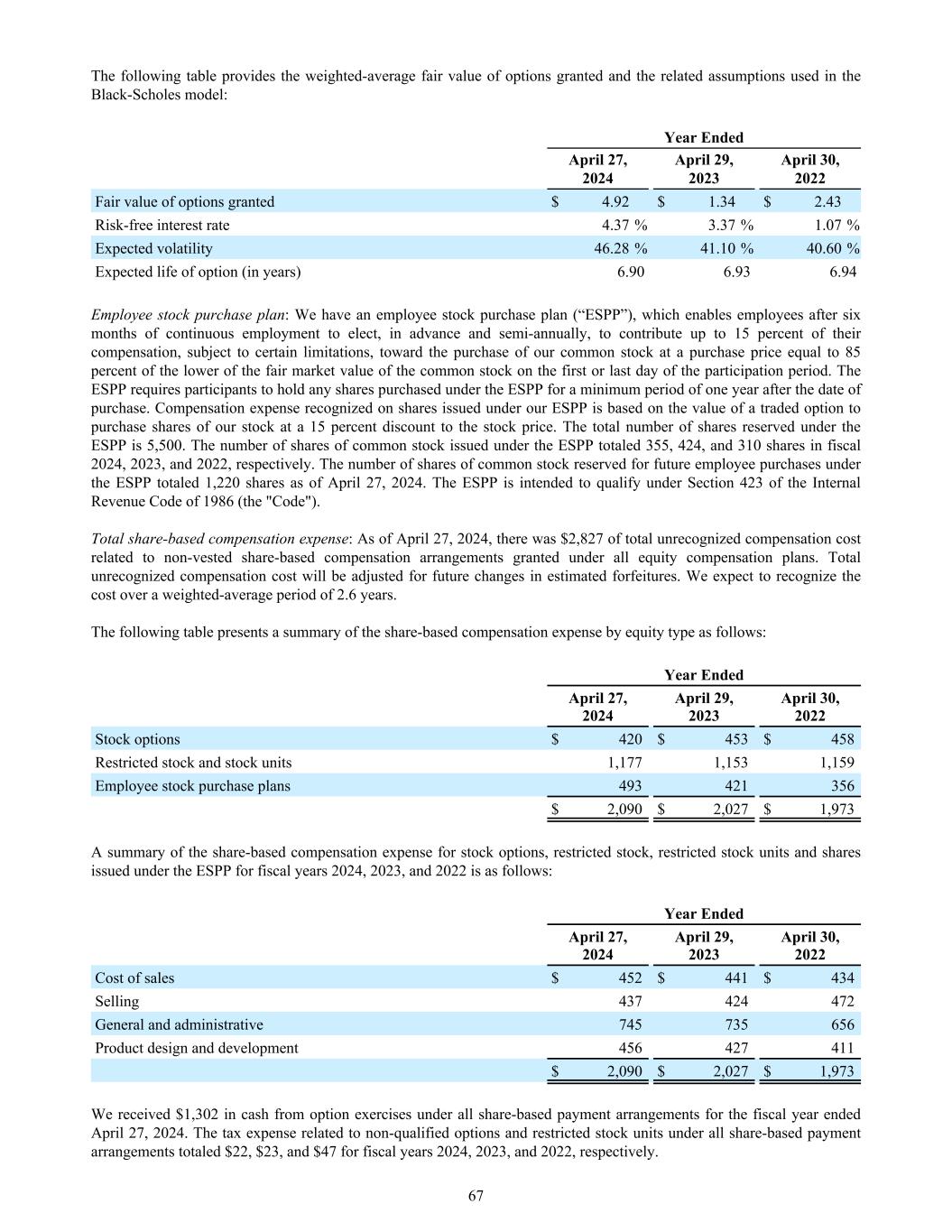
The following table provides the weighted-average fair value of options granted and the related assumptions used in the Black-Scholes model: Year Ended April 27, 2024 April 29, 2023 April 30, 2022 Fair value of options granted $ 4.92 $ 1.34 $ 2.43 Risk-free interest rate 4.37 % 3.37 % 1.07 % Expected volatility 46.28 % 41.10 % 40.60 % Expected life of option (in years) 6.90 6.93 6.94 Employee stock purchase plan: We have an employee stock purchase plan (“ESPP”), which enables employees after six months of continuous employment to elect, in advance and semi-annually, to contribute up to 15 percent of their compensation, subject to certain limitations, toward the purchase of our common stock at a purchase price equal to 85 percent of the lower of the fair market value of the common stock on the first or last day of the participation period. The ESPP requires participants to hold any shares purchased under the ESPP for a minimum period of one year after the date of purchase. Compensation expense recognized on shares issued under our ESPP is based on the value of a traded option to purchase shares of our stock at a 15 percent discount to the stock price. The total number of shares reserved under the ESPP is 5,500. The number of shares of common stock issued under the ESPP totaled 355, 424, and 310 shares in fiscal 2024, 2023, and 2022, respectively. The number of shares of common stock reserved for future employee purchases under the ESPP totaled 1,220 shares as of April 27, 2024. The ESPP is intended to qualify under Section 423 of the Internal Revenue Code of 1986 (the "Code"). Total share-based compensation expense: As of April 27, 2024, there was $2,827 of total unrecognized compensation cost related to non-vested share-based compensation arrangements granted under all equity compensation plans. Total unrecognized compensation cost will be adjusted for future changes in estimated forfeitures. We expect to recognize the cost over a weighted-average period of 2.6 years. The following table presents a summary of the share-based compensation expense by equity type as follows: Year Ended April 27, 2024 April 29, 2023 April 30, 2022 Stock options $ 420 $ 453 $ 458 Restricted stock and stock units 1,177 1,153 1,159 Employee stock purchase plans 493 421 356 $ 2,090 $ 2,027 $ 1,973 A summary of the share-based compensation expense for stock options, restricted stock, restricted stock units and shares issued under the ESPP for fiscal years 2024, 2023, and 2022 is as follows: Year Ended April 27, 2024 April 29, 2023 April 30, 2022 Cost of sales $ 452 $ 441 $ 434 Selling 437 424 472 General and administrative 745 735 656 Product design and development 456 427 411 $ 2,090 $ 2,027 $ 1,973 We received $1,302 in cash from option exercises under all share-based payment arrangements for the fiscal year ended April 27, 2024. The tax expense related to non-qualified options and restricted stock units under all share-based payment arrangements totaled $22, $23, and $47 for fiscal years 2024, 2023, and 2022, respectively. 67

Note 11. Retirement Benefits We sponsor a 401(k) savings plan providing benefits for substantially all United States-based employees of Daktronics, Inc. and its subsidiaries, subject to certain Internal Revenue Service ("IRS") limits. We made matching cash contributions equal to 50 percent of the employee's qualifying contribution up to six percent of such employee's compensation. Employees are eligible to participate in the 401(k) savings plan the first day of the calendar month following completion of 30 days of continuous service if they have attained the age of 21. We contributed $3,201, $2,969 and $2,573 for matches to the plan for fiscal years 2024, 2023, and 2022, respectively. Note 12. Income Taxes The following tables reflect the significant components of our income tax provision. The pretax income (loss) attributable to domestic and foreign operations was as follows: Year Ended April 27, 2024 April 29, 2023 April 30, 2022 Domestic $ 46,763 $ 10,125 $ (2,696) Foreign 7,288 3,132 3,804 Income before income taxes $ 54,051 $ 13,257 $ 1,108 Income tax expense (benefit) consisted of the following: Year Ended April 27, 2024 April 29, 2023 April 30, 2022 Current: Federal $ 21,174 $ 6,321 $ 644 State 5,512 1,381 452 Foreign 1,813 2,273 975 Deferred: Federal (8,101) (3,025) (1,020) State (1,045) (456) (476) Foreign 77 (39) (59) $ 19,430 $ 6,455 $ 516 68
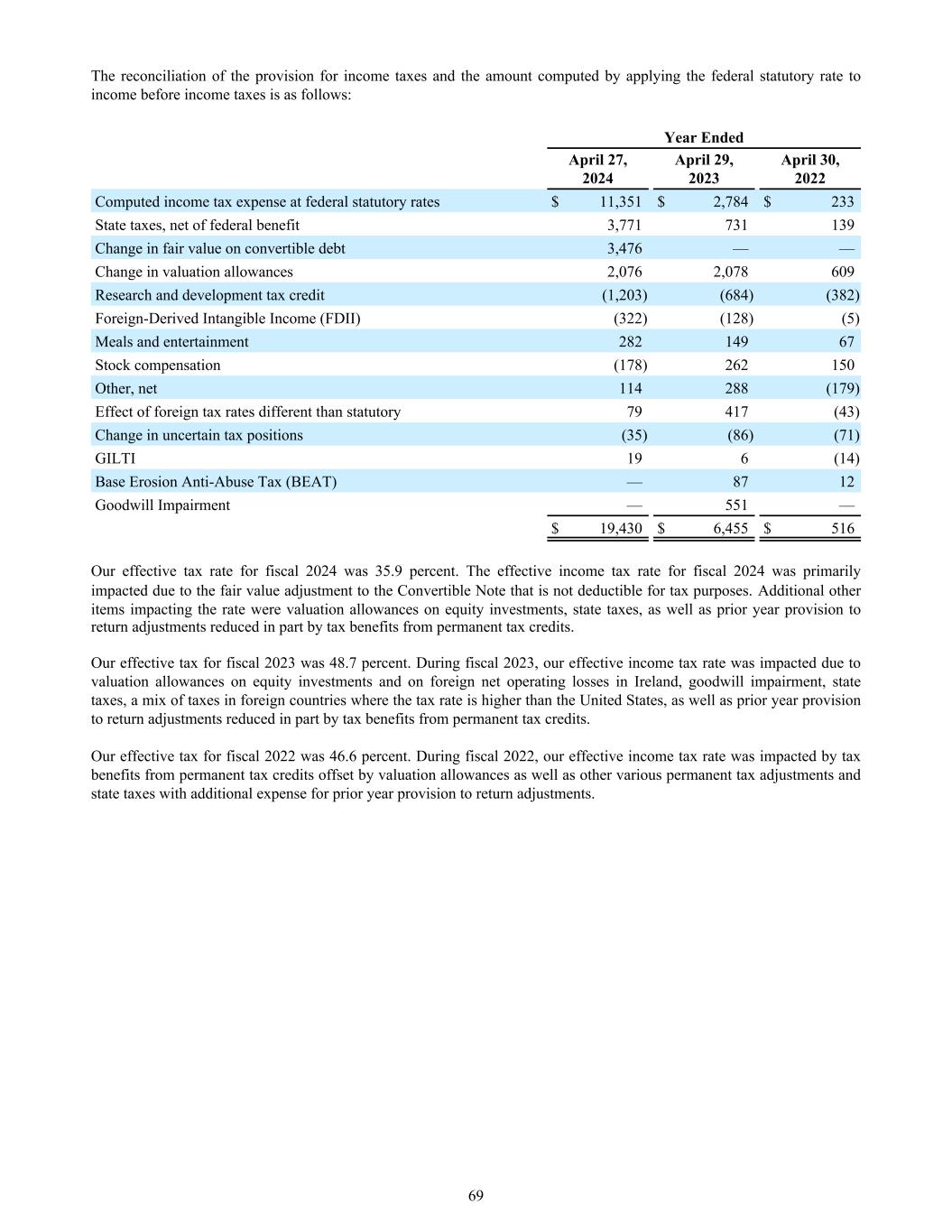
The reconciliation of the provision for income taxes and the amount computed by applying the federal statutory rate to income before income taxes is as follows: Year Ended April 27, 2024 April 29, 2023 April 30, 2022 Computed income tax expense at federal statutory rates $ 11,351 $ 2,784 $ 233 State taxes, net of federal benefit 3,771 731 139 Change in fair value on convertible debt 3,476 — — Change in valuation allowances 2,076 2,078 609 Research and development tax credit (1,203) (684) (382) Foreign-Derived Intangible Income (FDII) (322) (128) (5) Meals and entertainment 282 149 67 Stock compensation (178) 262 150 Other, net 114 288 (179) Effect of foreign tax rates different than statutory 79 417 (43) Change in uncertain tax positions (35) (86) (71) GILTI 19 6 (14) Base Erosion Anti-Abuse Tax (BEAT) — 87 12 Goodwill Impairment — 551 — $ 19,430 $ 6,455 $ 516 Our effective tax rate for fiscal 2024 was 35.9 percent. The effective income tax rate for fiscal 2024 was primarily impacted due to the fair value adjustment to the Convertible Note that is not deductible for tax purposes. Additional other items impacting the rate were valuation allowances on equity investments, state taxes, as well as prior year provision to return adjustments reduced in part by tax benefits from permanent tax credits. Our effective tax for fiscal 2023 was 48.7 percent. During fiscal 2023, our effective income tax rate was impacted due to valuation allowances on equity investments and on foreign net operating losses in Ireland, goodwill impairment, state taxes, a mix of taxes in foreign countries where the tax rate is higher than the United States, as well as prior year provision to return adjustments reduced in part by tax benefits from permanent tax credits. Our effective tax for fiscal 2022 was 46.6 percent. During fiscal 2022, our effective income tax rate was impacted by tax benefits from permanent tax credits offset by valuation allowances as well as other various permanent tax adjustments and state taxes with additional expense for prior year provision to return adjustments. 69
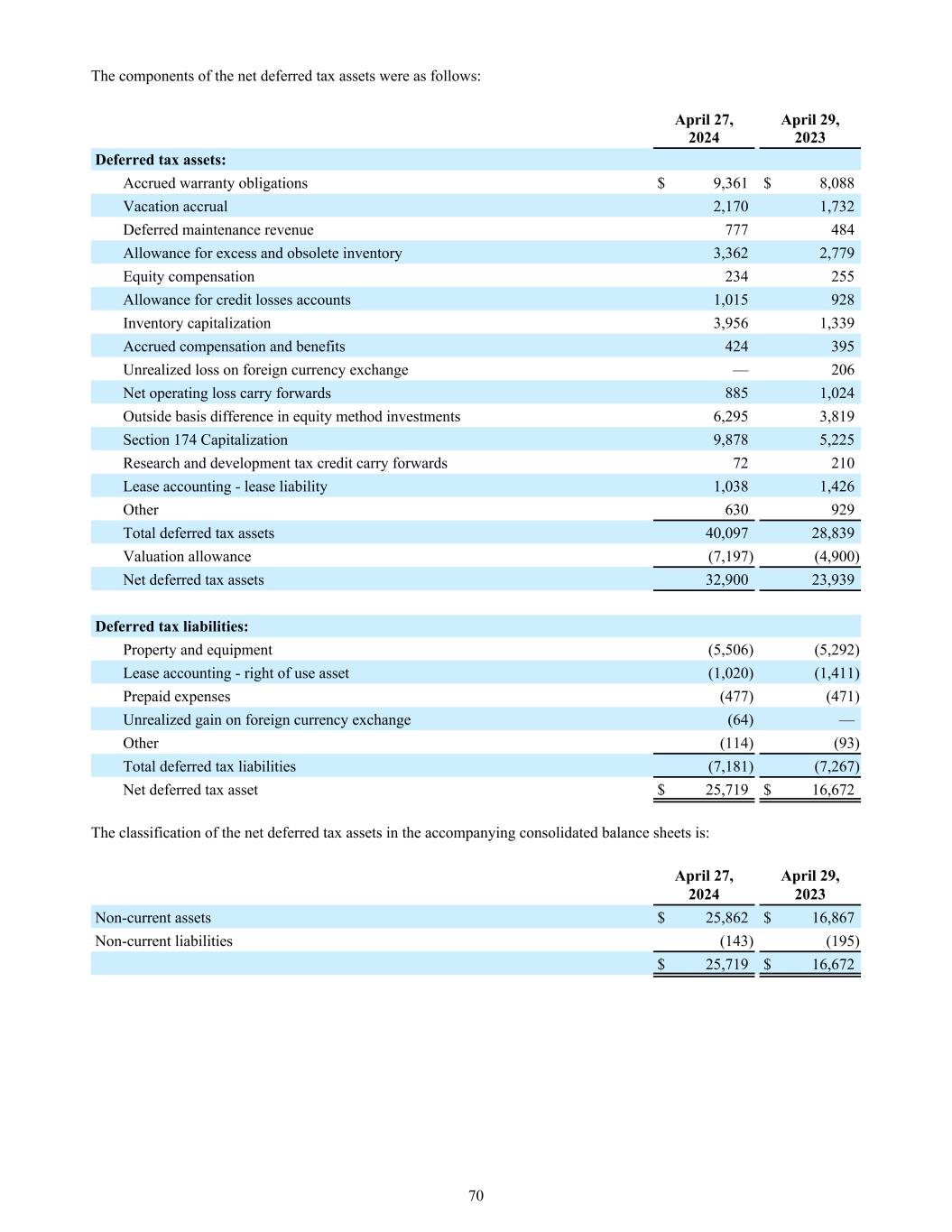
The components of the net deferred tax assets were as follows: April 27, 2024 April 29, 2023 Deferred tax assets: Accrued warranty obligations $ 9,361 $ 8,088 Vacation accrual 2,170 1,732 Deferred maintenance revenue 777 484 Allowance for excess and obsolete inventory 3,362 2,779 Equity compensation 234 255 Allowance for credit losses accounts 1,015 928 Inventory capitalization 3,956 1,339 Accrued compensation and benefits 424 395 Unrealized loss on foreign currency exchange — 206 Net operating loss carry forwards 885 1,024 Outside basis difference in equity method investments 6,295 3,819 Section 174 Capitalization 9,878 5,225 Research and development tax credit carry forwards 72 210 Lease accounting - lease liability 1,038 1,426 Other 630 929 Total deferred tax assets 40,097 28,839 Valuation allowance (7,197) (4,900) Net deferred tax assets 32,900 23,939 Deferred tax liabilities: Property and equipment (5,506) (5,292) Lease accounting - right of use asset (1,020) (1,411) Prepaid expenses (477) (471) Unrealized gain on foreign currency exchange (64) — Other (114) (93) Total deferred tax liabilities (7,181) (7,267) Net deferred tax asset $ 25,719 $ 16,672 The classification of the net deferred tax assets in the accompanying consolidated balance sheets is: April 27, 2024 April 29, 2023 Non-current assets $ 25,862 $ 16,867 Non-current liabilities (143) (195) $ 25,719 $ 16,672 70

The summary of changes in the amounts related to unrecognized uncertain tax benefits are: April 27, 2024 April 29, 2023 Balance at beginning of year $ 392 $ 477 Gross increases related to prior period tax positions 15 12 Gross decreases related to prior period tax positions (3) (56) Gross increases related to current period tax positions 123 124 Lapse of statute of limitations (171) (165) Balance at end of year $ 356 $ 392 All of our unrecognized tax benefits would have an impact on the effective tax rate if recognized. It is reasonably possible that the amount of unrecognized tax benefits could change due to one or more of the following events occurring in the next 12 months: expiring statutes, audit activity, tax payments, or competent authority proceedings. A statute of limitations relating to $34 of the unrecognized tax benefits (including interest) expires in the next 12 months. The benefit will be recognized if the statute lapses with no further action taken by regulators. Additionally, we recognized the release of $171 in unrecognized tax benefits related to the lapse of a statute of limitations in fiscal 2024. Interest and penalties incurred associated with uncertain tax positions are included in the "Income tax expense" line item in our consolidated statements of operations. Accrued interest and penalties are included in the related tax liability line item in our consolidated balance sheets of $21 and $28 as of April 27, 2024 and April 29, 2023, respectively. As of April 27, 2024, we had total valuation allowances against deferred tax assets of $7,197, as compared to $4,900 as of April 29, 2023, representing an increase of $2,297 during fiscal 2024. The increase in valuation allowance as well as the majority of the total balance is related to the outside basis difference and impairments in equity method investments. A small portion of the total valuation allowances are related to foreign net operating loss carryfowards as detailed below. We consider all positive and negative evidence available in determining the potential of realizing deferred tax assets including its past operating results and the forecast of future earnings, category of income, future taxable income, and prudent and feasible tax planning strategies. If sufficient evidence of our ability to generate applicable taxable income in the jurisdictions in which we currently maintain a valuation allowance causes us to determine that our deferred tax assets are more likely than not realizable, we would release our valuation allowance, which would result in an income tax benefit being recorded in our consolidated statements of operations. As of April 27, 2024, we had foreign net operating loss (“NOL”) carryforwards of approximately $5,136 primarily related to our operations in Belgium and Ireland, which have indefinite lives. A deferred tax asset has been recorded for all NOL carryforwards totaling approximately $883. However, due to uncertainty in future taxable income, a valuation allowance has been recorded for the full amount of the asset. Additional tax information: We are subject to United States federal income tax as well as income taxes of multiple state and foreign jurisdictions. Fiscal years 2021, 2022 and 2023 remain open to federal tax examinations, and fiscal years 2020, 2021, 2022 and 2023 remain open for state income tax examinations. Certain subsidiaries are also subject to income tax in several foreign jurisdictions which have open tax years varying by jurisdiction beginning in fiscal 2013. In the event of any future tax assessments, we have elected to record the income taxes and any related interest and penalties as income tax expense in our consolidated statements of operations. As of April 27, 2024, we had no deferred tax liability recognized relating to our investment in foreign subsidiaries where the earnings have been indefinitely reinvested. The Tax Act of 2017 generally eliminates United States federal income taxes on dividends from foreign subsidiaries, and, as a result, the accumulated undistributed earnings would be subject only to other taxes, such as withholding taxes and state income taxes, on the distribution of such earnings. No additional withholding or income taxes have been provided for any remaining undistributed foreign earnings not subject to the one- time deemed repatriation tax, as it is our intention for these amounts to continue to be indefinitely reinvested in foreign operations in all of our non-United States jurisdictions. 71
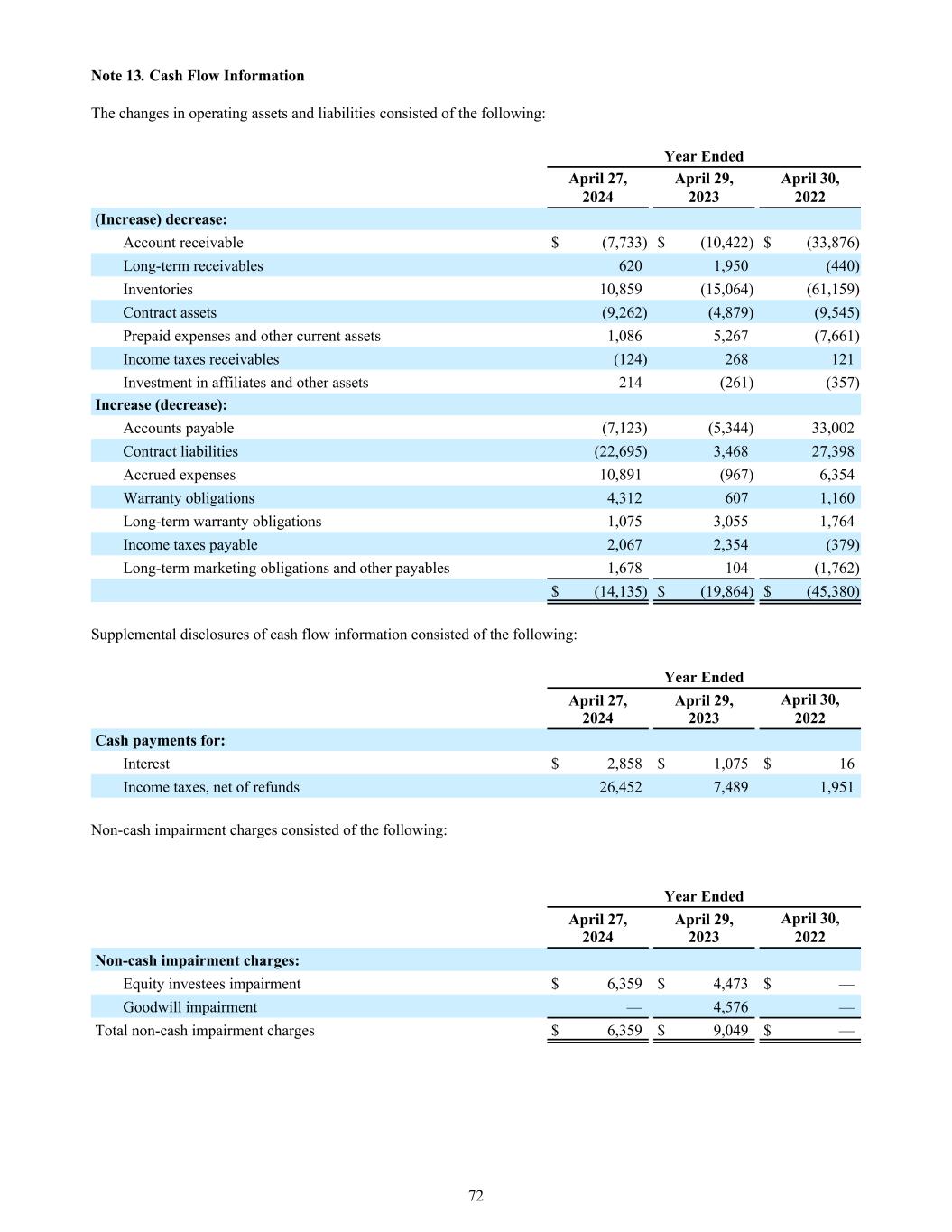
Note 13. Cash Flow Information The changes in operating assets and liabilities consisted of the following: Year Ended April 27, 2024 April 29, 2023 April 30, 2022 (Increase) decrease: Account receivable $ (7,733) $ (10,422) $ (33,876) Long-term receivables 620 1,950 (440) Inventories 10,859 (15,064) (61,159) Contract assets (9,262) (4,879) (9,545) Prepaid expenses and other current assets 1,086 5,267 (7,661) Income taxes receivables (124) 268 121 Investment in affiliates and other assets 214 (261) (357) Increase (decrease): Accounts payable (7,123) (5,344) 33,002 Contract liabilities (22,695) 3,468 27,398 Accrued expenses 10,891 (967) 6,354 Warranty obligations 4,312 607 1,160 Long-term warranty obligations 1,075 3,055 1,764 Income taxes payable 2,067 2,354 (379) Long-term marketing obligations and other payables 1,678 104 (1,762) $ (14,135) $ (19,864) $ (45,380) Supplemental disclosures of cash flow information consisted of the following: Year Ended April 27, 2024 April 29, 2023 April 30, 2022 Cash payments for: Interest $ 2,858 $ 1,075 $ 16 Income taxes, net of refunds 26,452 7,489 1,951 Non-cash impairment charges consisted of the following: Year Ended April 27, 2024 April 29, 2023 April 30, 2022 Non-cash impairment charges: Equity investees impairment $ 6,359 $ 4,473 $ — Goodwill impairment — 4,576 — Total non-cash impairment charges $ 6,359 $ 9,049 $ — 72

Supplemental schedule of non-cash investing and financing activities consisted of the following: Year Ended April 27, 2024 April 29, 2023 April 30, 2022 Demonstration equipment transferred to inventory $ — $ — $ 53 Purchases of property and equipment included in accounts payable 1,628 1,057 4,177 Contributions of common stock under the ESPP 1,200 1,207 1,211 Debt issuance costs — 2,875 — Note 14. Fair Value Measurement ASC 820, Fair Value Measurement, defines fair value as the price that would be received to sell an asset or paid to transfer a liability (an exit price) in an orderly transaction between market participants at the measurement date. It also establishes a fair value hierarchy which requires an entity to maximize the use of observable inputs and minimize the use of unobservable inputs when measuring fair value. The fair value hierarchy within ASC 820 distinguishes between the following three levels of inputs which may be utilized when measuring fair value: Level 1 - Quoted prices in active markets for identical assets or liabilities. Level 2 - Observable inputs other than quoted prices included within level 1 for the assets or liabilities, either directly or indirectly (for example, quoted market prices for similar assets and liabilities in active markets or quoted market prices for identical assets or liabilities in markets not considered to be active, inputs other than quoted prices that are observable for the asset or liability, or market-corroborated input). Level 3 - Unobservable inputs supported by little or no market activity based on our own assumptions used to measure assets and liabilities. The fair values for fixed-rate long-term receivables are estimated using a discounted cash flow analysis based on interest rates currently being offered for contracts with similar terms to customers with similar credit quality. The carrying amounts reported in our consolidated balance sheets for long-term receivables approximate fair value and have been categorized as a level 2 fair value measurement. Fair values for fixed-rate long-term marketing obligations are estimated using a discounted cash flow calculation applying interest rates currently being offered for debt with similar terms and underlying collateral. The total carrying value of long- term marketing obligations as reported in our consolidated balance sheets within other long-term obligations approximates fair value and has been categorized as a level 2 fair value measurement. The following table sets forth by level within the fair value hierarchy our financial assets and liabilities that were accounted for at fair value on a recurring basis as of April 27, 2024 and April 29, 2023 according to the valuation techniques we used to determine their fair values. There have been no transfers of assets or liabilities among the fair value hierarchies presented. 73
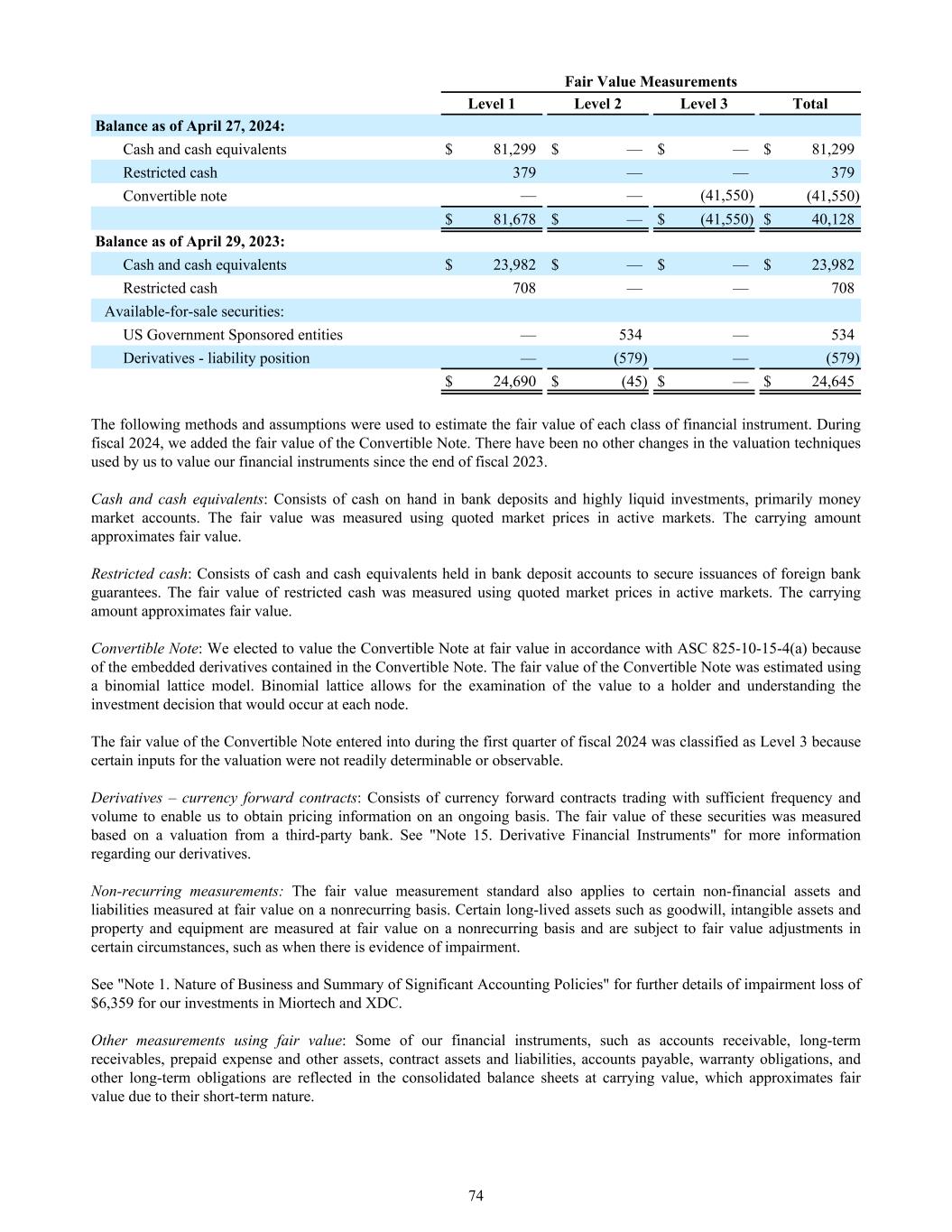
Fair Value Measurements Level 1 Level 2 Level 3 Total Balance as of April 27, 2024: Cash and cash equivalents $ 81,299 $ — $ — $ 81,299 Restricted cash 379 — — 379 Convertible note — — (41,550) (41,550) $ 81,678 $ — $ (41,550) $ 40,128 Balance as of April 29, 2023: Cash and cash equivalents $ 23,982 $ — $ — $ 23,982 Restricted cash 708 — — 708 Available-for-sale securities: US Government Sponsored entities — 534 — 534 Derivatives - liability position — (579) — (579) $ 24,690 $ (45) $ — $ 24,645 The following methods and assumptions were used to estimate the fair value of each class of financial instrument. During fiscal 2024, we added the fair value of the Convertible Note. There have been no other changes in the valuation techniques used by us to value our financial instruments since the end of fiscal 2023. Cash and cash equivalents: Consists of cash on hand in bank deposits and highly liquid investments, primarily money market accounts. The fair value was measured using quoted market prices in active markets. The carrying amount approximates fair value. Restricted cash: Consists of cash and cash equivalents held in bank deposit accounts to secure issuances of foreign bank guarantees. The fair value of restricted cash was measured using quoted market prices in active markets. The carrying amount approximates fair value. Convertible Note: We elected to value the Convertible Note at fair value in accordance with ASC 825-10-15-4(a) because of the embedded derivatives contained in the Convertible Note. The fair value of the Convertible Note was estimated using a binomial lattice model. Binomial lattice allows for the examination of the value to a holder and understanding the investment decision that would occur at each node. The fair value of the Convertible Note entered into during the first quarter of fiscal 2024 was classified as Level 3 because certain inputs for the valuation were not readily determinable or observable. Derivatives – currency forward contracts: Consists of currency forward contracts trading with sufficient frequency and volume to enable us to obtain pricing information on an ongoing basis. The fair value of these securities was measured based on a valuation from a third-party bank. See "Note 15. Derivative Financial Instruments" for more information regarding our derivatives. Non-recurring measurements: The fair value measurement standard also applies to certain non-financial assets and liabilities measured at fair value on a nonrecurring basis. Certain long-lived assets such as goodwill, intangible assets and property and equipment are measured at fair value on a nonrecurring basis and are subject to fair value adjustments in certain circumstances, such as when there is evidence of impairment. See "Note 1. Nature of Business and Summary of Significant Accounting Policies" for further details of impairment loss of $6,359 for our investments in Miortech and XDC. Other measurements using fair value: Some of our financial instruments, such as accounts receivable, long-term receivables, prepaid expense and other assets, contract assets and liabilities, accounts payable, warranty obligations, and other long-term obligations are reflected in the consolidated balance sheets at carrying value, which approximates fair value due to their short-term nature. 74

Note 15. Derivative Financial Instruments We utilize derivative financial instruments to manage the economic impact of fluctuations in currency exchange rates on those transactions denominated in currencies other than our functional currency, which is the United States dollar. We enter into currency forward contracts to manage these economic risks. We account for all derivatives in the consolidated balance sheets within accounts receivable or accounts payable measured at fair value, and changes in fair values are recognized in earnings unless specific hedge accounting criteria are met for cash flow or net investment hedges. As of April 27, 2024 and April 29, 2023, we had not designated any of our derivative instruments as accounting hedges, and thus we recorded the changes in fair value in the "Other expense and debt issuance costs write-off, net" line item in the consolidated statements of operations. There were no foreign currency agreements outstanding as of April 27, 2024. The foreign currency exchange contracts in aggregated notional amounts in place to exchange United States dollars as of April 29, 2023 were as follows: April 27, 2024 April 29, 2023 United States Dollars Foreign Currency United States Dollars Foreign Currency Foreign Currency Exchange Forward Contracts: United States Dollars/Euros — — 7,758 7,513 As of April 27, 2024, there was an no asset or liability, and, as of April 29, 2023, there was an asset and liability of $0 and $579, respectively, representing the fair value of foreign currency exchange forward contracts, which were determined using level 2 inputs from a third-party bank. Note 16. Commitments and Contingencies Litigation: We are a party to legal proceedings and claims which arise during the ordinary course of business. We review our legal proceedings and claims, regulatory reviews and inspections, and other legal matters on an ongoing basis and follow appropriate accounting guidance when making accrual and disclosure decisions. We establish accruals for those contingencies when the incurrence of a loss is probable and can be reasonably estimated, and we disclose the amount accrued and the amount of a reasonably possible loss in excess of the amount accrued if such disclosure is necessary for our financial statements to not be misleading. We do not record an accrual when the likelihood of loss being incurred is probable, but the amount cannot be reasonably estimated, or when the loss is believed to be only reasonably possible or remote, although disclosures will be made for material matters as required by ASC 450-20, Contingencies - Loss Contingencies. Our assessment of whether a loss is reasonably possible or probable is based on our assessment and consultation with legal counsel regarding the ultimate outcome of the matter following all appeals. For other unresolved legal proceedings or claims, we do not believe there is a reasonable probability that any material loss would be incurred. Accordingly, no material accrual or disclosure of a potential range of loss has been made related to these matters. We do not expect the ultimate liability of these unresolved legal proceedings or claims to have a material effect on our financial position, liquidity or capital resources. Warranties: See "Note 1. Nature of Business and Summary of Significant Accounting Policies" for more information regarding warranties. Changes in our warranty obligation for the fiscal years ended April 27, 2024 and April 29, 2023 consisted of the following: April 27, 2024 April 29, 2023 Beginning accrued warranty obligations $ 32,541 $ 28,878 Warranties issued during the period 14,422 13,429 Settlements made during the period (12,600) (11,044) Changes in accrued warranty obligations for pre-existing warranties during the period, including expirations 3,565 1,278 Ending accrued warranty obligations $ 37,928 $ 32,541 75
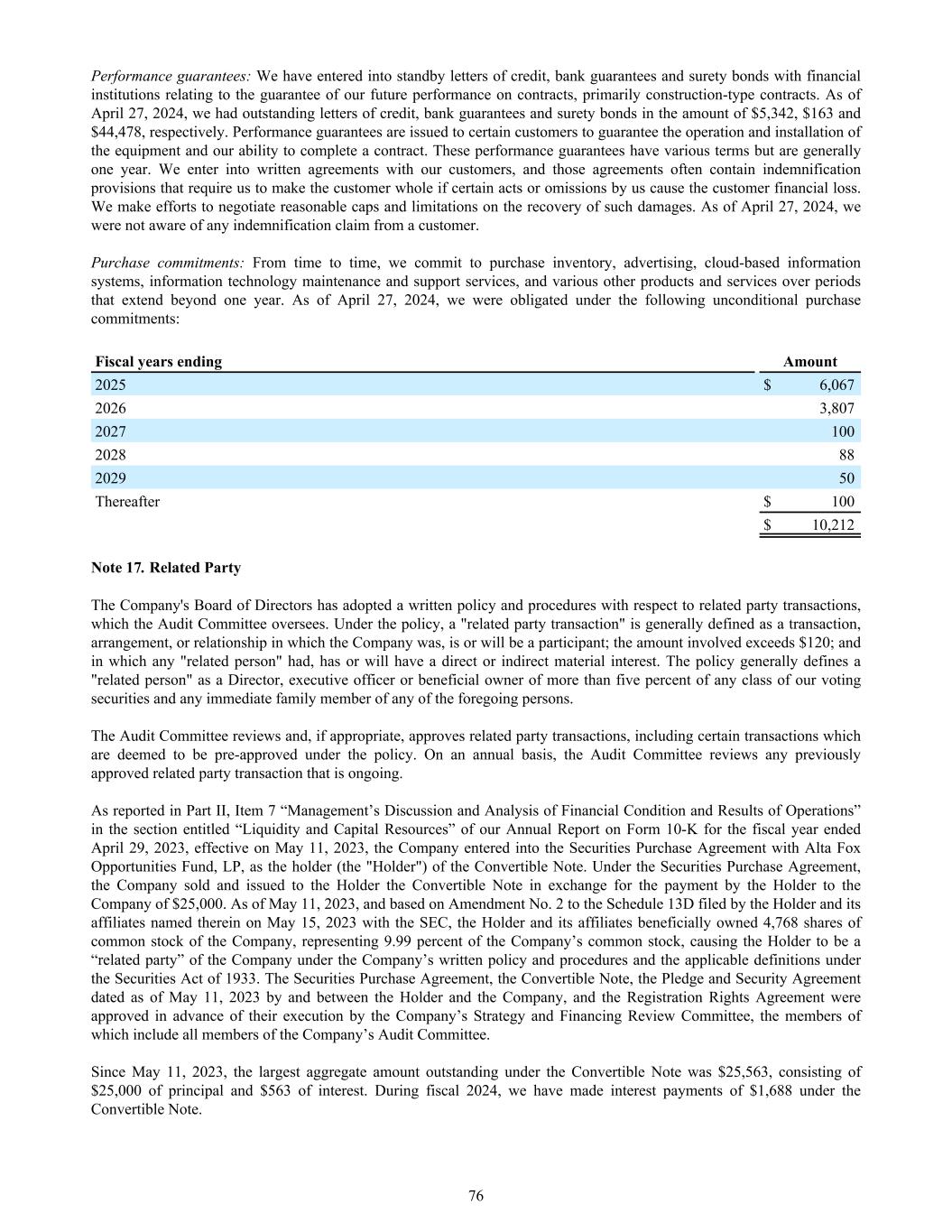
Performance guarantees: We have entered into standby letters of credit, bank guarantees and surety bonds with financial institutions relating to the guarantee of our future performance on contracts, primarily construction-type contracts. As of April 27, 2024, we had outstanding letters of credit, bank guarantees and surety bonds in the amount of $5,342, $163 and $44,478, respectively. Performance guarantees are issued to certain customers to guarantee the operation and installation of the equipment and our ability to complete a contract. These performance guarantees have various terms but are generally one year. We enter into written agreements with our customers, and those agreements often contain indemnification provisions that require us to make the customer whole if certain acts or omissions by us cause the customer financial loss. We make efforts to negotiate reasonable caps and limitations on the recovery of such damages. As of April 27, 2024, we were not aware of any indemnification claim from a customer. Purchase commitments: From time to time, we commit to purchase inventory, advertising, cloud-based information systems, information technology maintenance and support services, and various other products and services over periods that extend beyond one year. As of April 27, 2024, we were obligated under the following unconditional purchase commitments: Fiscal years ending Amount 2025 $ 6,067 2026 3,807 2027 100 2028 88 2029 50 Thereafter $ 100 $ 10,212 Note 17. Related Party The Company's Board of Directors has adopted a written policy and procedures with respect to related party transactions, which the Audit Committee oversees. Under the policy, a "related party transaction" is generally defined as a transaction, arrangement, or relationship in which the Company was, is or will be a participant; the amount involved exceeds $120; and in which any "related person" had, has or will have a direct or indirect material interest. The policy generally defines a "related person" as a Director, executive officer or beneficial owner of more than five percent of any class of our voting securities and any immediate family member of any of the foregoing persons. The Audit Committee reviews and, if appropriate, approves related party transactions, including certain transactions which are deemed to be pre-approved under the policy. On an annual basis, the Audit Committee reviews any previously approved related party transaction that is ongoing. As reported in Part II, Item 7 “Management’s Discussion and Analysis of Financial Condition and Results of Operations” in the section entitled “Liquidity and Capital Resources” of our Annual Report on Form 10-K for the fiscal year ended April 29, 2023, effective on May 11, 2023, the Company entered into the Securities Purchase Agreement with Alta Fox Opportunities Fund, LP, as the holder (the "Holder") of the Convertible Note. Under the Securities Purchase Agreement, the Company sold and issued to the Holder the Convertible Note in exchange for the payment by the Holder to the Company of $25,000. As of May 11, 2023, and based on Amendment No. 2 to the Schedule 13D filed by the Holder and its affiliates named therein on May 15, 2023 with the SEC, the Holder and its affiliates beneficially owned 4,768 shares of common stock of the Company, representing 9.99 percent of the Company’s common stock, causing the Holder to be a “related party” of the Company under the Company’s written policy and procedures and the applicable definitions under the Securities Act of 1933. The Securities Purchase Agreement, the Convertible Note, the Pledge and Security Agreement dated as of May 11, 2023 by and between the Holder and the Company, and the Registration Rights Agreement were approved in advance of their execution by the Company’s Strategy and Financing Review Committee, the members of which include all members of the Company’s Audit Committee. Since May 11, 2023, the largest aggregate amount outstanding under the Convertible Note was $25,563, consisting of $25,000 of principal and $563 of interest. During fiscal 2024, we have made interest payments of $1,688 under the Convertible Note. 76
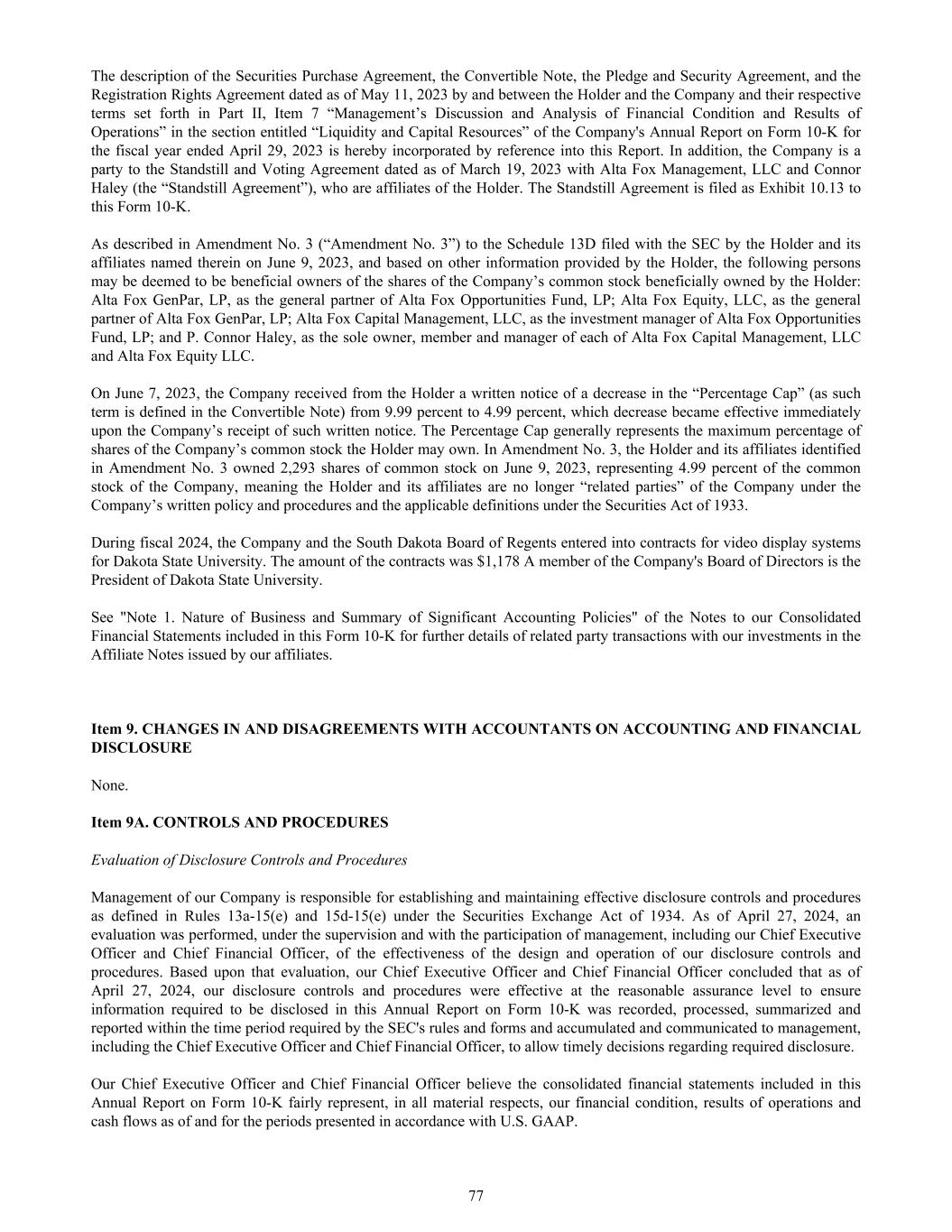
The description of the Securities Purchase Agreement, the Convertible Note, the Pledge and Security Agreement, and the Registration Rights Agreement dated as of May 11, 2023 by and between the Holder and the Company and their respective terms set forth in Part II, Item 7 “Management’s Discussion and Analysis of Financial Condition and Results of Operations” in the section entitled “Liquidity and Capital Resources” of the Company's Annual Report on Form 10-K for the fiscal year ended April 29, 2023 is hereby incorporated by reference into this Report. In addition, the Company is a party to the Standstill and Voting Agreement dated as of March 19, 2023 with Alta Fox Management, LLC and Connor Haley (the “Standstill Agreement”), who are affiliates of the Holder. The Standstill Agreement is filed as Exhibit 10.13 to this Form 10-K. As described in Amendment No. 3 (“Amendment No. 3”) to the Schedule 13D filed with the SEC by the Holder and its affiliates named therein on June 9, 2023, and based on other information provided by the Holder, the following persons may be deemed to be beneficial owners of the shares of the Company’s common stock beneficially owned by the Holder: Alta Fox GenPar, LP, as the general partner of Alta Fox Opportunities Fund, LP; Alta Fox Equity, LLC, as the general partner of Alta Fox GenPar, LP; Alta Fox Capital Management, LLC, as the investment manager of Alta Fox Opportunities Fund, LP; and P. Connor Haley, as the sole owner, member and manager of each of Alta Fox Capital Management, LLC and Alta Fox Equity LLC. On June 7, 2023, the Company received from the Holder a written notice of a decrease in the “Percentage Cap” (as such term is defined in the Convertible Note) from 9.99 percent to 4.99 percent, which decrease became effective immediately upon the Company’s receipt of such written notice. The Percentage Cap generally represents the maximum percentage of shares of the Company’s common stock the Holder may own. In Amendment No. 3, the Holder and its affiliates identified in Amendment No. 3 owned 2,293 shares of common stock on June 9, 2023, representing 4.99 percent of the common stock of the Company, meaning the Holder and its affiliates are no longer “related parties” of the Company under the Company’s written policy and procedures and the applicable definitions under the Securities Act of 1933. During fiscal 2024, the Company and the South Dakota Board of Regents entered into contracts for video display systems for Dakota State University. The amount of the contracts was $1,178 A member of the Company's Board of Directors is the President of Dakota State University. See "Note 1. Nature of Business and Summary of Significant Accounting Policies" of the Notes to our Consolidated Financial Statements included in this Form 10-K for further details of related party transactions with our investments in the Affiliate Notes issued by our affiliates. Item 9. CHANGES IN AND DISAGREEMENTS WITH ACCOUNTANTS ON ACCOUNTING AND FINANCIAL DISCLOSURE None. Item 9A. CONTROLS AND PROCEDURES Evaluation of Disclosure Controls and Procedures Management of our Company is responsible for establishing and maintaining effective disclosure controls and procedures as defined in Rules 13a-15(e) and 15d-15(e) under the Securities Exchange Act of 1934. As of April 27, 2024, an evaluation was performed, under the supervision and with the participation of management, including our Chief Executive Officer and Chief Financial Officer, of the effectiveness of the design and operation of our disclosure controls and procedures. Based upon that evaluation, our Chief Executive Officer and Chief Financial Officer concluded that as of April 27, 2024, our disclosure controls and procedures were effective at the reasonable assurance level to ensure information required to be disclosed in this Annual Report on Form 10-K was recorded, processed, summarized and reported within the time period required by the SEC's rules and forms and accumulated and communicated to management, including the Chief Executive Officer and Chief Financial Officer, to allow timely decisions regarding required disclosure. Our Chief Executive Officer and Chief Financial Officer believe the consolidated financial statements included in this Annual Report on Form 10-K fairly represent, in all material respects, our financial condition, results of operations and cash flows as of and for the periods presented in accordance with U.S. GAAP. 77

Prior Year Material Weakness in Internal Control over Financial Reporting As previously reported in our Annual Report on Form 10-K for the fiscal year ended April 29, 2023, a material weakness in our internal control over financial reporting was reported relating to the ineffective operation of certain transactional level controls related to revenue contracts recognized over time. These controls operated ineffectively due to insufficient training of the control operators as to the level of precision expected when executing the revenue controls in accordance with the Company's policy. The Company has made the following enhancements to internal controls to address the material weakness: 1. Enhanced the policy and process over the extent of review procedures to be performed, the related documentation, and the level of precision used by the control operator. 2. Provided training to the control operators relating to the level of precision, evidence, and documentation expected when executing the revenue controls in accordance with the Company's policy. Management has determined, through its testing, that the Company's internal controls related to revenue contracts recognized over time were designed and operated effectively for a sufficient period of time during fiscal 2024 to conclude that the previously identified material weakness has been remediated as of April 27, 2024. Management’s Report on Internal Control Over Financial Reporting Our management is responsible for establishing and maintaining adequate internal control over financial reporting, as such term is defined in Rules 13a-15(f) and 15d-15(f) under the Securities Exchange Act of 1934. Our system of internal control was designed to provide reasonable assurance regarding the reliability of financial reporting and the preparation of our financial statements for external purposes in accordance with accounting principles generally accepted in the United States. Under the supervision and with the participation of our management, including our Chief Executive Officer and Chief Financial Officer, we conducted an evaluation of the effectiveness of our internal control over financial reporting based on the criteria in Internal Control—Integrated Framework issued by the Committee of Sponsoring Organizations of the Treadway Commission (2013 Framework). Based on our evaluation under the criteria in the 2013 Framework, our management concluded our internal control over financial reporting was effective as of April 27, 2024. The effectiveness of our internal control over financial reporting as of April 27, 2024 has been audited by Deloitte & Touche, LLP, our independent registered public accounting firm, as stated in their report, which is included in this Annual Report on Form 10-K. Changes in Internal Control Over Financial Reporting Except for the remediation of the material weakness noted above, during the quarter ended April 27, 2024, there have been no changes in our internal control over financial reporting that have materially affected, or are reasonably likely to materially affect, our internal control over financial reporting. By /s/ Reece A. Kurtenbach By /s/ Sheila M. Anderson Reece A. Kurtenbach Sheila M. Anderson Chief Executive Officer Chief Financial Officer June 26, 2024 June 26, 2024 REPORT OF INDEPENDENT REGISTERED PUBLIC ACCOUNTING FIRM To the shareholders and the Board of Directors of Daktronics, Inc. Opinion on Internal Control Over Financial Reporting We have audited the internal control over financial reporting of Daktronics, Inc. and subsidiaries (the “Company”) as of April 27, 2024, based on criteria established in Internal Control — Integrated Framework (2013) issued by the Committee 78
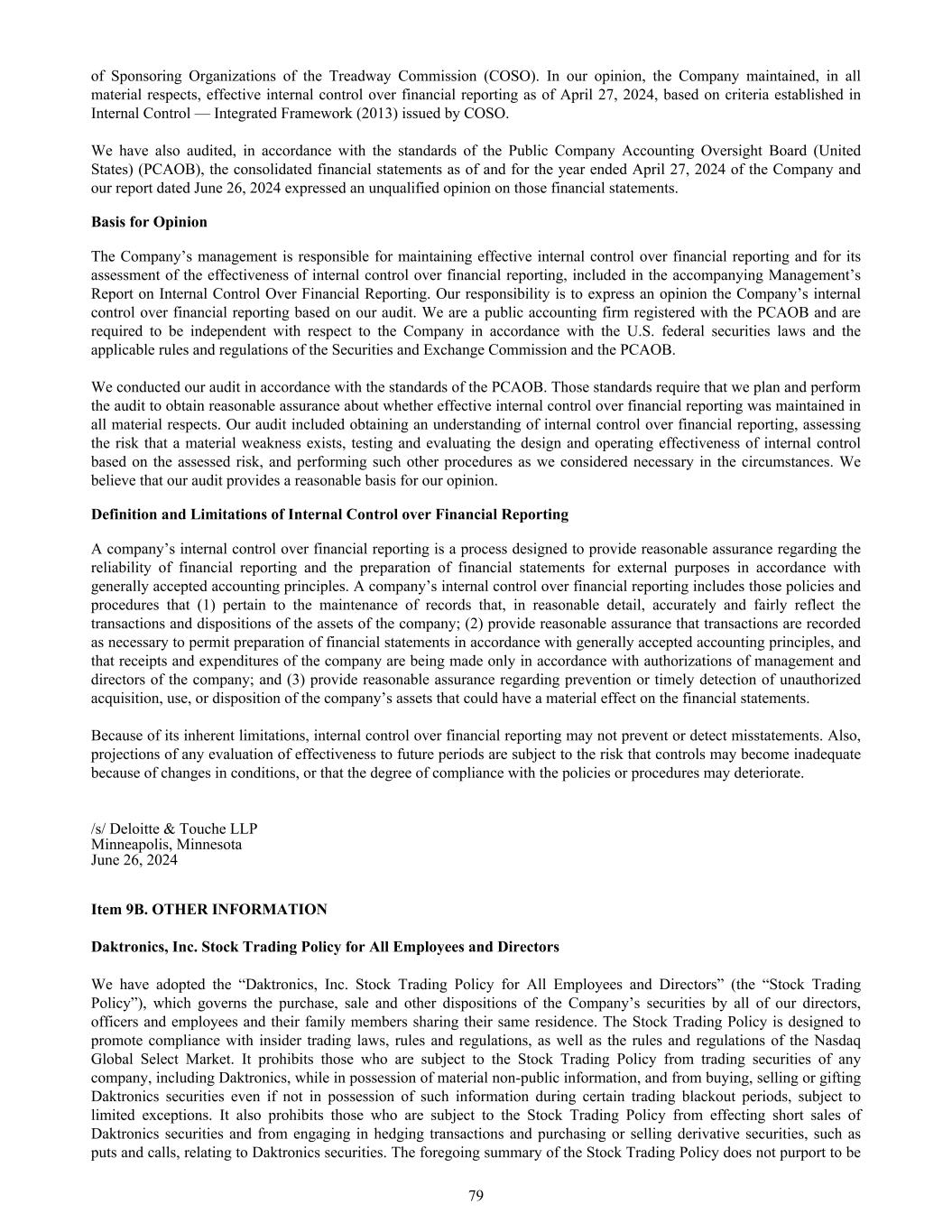
of Sponsoring Organizations of the Treadway Commission (COSO). In our opinion, the Company maintained, in all material respects, effective internal control over financial reporting as of April 27, 2024, based on criteria established in Internal Control — Integrated Framework (2013) issued by COSO. We have also audited, in accordance with the standards of the Public Company Accounting Oversight Board (United States) (PCAOB), the consolidated financial statements as of and for the year ended April 27, 2024 of the Company and our report dated June 26, 2024 expressed an unqualified opinion on those financial statements. Basis for Opinion The Company’s management is responsible for maintaining effective internal control over financial reporting and for its assessment of the effectiveness of internal control over financial reporting, included in the accompanying Management’s Report on Internal Control Over Financial Reporting. Our responsibility is to express an opinion the Company’s internal control over financial reporting based on our audit. We are a public accounting firm registered with the PCAOB and are required to be independent with respect to the Company in accordance with the U.S. federal securities laws and the applicable rules and regulations of the Securities and Exchange Commission and the PCAOB. We conducted our audit in accordance with the standards of the PCAOB. Those standards require that we plan and perform the audit to obtain reasonable assurance about whether effective internal control over financial reporting was maintained in all material respects. Our audit included obtaining an understanding of internal control over financial reporting, assessing the risk that a material weakness exists, testing and evaluating the design and operating effectiveness of internal control based on the assessed risk, and performing such other procedures as we considered necessary in the circumstances. We believe that our audit provides a reasonable basis for our opinion. Definition and Limitations of Internal Control over Financial Reporting A company’s internal control over financial reporting is a process designed to provide reasonable assurance regarding the reliability of financial reporting and the preparation of financial statements for external purposes in accordance with generally accepted accounting principles. A company’s internal control over financial reporting includes those policies and procedures that (1) pertain to the maintenance of records that, in reasonable detail, accurately and fairly reflect the transactions and dispositions of the assets of the company; (2) provide reasonable assurance that transactions are recorded as necessary to permit preparation of financial statements in accordance with generally accepted accounting principles, and that receipts and expenditures of the company are being made only in accordance with authorizations of management and directors of the company; and (3) provide reasonable assurance regarding prevention or timely detection of unauthorized acquisition, use, or disposition of the company’s assets that could have a material effect on the financial statements. Because of its inherent limitations, internal control over financial reporting may not prevent or detect misstatements. Also, projections of any evaluation of effectiveness to future periods are subject to the risk that controls may become inadequate because of changes in conditions, or that the degree of compliance with the policies or procedures may deteriorate. /s/ Deloitte & Touche LLP Minneapolis, Minnesota June 26, 2024 Item 9B. OTHER INFORMATION Daktronics, Inc. Stock Trading Policy for All Employees and Directors We have adopted the “Daktronics, Inc. Stock Trading Policy for All Employees and Directors” (the “Stock Trading Policy”), which governs the purchase, sale and other dispositions of the Company’s securities by all of our directors, officers and employees and their family members sharing their same residence. The Stock Trading Policy is designed to promote compliance with insider trading laws, rules and regulations, as well as the rules and regulations of the Nasdaq Global Select Market. It prohibits those who are subject to the Stock Trading Policy from trading securities of any company, including Daktronics, while in possession of material non-public information, and from buying, selling or gifting Daktronics securities even if not in possession of such information during certain trading blackout periods, subject to limited exceptions. It also prohibits those who are subject to the Stock Trading Policy from effecting short sales of Daktronics securities and from engaging in hedging transactions and purchasing or selling derivative securities, such as puts and calls, relating to Daktronics securities. The foregoing summary of the Stock Trading Policy does not purport to be 79

complete and is qualified in its entirety by reference to the full text of the Stock Trading Policy furnished with this Form 10-K as Exhibit 19. Item 9C. DISCLOSURE REGARDING FOREIGN JURISDICTIONS THAT PREVENT INSPECTIONS None. 80

PART III. Item 10. DIRECTORS, EXECUTIVE OFFICERS AND CORPORATE GOVERNANCE The information required by this Item 10 will be included under the captions "Proposal One - Election of Directors" and "Corporate Governance" in our Proxy Statement for our 2024 annual meeting of shareholders ("Proxy Statement") to be filed within 120 days after our most recent fiscal year-end. Any information concerning the compliance of our officers, directors, and 10 percent shareholders with Section 16(a) of the Securities Exchange Act of 1934 is incorporated by reference to the information to be contained in the Proxy Statement under the caption "Delinquent Section 16(a) Reports." The information regarding Audit Committee members and "Audit Committee Financial Experts" is incorporated by reference to the information to be contained in the Proxy Statement under the caption "Corporate Governance – Committees of the Board of Directors." The information regarding our Code of Conduct is incorporated by reference to the information to be contained in the Proxy Statement under the heading "Corporate Governance – Code of Conduct." Item 11. EXECUTIVE COMPENSATION Information regarding the compensation of our directors and officers for the fiscal year ended April 27, 2024 will be in the Proxy Statement under the heading “Proposal One - Election of Directors” and “Executive Compensation” and is incorporated herein by reference. We maintain a Code of Conduct which applies to all employees, officers and directors. Included in the Code of Conduct are ethics provisions that apply to our Chief Executive Officer, Chief Financial Officer and all other financial and accounting management employees. A copy of our Code of Conduct can be obtained from our website at www.daktronics.com on the Investor Relations page and will be made available free of charge to any shareholder upon request. Information on or available through our website is not part of this Form 10-K. We intend to disclose any waivers from, or amendments to, the Code of Conduct by posting a description of such waiver or amendment on our Internet website. However, to date, we have not granted a waiver from the Code of Conduct. In September 2023, the Board of Directors (the “Board”) of Daktronics, Inc. (the “Company”) adopted a Clawback Policy (the “Policy”) providing for the recoupment of certain executive compensation in the event of an accounting restatement resulting from the Company’s material noncompliance with financial reporting requirements under the federal securities laws. The Policy is filed as Exhibit 97 to this Form 10-K. It is designed to comply with Section 10D of and Rule 10D-1 under the Securities Exchange Act of 1934 (the “Exchange Act”) and Nasdaq Listing Rule 5608. This Policy applies to the Company's current and former executive officers, as determined by the Board in accordance with Section 10D of the Exchange Act and the listing standards of the Nasdaq Global Select Market and such other senior executives who may from time to time be deemed subject to the Policy by the Board (the “Covered Executives”). If the Company is required to prepare an accounting restatement of its financial statements due to the Company's material noncompliance with any financial reporting requirement under the securities laws, the Board will require reimbursement or forfeiture of any excess "Incentive Compensation" (defined below) received by any Covered Executive during the three completed fiscal years immediately preceding the date on which the Company is required to prepare an accounting restatement. For purposes of this Policy, the term "Incentive Compensation" means Incentive-Based Compensation as defined in accordance with Section 10D of the Exchange Act and the listing standards of the Nasdaq Global Select Market for Covered Executives if such compensation is granted, earned, or vested based wholly or in part on the attainment of a financial reporting measure, including “variable compensation” or “Margin Based Compensation” as referred to within the Company, and the term “financial reporting measures” has the same meaning as defined in accordance with Section 10D of the Exchange Act and the listing standards of the Nasdaq Global Select Market. The amount to be recovered will be the excess of the Incentive Compensation paid to the Covered Executive based on the erroneous data over the Incentive Compensation that would have been paid to the Covered Executive had it been based on the restated results, as determined by the Board. Item 12. SECURITY OWNERSHIP OF CERTAIN BENEFICIAL OWNERS AND MANAGEMENT AND RELATED STOCKHOLDER MATTERS The security ownership of certain beneficial owners and management will be contained in the Proxy Statement under the heading “Security Ownership of Certain Beneficial Owners and Management” and “Executive Compensation - Securities Authorized for Issuance Under Equity Compensation Plans” and is incorporated herein by reference. 81

Item 13. CERTAIN RELATIONSHIPS AND RELATED TRANSACTIONS AND DIRECTOR INDEPENDENCE Information required by this item is incorporated by reference from the sections entitled “Proposal One – Election of Directors – Independent Directors” and “Corporate Governance - Compensation Committee Interlocks and Insider Participation” that will be contained in our Proxy Statement. See "Note 17. Related Party" of the Notes to our Consolidated Financial Statements included in this Form 10-K for further details of related party transactions. Item 14. PRINCIPAL ACCOUNTANT FEES AND SERVICES Information regarding our principal accountant will be contained in the Proxy Statement under the heading “Proposal Three - Ratification of Appointment of Independent Registered Public Accounting Firm” and is incorporated herein by reference. 82
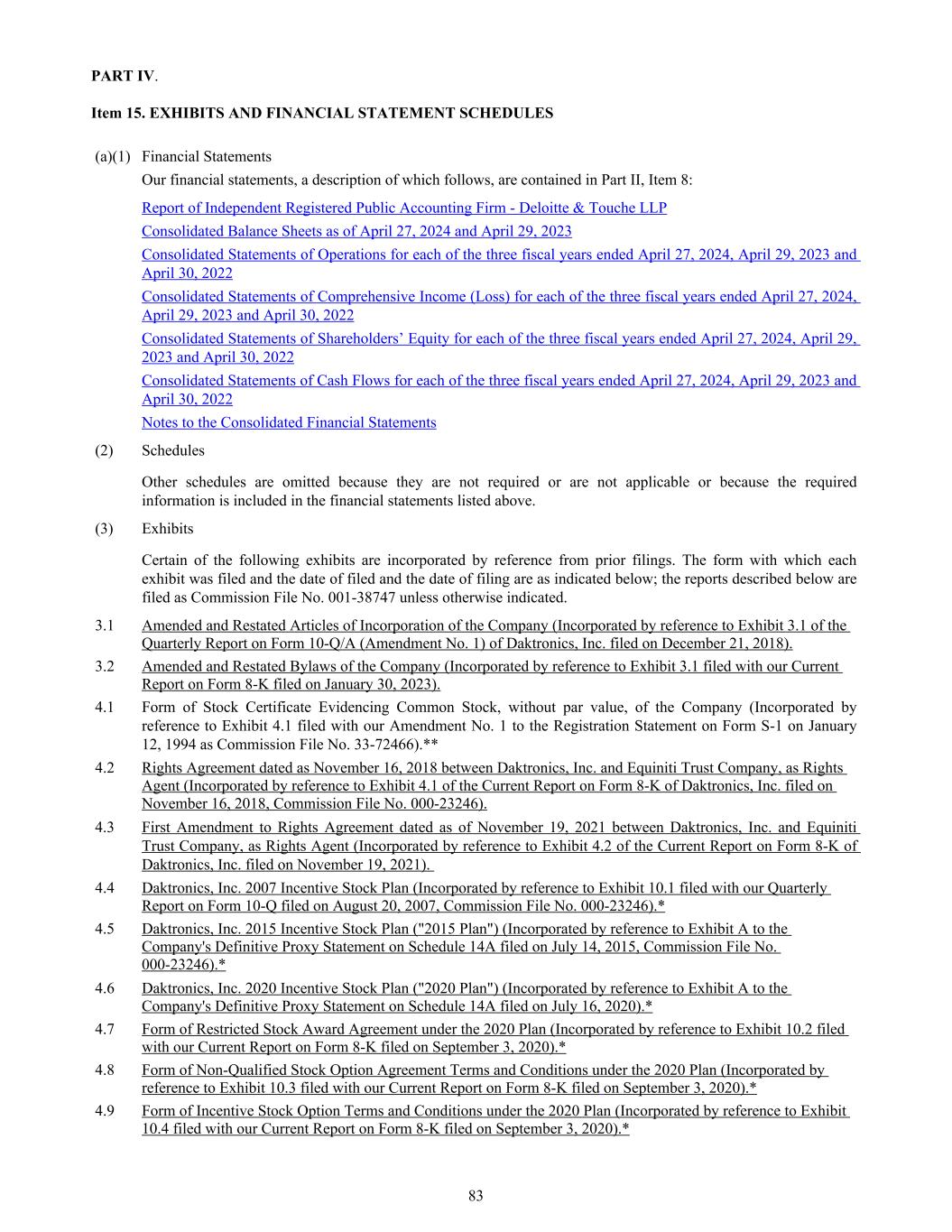
PART IV. Item 15. EXHIBITS AND FINANCIAL STATEMENT SCHEDULES (a)(1) Financial Statements Our financial statements, a description of which follows, are contained in Part II, Item 8: Report of Independent Registered Public Accounting Firm - Deloitte & Touche LLP Consolidated Balance Sheets as of April 27, 2024 and April 29, 2023 Consolidated Statements of Operations for each of the three fiscal years ended April 27, 2024, April 29, 2023 and April 30, 2022 Consolidated Statements of Comprehensive Income (Loss) for each of the three fiscal years ended April 27, 2024, April 29, 2023 and April 30, 2022 Consolidated Statements of Shareholders’ Equity for each of the three fiscal years ended April 27, 2024, April 29, 2023 and April 30, 2022 Consolidated Statements of Cash Flows for each of the three fiscal years ended April 27, 2024, April 29, 2023 and April 30, 2022 Notes to the Consolidated Financial Statements (2) Schedules Other schedules are omitted because they are not required or are not applicable or because the required information is included in the financial statements listed above. (3) Exhibits Certain of the following exhibits are incorporated by reference from prior filings. The form with which each exhibit was filed and the date of filed and the date of filing are as indicated below; the reports described below are filed as Commission File No. 001-38747 unless otherwise indicated. 3.1 Amended and Restated Articles of Incorporation of the Company (Incorporated by reference to Exhibit 3.1 of the Quarterly Report on Form 10-Q/A (Amendment No. 1) of Daktronics, Inc. filed on December 21, 2018). 3.2 Amended and Restated Bylaws of the Company (Incorporated by reference to Exhibit 3.1 filed with our Current Report on Form 8-K filed on January 30, 2023). 4.1 Form of Stock Certificate Evidencing Common Stock, without par value, of the Company (Incorporated by reference to Exhibit 4.1 filed with our Amendment No. 1 to the Registration Statement on Form S-1 on January 12, 1994 as Commission File No. 33-72466).** 4.2 Rights Agreement dated as November 16, 2018 between Daktronics, Inc. and Equiniti Trust Company, as Rights Agent (Incorporated by reference to Exhibit 4.1 of the Current Report on Form 8-K of Daktronics, Inc. filed on November 16, 2018, Commission File No. 000-23246). 4.3 First Amendment to Rights Agreement dated as of November 19, 2021 between Daktronics, Inc. and Equiniti Trust Company, as Rights Agent (Incorporated by reference to Exhibit 4.2 of the Current Report on Form 8-K of Daktronics, Inc. filed on November 19, 2021). 4.4 Daktronics, Inc. 2007 Incentive Stock Plan (Incorporated by reference to Exhibit 10.1 filed with our Quarterly Report on Form 10-Q filed on August 20, 2007, Commission File No. 000-23246).* 4.5 Daktronics, Inc. 2015 Incentive Stock Plan ("2015 Plan") (Incorporated by reference to Exhibit A to the Company's Definitive Proxy Statement on Schedule 14A filed on July 14, 2015, Commission File No. 000-23246).* 4.6 Daktronics, Inc. 2020 Incentive Stock Plan ("2020 Plan") (Incorporated by reference to Exhibit A to the Company's Definitive Proxy Statement on Schedule 14A filed on July 16, 2020).* 4.7 Form of Restricted Stock Award Agreement under the 2020 Plan (Incorporated by reference to Exhibit 10.2 filed with our Current Report on Form 8-K filed on September 3, 2020).* 4.8 Form of Non-Qualified Stock Option Agreement Terms and Conditions under the 2020 Plan (Incorporated by reference to Exhibit 10.3 filed with our Current Report on Form 8-K filed on September 3, 2020).* 4.9 Form of Incentive Stock Option Terms and Conditions under the 2020 Plan (Incorporated by reference to Exhibit 10.4 filed with our Current Report on Form 8-K filed on September 3, 2020).* 83

4.10 Form of Restricted Stock Unit Terms and Conditions under the 2020 Plan (Incorporated by reference to Exhibit 10.5 filed with our Current Report on Form 8-K filed on September 3, 2020).* 4.11 Description of the Registrant’s Securities Registered Pursuant to Section 12 of the Securities Exchange Act of 1934. (Incorporated by reference to Exhibit 4.11 files with our Annual Report on Form 10-K filed on July 12, 2023).) 10.1 Credit Agreement dated November 15, 2016 by and between the Company and U.S. Bank National Association (Incorporated by reference to Exhibit 10.1 filed with our Current Report on Form 8-K filed on November 16, 2016, Commission File No. 000-23246). 10.2 Revolving Note dated November 15, 2016 issued by the Company to U.S. Bank National Association (Incorporated by reference to Exhibit 10.2 filed with our Current Report on Form 8-K filed on November 16, 2016, Commission File No. 000-23246). 10.3 Second Amendment to Credit Agreement dated as of November 15, 2019 by and between the Company and U.S. Bank National Association (Incorporated by reference to Exhibit 10.1 filed with our Current Report on Form 8-K filed on November 15, 2019). 10.4 Third Amendment to Credit Agreement dated as of August 28, 2020 by and between the Company and U.S. Bank National Association (Incorporated by reference to Exhibit 10.4 filed with our Current Report on Form 10-Q of Daktronics, Inc. filed on August 28, 2020). 10.5 Fourth Amendment to Credit Agreement dated as of March 11, 2021 by and between the Company and U.S. Bank National Association (Incorporated by reference to Exhibit 10.5 filed with our Annual Report on Form 10-K filed on June 11, 2021). 10.6 Fifth Amendment to Credit Agreement dated as of April 29, 2022 by and between the Company and U.S. Bank National Association (Incorporated by reference to Exhibit 10.1 filed with our Current Report on Form 8-K filed on April 29, 2022). 10.7 Amendment to Credit Agreement and Revolving Note dated as of August 16, 2022 by and between the Company and U.S. Bank National Association (Incorporated by reference to Exhibit 10.1 files with our Current Report on Form 8-K filed on August 18, 2022). 10.8 Amendment to Credit Agreement and Revolving Note dated as of October 31, 2022 by and between the Company and U.S. Bank National Association (Incorporated by reference to Exhibit 10.1 filed with our Current Report on Form 8-K filed on November 1, 2022). 10.9 Sixth Amendment to Credit Agreement dated as of December 9, 2022 by and between the Company and U.S. Bank National Association (Incorporated by reference to Exhibit 10.1 filed with our Current Report on Form 8-K filed on December 13, 2022). 10.10 Seventh Amendment to Credit Agreement dated as of January 23, 2023 by and between the Company and U.S. Bank National Association (Incorporated by reference to Exhibit 10.1 filed with our Current Report on Form 8-K filed on January 25, 2023). 10.11 Security Agreement dated as of August 28, 2020 by and between the Company and U.S. Bank National Association (Incorporated by reference to Exhibit 10.5 filed with our Current Report on Form 10-Q of Daktronics, Inc. filed on August 28, 2020). 10.12 Cooperation Agreement dated July 23, 2022 by and between the Company and Prairieland Holdco, LLC (Incorporated by reference to Exhibit 10.1 filed with our Current Report on Form 8-K on July 27, 2022). 10.13 Standstill and Voting Agreement dated as of March 19, 2023 by and among Daktronics, Inc., Alta Fox Management, LLC and Connor Haley (Incorporated by reference to Exhibit 10.1 filed with the Current Report on Form 8-K of Daktronics, Inc. filed on March 20, 2023). 10.14 Credit Agreement dated as of May 11, 2023 by and among Daktronics, Inc. and the other Borrowers; the other Loan Parties to the Credit Agreement; the Lenders party to the Credit Agreement; and JPMorgan Chase Bank, N.A., in its capacity as administrative agent for the Lenders (Incorporated by reference to Exhibit 10.1 filed with the Current Report on Form 8-K of Daktronics, Inc. filed on May 12, 2023). 10.15 Pledge and Security Agreement dated as of May 11, 2023 by and among Daktronics, Inc., Daktronics Installation, Inc., and JPMorgan Chase Bank, N.A. (Incorporated by reference to Exhibit 10.2 filed with the Current Report on Form 8-K of Daktronics, Inc. filed on May 12, 2023). 10.16 Securities Purchase Agreement dated as of May 11, 2023 by and between Daktronics, Inc. and Alta Fox Opportunities Fund, LP (Incorporated by reference to Exhibit 10.3 filed with the Current Report on Form 8-K of Daktronics, Inc. filed on May 12, 2023). 84
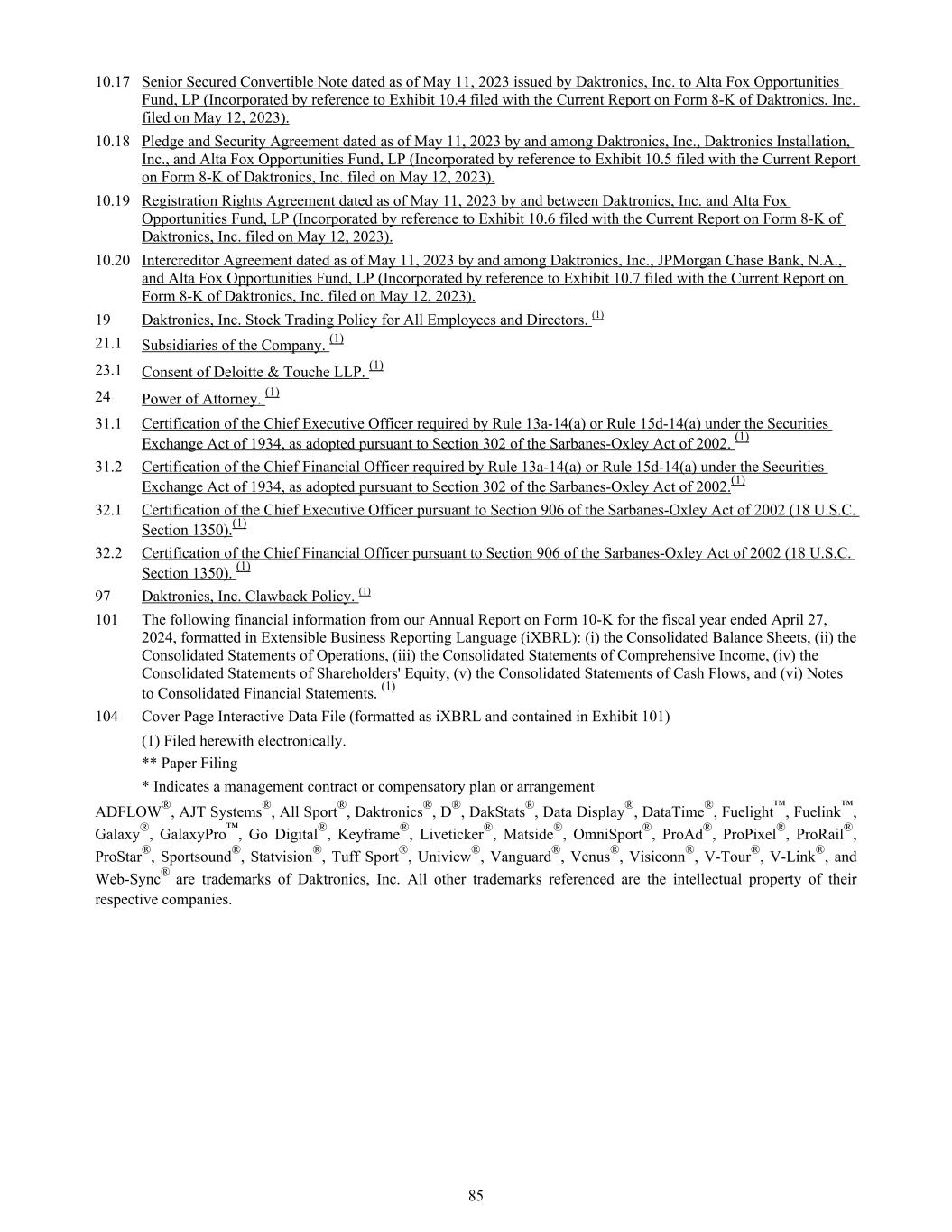
10.17 Senior Secured Convertible Note dated as of May 11, 2023 issued by Daktronics, Inc. to Alta Fox Opportunities Fund, LP (Incorporated by reference to Exhibit 10.4 filed with the Current Report on Form 8-K of Daktronics, Inc. filed on May 12, 2023). 10.18 Pledge and Security Agreement dated as of May 11, 2023 by and among Daktronics, Inc., Daktronics Installation, Inc., and Alta Fox Opportunities Fund, LP (Incorporated by reference to Exhibit 10.5 filed with the Current Report on Form 8-K of Daktronics, Inc. filed on May 12, 2023). 10.19 Registration Rights Agreement dated as of May 11, 2023 by and between Daktronics, Inc. and Alta Fox Opportunities Fund, LP (Incorporated by reference to Exhibit 10.6 filed with the Current Report on Form 8-K of Daktronics, Inc. filed on May 12, 2023). 10.20 Intercreditor Agreement dated as of May 11, 2023 by and among Daktronics, Inc., JPMorgan Chase Bank, N.A., and Alta Fox Opportunities Fund, LP (Incorporated by reference to Exhibit 10.7 filed with the Current Report on Form 8-K of Daktronics, Inc. filed on May 12, 2023). 19 Daktronics, Inc. Stock Trading Policy for All Employees and Directors. (1) 21.1 Subsidiaries of the Company. (1) 23.1 Consent of Deloitte & Touche LLP. (1) 24 Power of Attorney. (1) 31.1 Certification of the Chief Executive Officer required by Rule 13a-14(a) or Rule 15d-14(a) under the Securities Exchange Act of 1934, as adopted pursuant to Section 302 of the Sarbanes-Oxley Act of 2002. (1) 31.2 Certification of the Chief Financial Officer required by Rule 13a-14(a) or Rule 15d-14(a) under the Securities Exchange Act of 1934, as adopted pursuant to Section 302 of the Sarbanes-Oxley Act of 2002.(1) 32.1 Certification of the Chief Executive Officer pursuant to Section 906 of the Sarbanes-Oxley Act of 2002 (18 U.S.C. Section 1350).(1) 32.2 Certification of the Chief Financial Officer pursuant to Section 906 of the Sarbanes-Oxley Act of 2002 (18 U.S.C. Section 1350). (1) 97 Daktronics, Inc. Clawback Policy. (1) 101 The following financial information from our Annual Report on Form 10-K for the fiscal year ended April 27, 2024, formatted in Extensible Business Reporting Language (iXBRL): (i) the Consolidated Balance Sheets, (ii) the Consolidated Statements of Operations, (iii) the Consolidated Statements of Comprehensive Income, (iv) the Consolidated Statements of Shareholders' Equity, (v) the Consolidated Statements of Cash Flows, and (vi) Notes to Consolidated Financial Statements. (1) 104 Cover Page Interactive Data File (formatted as iXBRL and contained in Exhibit 101) (1) Filed herewith electronically. ** Paper Filing * Indicates a management contract or compensatory plan or arrangement ADFLOW®, AJT Systems®, All Sport®, Daktronics®, D®, DakStats®, Data Display®, DataTime®, Fuelight™, Fuelink™, Galaxy®, GalaxyPro™, Go Digital®, Keyframe®, Liveticker®, Matside®, OmniSport®, ProAd®, ProPixel®, ProRail®, ProStar®, Sportsound®, Statvision®, Tuff Sport®, Uniview®, Vanguard®, Venus®, Visiconn®, V-Tour®, V-Link®, and Web-Sync® are trademarks of Daktronics, Inc. All other trademarks referenced are the intellectual property of their respective companies. 85

Item 16. FORM 10-K SUMMARY None. 86
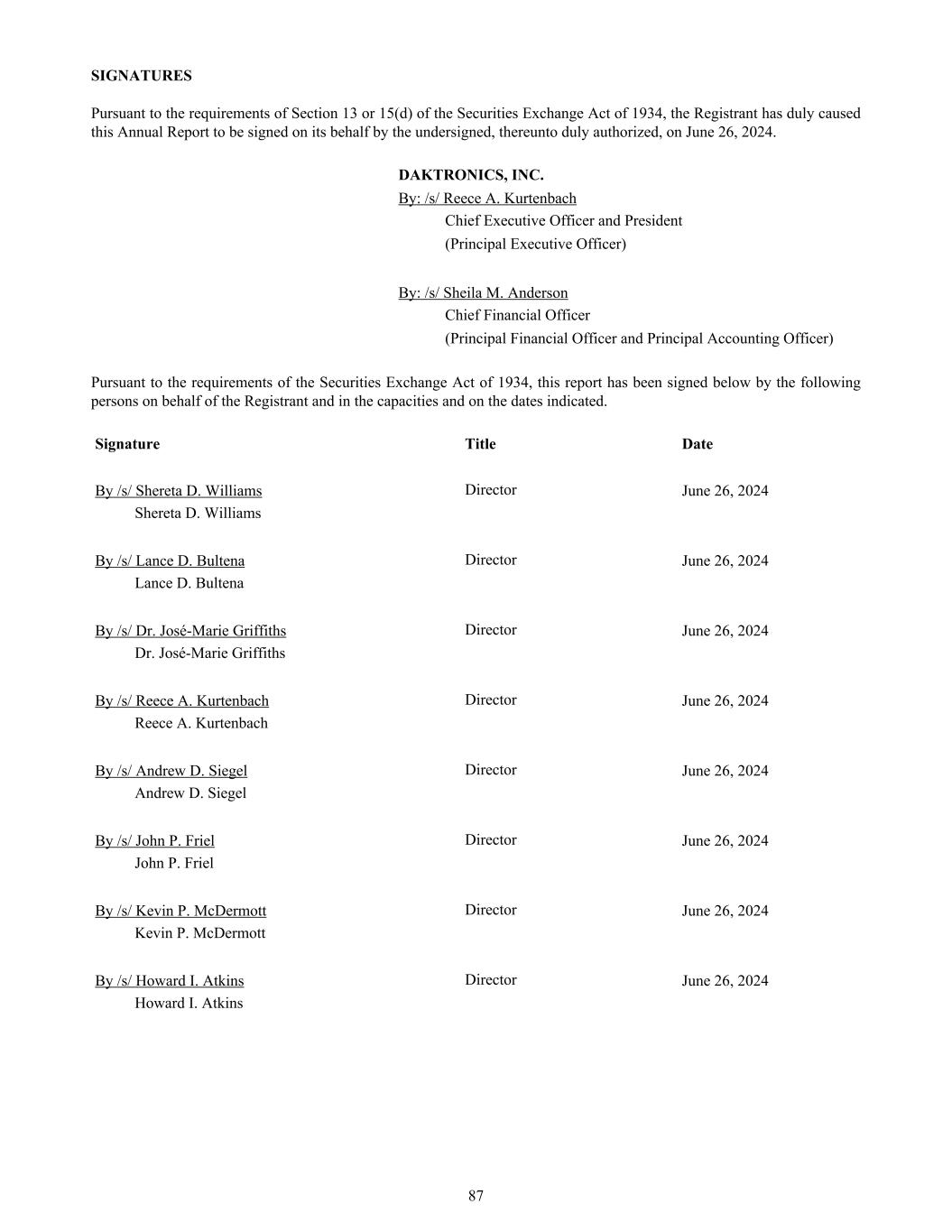
SIGNATURES Pursuant to the requirements of Section 13 or 15(d) of the Securities Exchange Act of 1934, the Registrant has duly caused this Annual Report to be signed on its behalf by the undersigned, thereunto duly authorized, on June 26, 2024. DAKTRONICS, INC. By: /s/ Reece A. Kurtenbach Chief Executive Officer and President (Principal Executive Officer) By: /s/ Sheila M. Anderson Chief Financial Officer (Principal Financial Officer and Principal Accounting Officer) Pursuant to the requirements of the Securities Exchange Act of 1934, this report has been signed below by the following persons on behalf of the Registrant and in the capacities and on the dates indicated. Signature Title Date By /s/ Shereta D. Williams Director June 26, 2024 Shereta D. Williams By /s/ Lance D. Bultena Director June 26, 2024 Lance D. Bultena By /s/ Dr. José-Marie Griffiths Director June 26, 2024 Dr. José-Marie Griffiths By /s/ Reece A. Kurtenbach Director June 26, 2024 Reece A. Kurtenbach By /s/ Andrew D. Siegel Director June 26, 2024 Andrew D. Siegel By /s/ John P. Friel Director June 26, 2024 John P. Friel By /s/ Kevin P. McDermott Director June 26, 2024 Kevin P. McDermott By /s/ Howard I. Atkins Director June 26, 2024 Howard I. Atkins 87
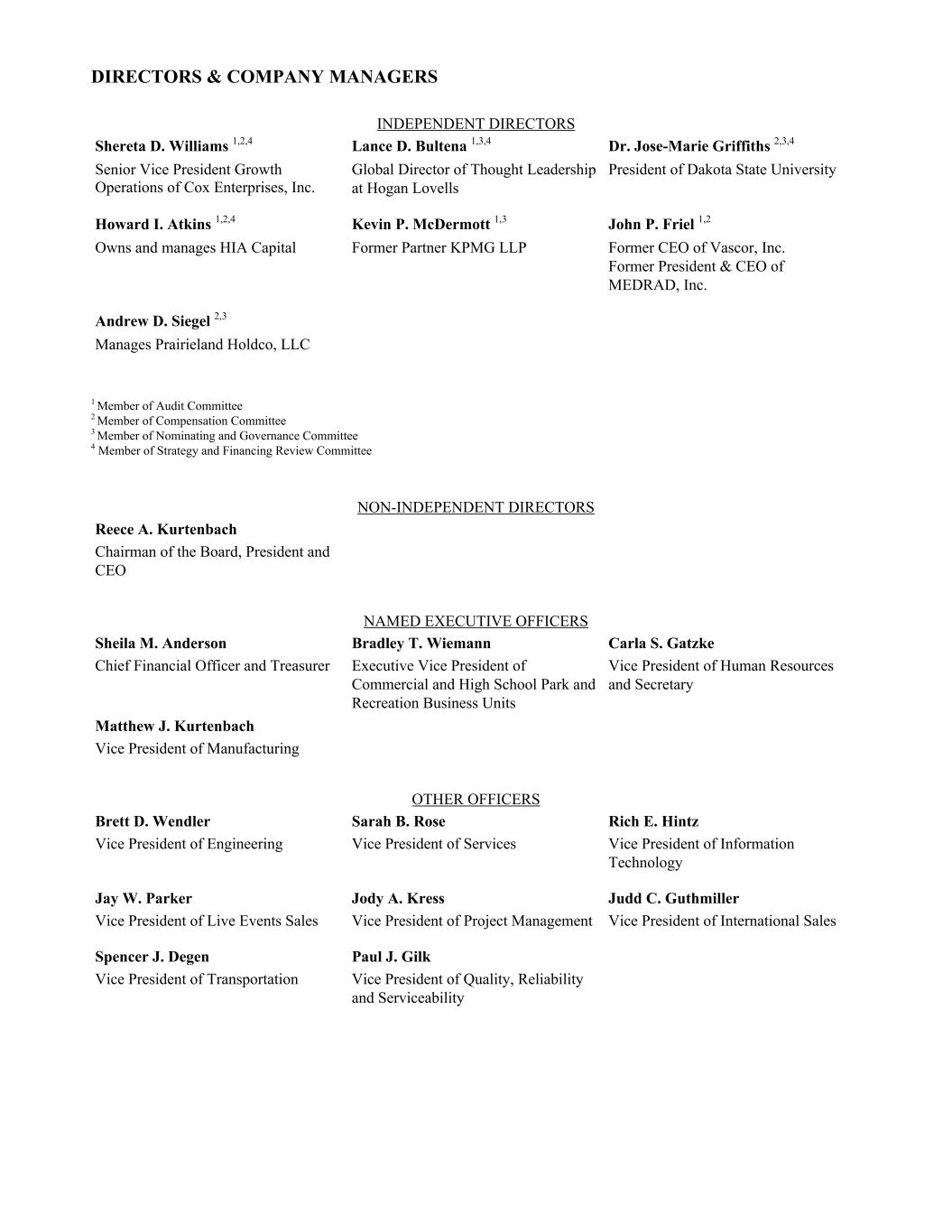
DIRECTORS & COMPANY MANAGERS INDEPENDENT DIRECTORS Shereta D. Williams 1,2,4 Lance D. Bultena 1,3,4 Dr. Jose-Marie Griffiths 2,3,4 Senior Vice President Growth Operations of Cox Enterprises, Inc. Global Director of Thought Leadership at Hogan Lovells President of Dakota State University Howard I. Atkins 1,2,4 Kevin P. McDermott 1,3 John P. Friel 1,2 Owns and manages HIA Capital Former Partner KPMG LLP Former CEO of Vascor, Inc. Former President & CEO of MEDRAD, Inc. Andrew D. Siegel 2,3 Manages Prairieland Holdco, LLC 1 Member of Audit Committee 2 Member of Compensation Committee 3 Member of Nominating and Governance Committee 4 Member of Strategy and Financing Review Committee NON-INDEPENDENT DIRECTORS Reece A. Kurtenbach Chairman of the Board, President and CEO NAMED EXECUTIVE OFFICERS Sheila M. Anderson Bradley T. Wiemann Carla S. Gatzke Chief Financial Officer and Treasurer Executive Vice President of Commercial and High School Park and Recreation Business Units Vice President of Human Resources and Secretary Matthew J. Kurtenbach Vice President of Manufacturing OTHER OFFICERS Brett D. Wendler Sarah B. Rose Rich E. Hintz Vice President of Engineering Vice President of Services Vice President of Information Technology Jay W. Parker Jody A. Kress Judd C. Guthmiller Vice President of Live Events Sales Vice President of Project Management Vice President of International Sales Spencer J. Degen Paul J. Gilk Vice President of Transportation Vice President of Quality, Reliability and Serviceability

INVESTOR INFORMATION ANNUAL MEETING September 4, 2024, 4:30pm Central Daylight Time Daktronics, Inc. 201 Daktronics Drive Brookings, South Dakota Shareholders of record on July 8, 2024 will be eligible to vote at the meeting. STOCK TRANSFER AGENT & REGISTRAR Equiniti Trust Company (Formerly Wells Fargo Bank, N.A.) EQ Shareowner Services PO Box 64874 St. Paul, MN 55164-0874 Or Overnight Mail: 1110 Centre Pointe Curve, Suite 101 Mendota Heights, MN 55120 INQUIRIES & INFORMATION Daktronics, Inc. Investor Relations PO Box 5128 Brookings, SD 57006 800-468-9716 www.shareowneronline.com Website: www.daktronics.com Email: investor@daktronics.com Phone: 605-692-0200 Fax: 605-697-4700 INDEPENDENT REGISTERED PUBLIC ACCOUNTING FIRM Deloitte & Touche, LLP Minneapolis, Minnesota LEGAL COUNSEL Winthrop & Weinstine, P.A., Minneapolis, Minnesota Cautionary Notice Regarding Forward-Looking Statements: This Annual Report on Form 10-K (including exhibits and any information incorporated by reference herein) (the "Form 10-K" or the "Report") contains both historical and forward-looking statements that involve risks, uncertainties and assumptions. The statements contained in this Report that are not purely historical are forward-looking statements within the meaning of Section 27A of the Securities Act of 1933, as amended, and Section 21B of the Securities Exchange Act of 1934, as amended, including statements regarding our expectations, beliefs, intentions and strategies for the future. These statements appear in a number of places in this Report and include all statements that are not historical statements of fact regarding the intent, belief or current expectations with respect to, among other things: (i.) our competition; (ii.) our financing plans and ability to maintain adequate liquidity; (iii.) trends affecting our financial condition or results of operations; (iv.) our growth and operating strategies; (v.) the declaration and payment of dividends; (vi.) the timing and magnitude of future contracts; (vii.) raw material shortages and lead times and supply chain disruptions; (viii.) fluctuations in margins; (ix.) the seasonality of our business; (x.) the introduction of new products and technology; (xi.) the amount and frequency of warranty claims; (xii.) our ability to manage the impact that new or adjusted tariffs may have on the cost of raw materials and components and our ability to sell product internationally; (xiii.) the resolution of litigation contingencies; (xiv.) the timing and magnitude of any acquisitions or dispositions; (xv.) the impact of governmental laws, regulations, and orders, including as a result of the COVID-19 pandemic caused by the coronavirus; (xvi) disruptions to our business caused by geopolitical events, military actions, work stoppages, natural disasters, or international health emergencies, such as the COVID-19 pandemic; (xvii) uncertainties related to market conditions and entry into financing transactions; (xviii) the Company’s potential need to seek additional strategic alternatives, including seeking additional debt or equity capital or other strategic transactions and/or measures; (xix) our financing plans and ability to maintain adequate liquidity; (xx) the Company’s ability to increase cash flow to support the Company’s operating activities and fund its obligations and working capital needs; (xxi) our ability to obtain additional financing on terms favorable to us, or at all; (xxii) any future goodwill impairment charges; and (xxiii) the valuation of investment in and advances to affiliates. The words “may,” “would,” “could,” “should,” “will,” “expect,” “estimate,” “anticipate,” “believe,” “intend,” “plan” and similar expressions and variations thereof are intended to identify forward-looking statements. Investors are cautioned that any such forward-looking statements are not guarantees of future performance and involve risks and uncertainties, many of which are beyond our ability to control, and that actual results may differ materially from those projected in the forward-looking statements as a result of various factors discussed herein, including those discussed in the section of this Form 10-K entitled “Part I, Item 1A. Risk Factors” and “Part II, Item 7. Management’s Discussion and Analysis of Financial Condition and Results of Operations,” and those factors discussed in detail in our other filings with the Securities and Exchange Commission. Copyright © 2024 Daktronics, Inc.

(This page has been left blank intentionally.)




































































































